Inbox and environment news: Issue 555
September 18 - 24, 2022: Issue 555
Channel-Billed Cuckoos Return
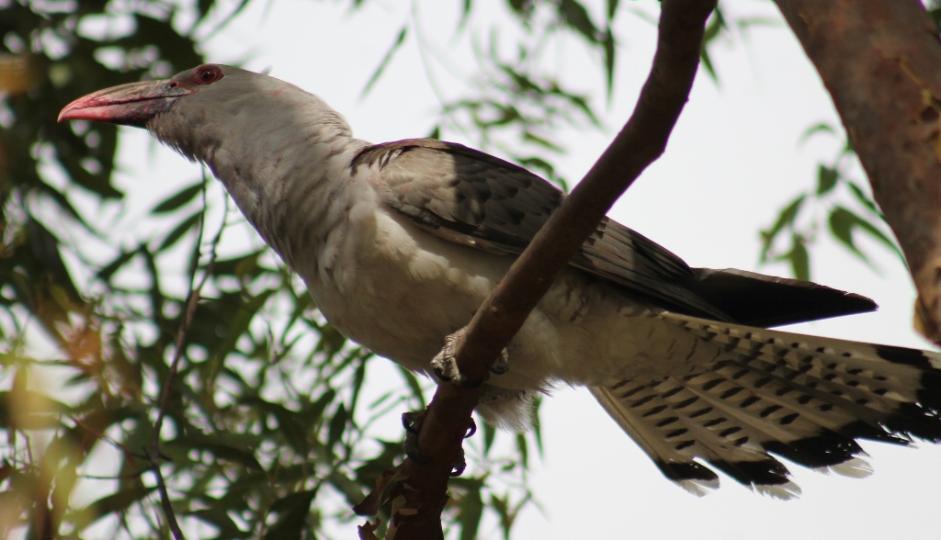
Weed Alert: Corky Passionflower At Mona Vale + Narrabeen Creek
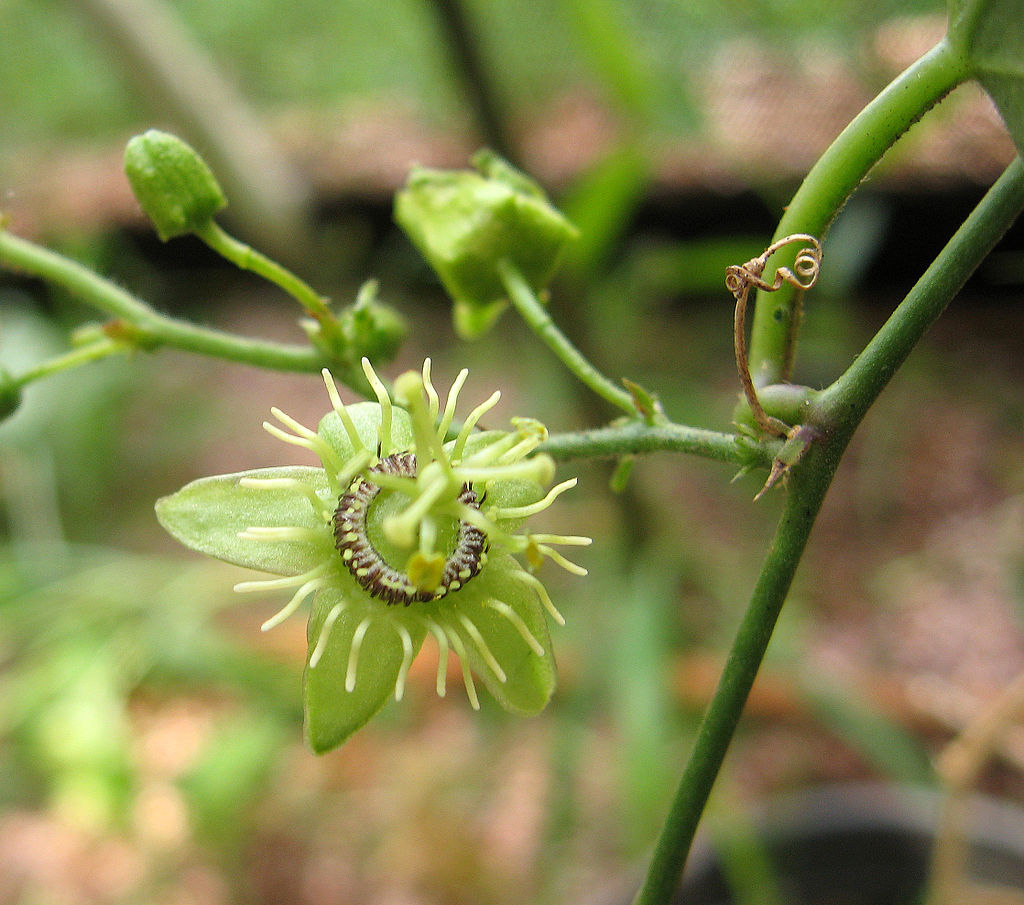
.jpg?timestamp=1663392221562)
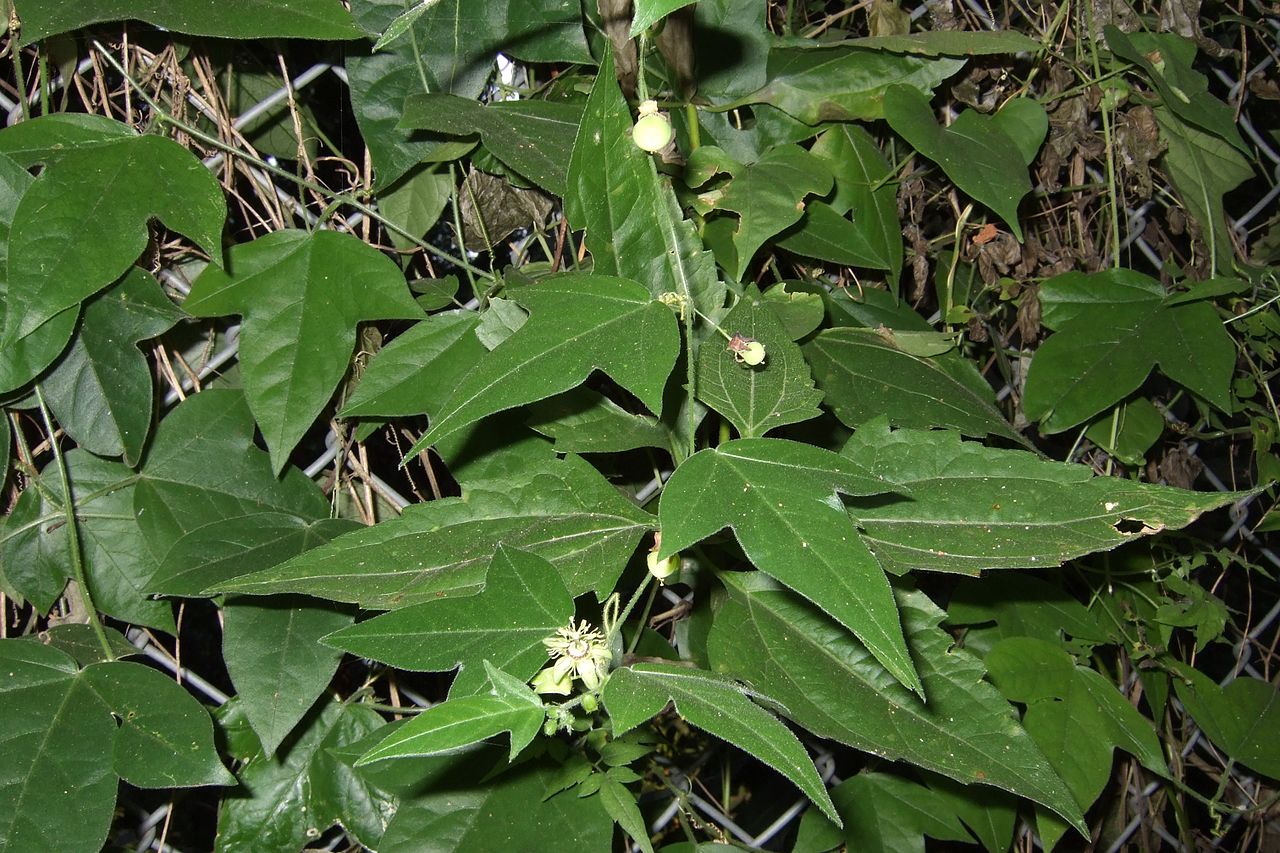
La Nina Event Declared - Above Average Rainfall Likely For Eastern Australia
Flood Warning - Peel And Namoi Rivers
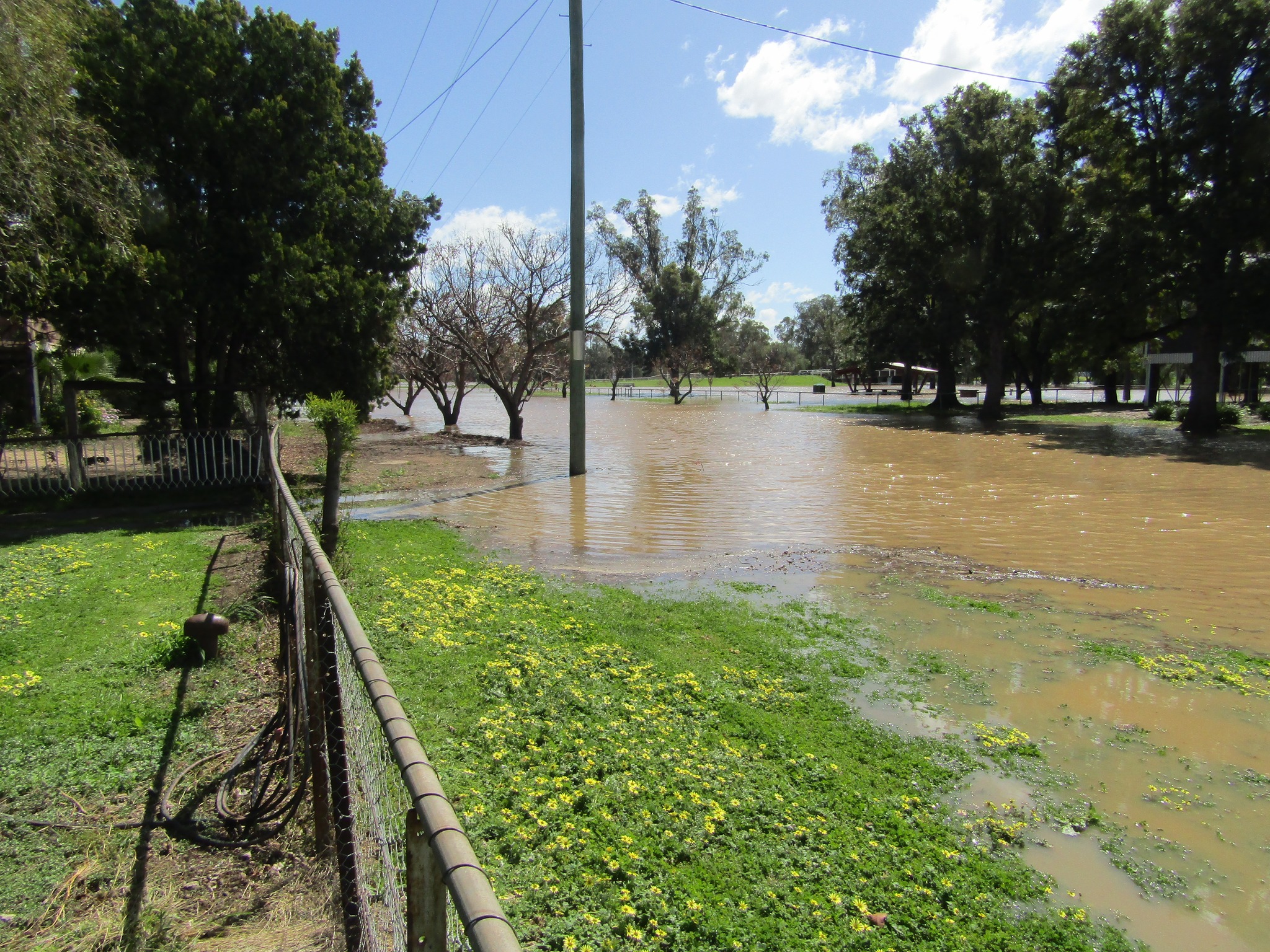
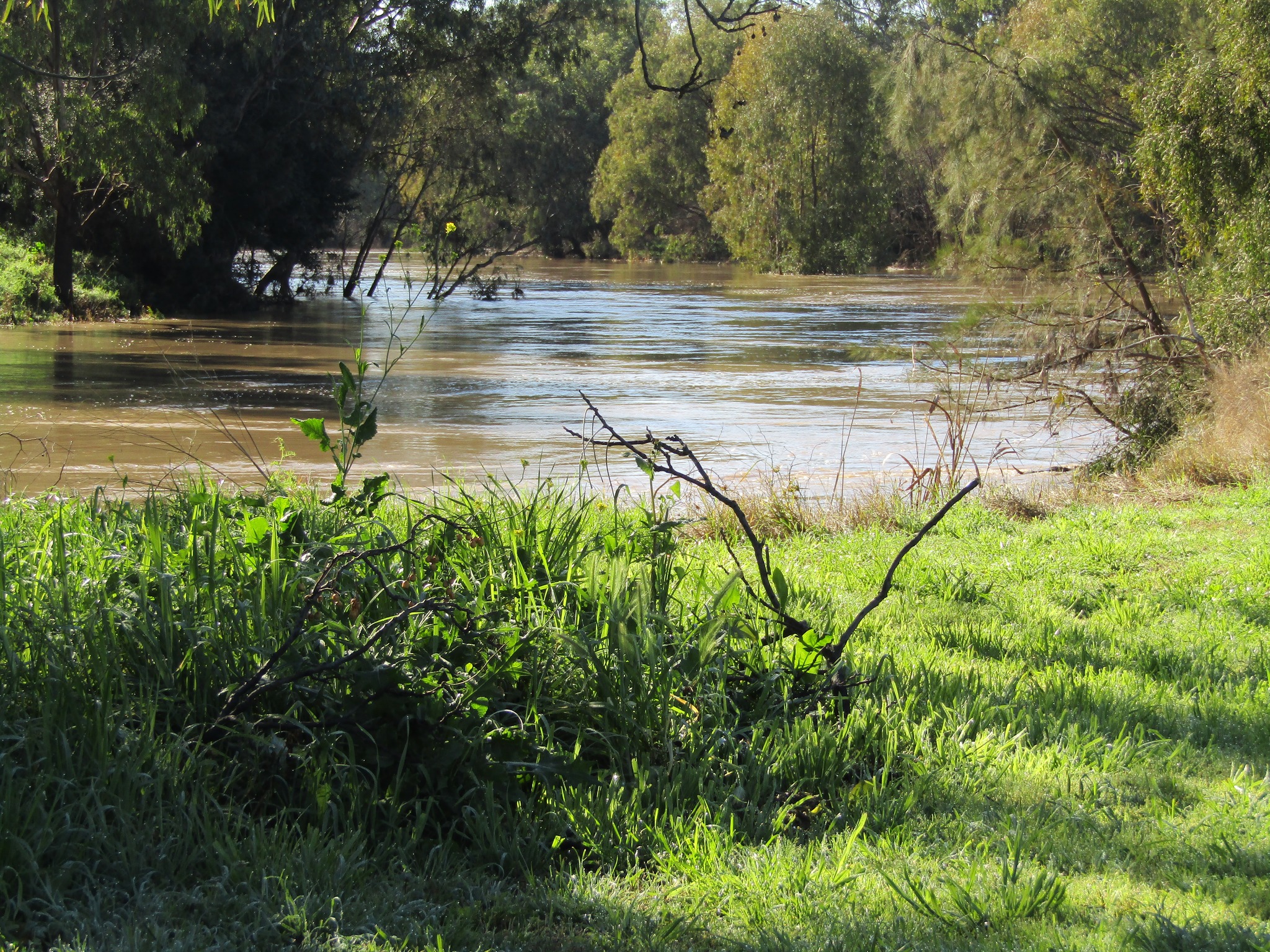
Wakehurst Parkway Closed Due To Flooding
''OXFORD FALLS: Both directions closed on the Wakehurst Pkwy between the Academy Of Sport & Dreadnought Rd due to flooding. Use Pittwater and Warringah Rds instead.
6:56am: UPDATE: Wakehurst Pkwy has reopened in both directions following earlier flooding.
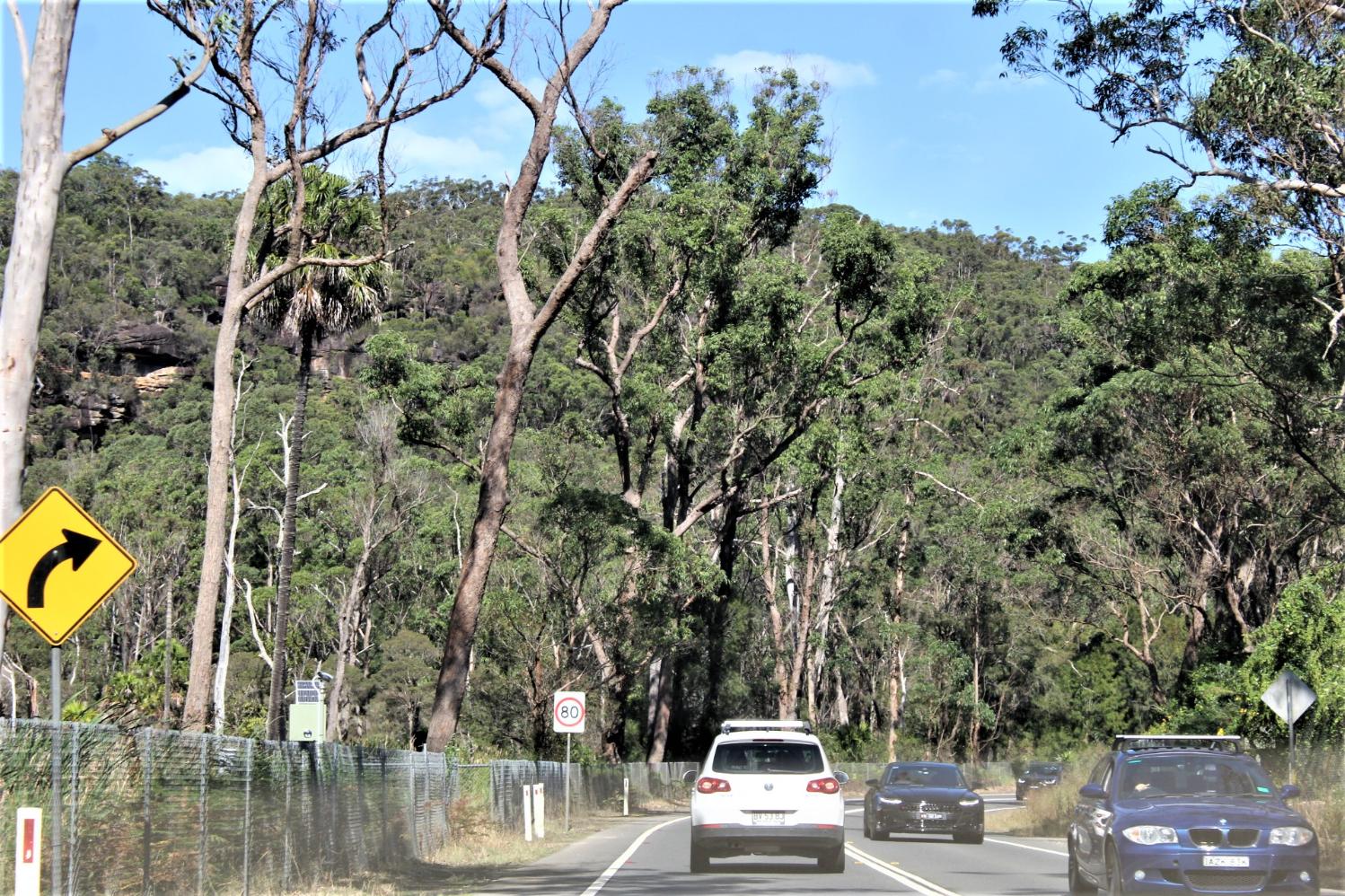
Manly Lagoon Friends September Clean Up Nets A Heap Of Rubbish
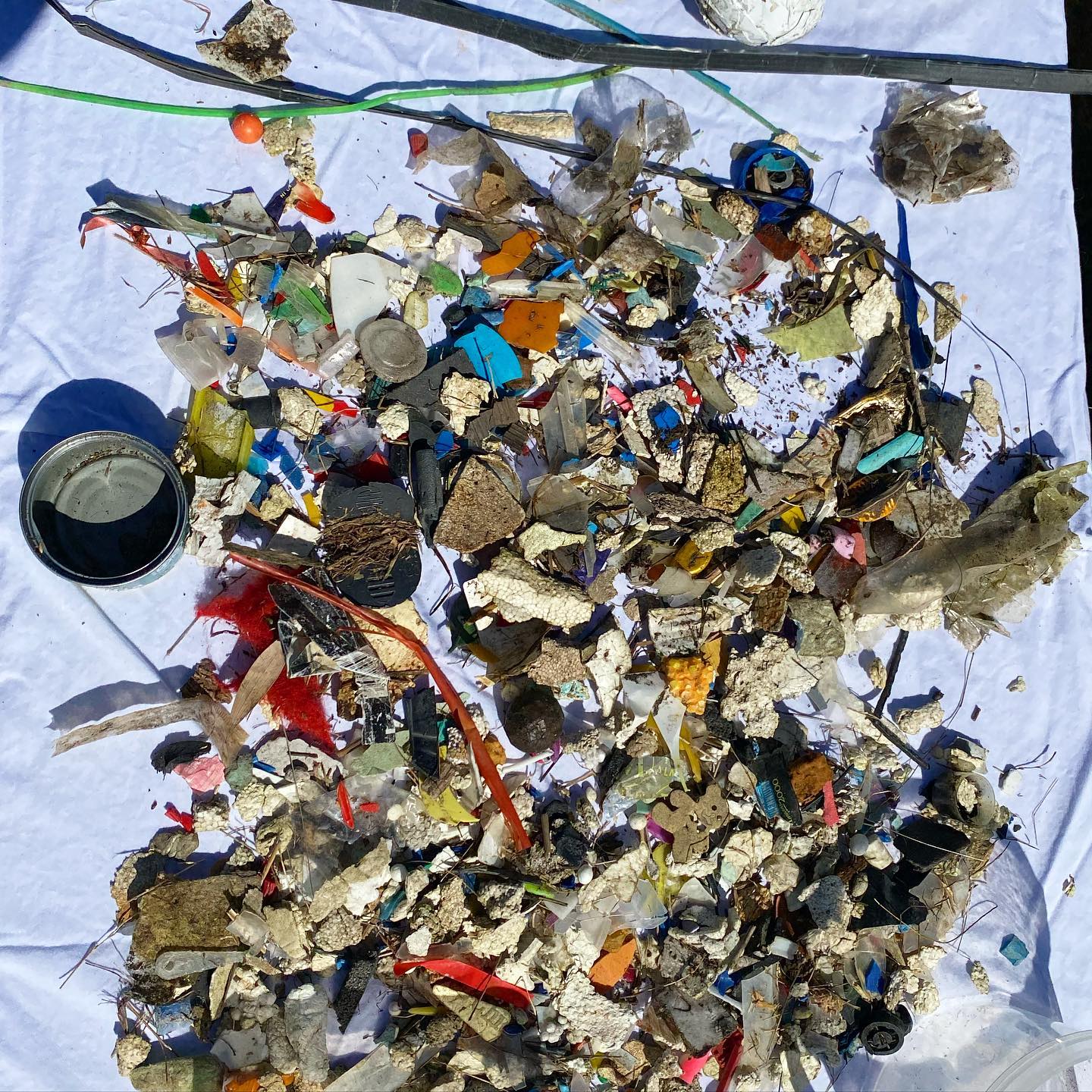
Northern Beaches Clean Up Crew: Clontarf September 25
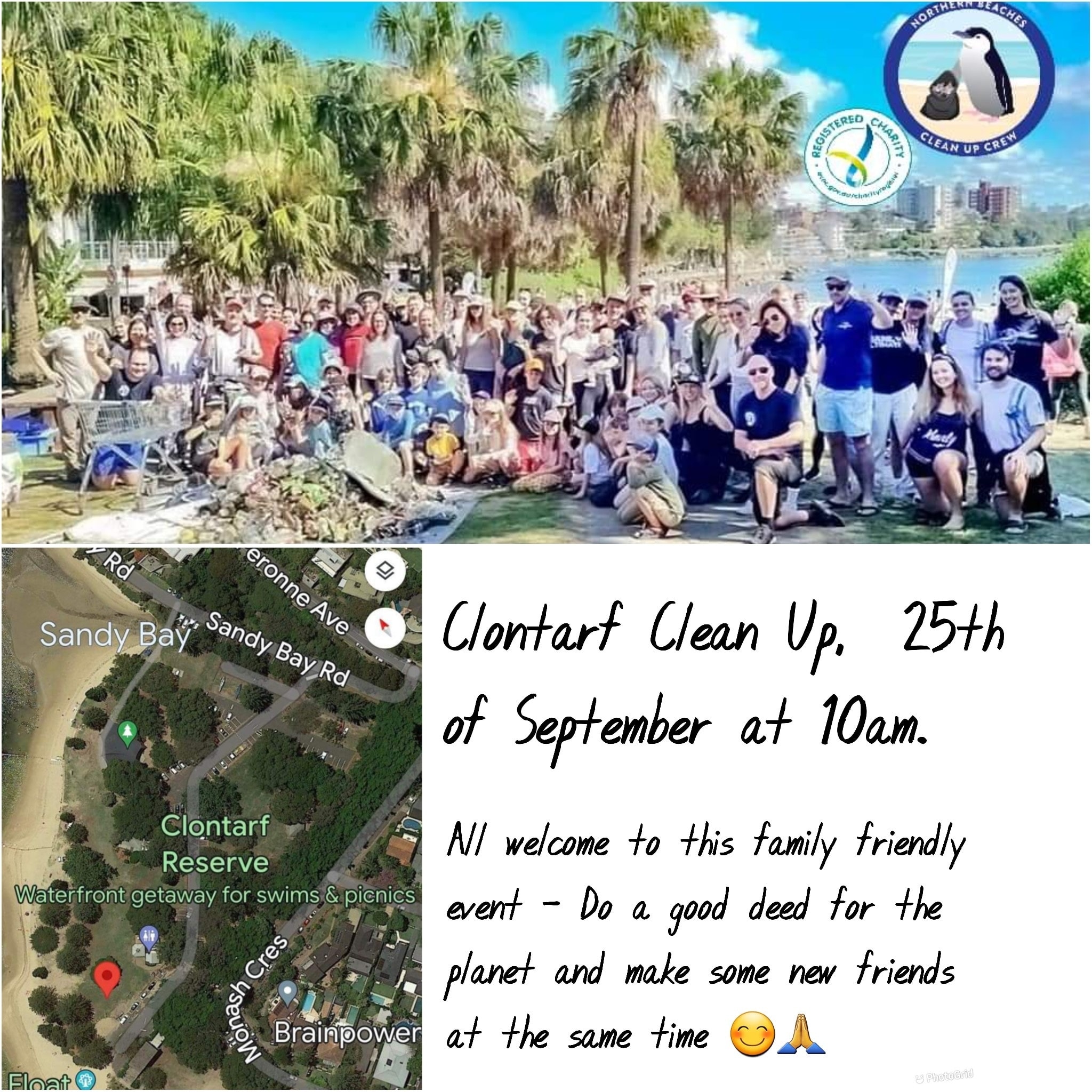
Katandra Bushland Sanctuary Open
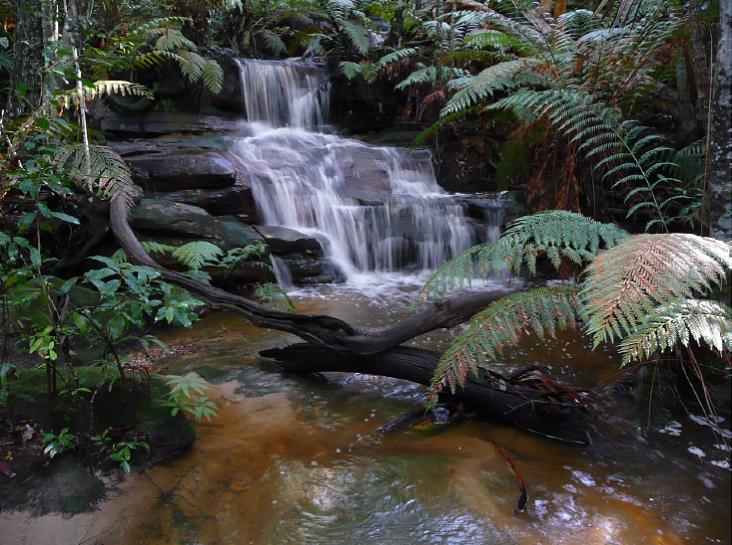
Ku-Ring-Gai Sculpture Trail For 2022 Eco Festival
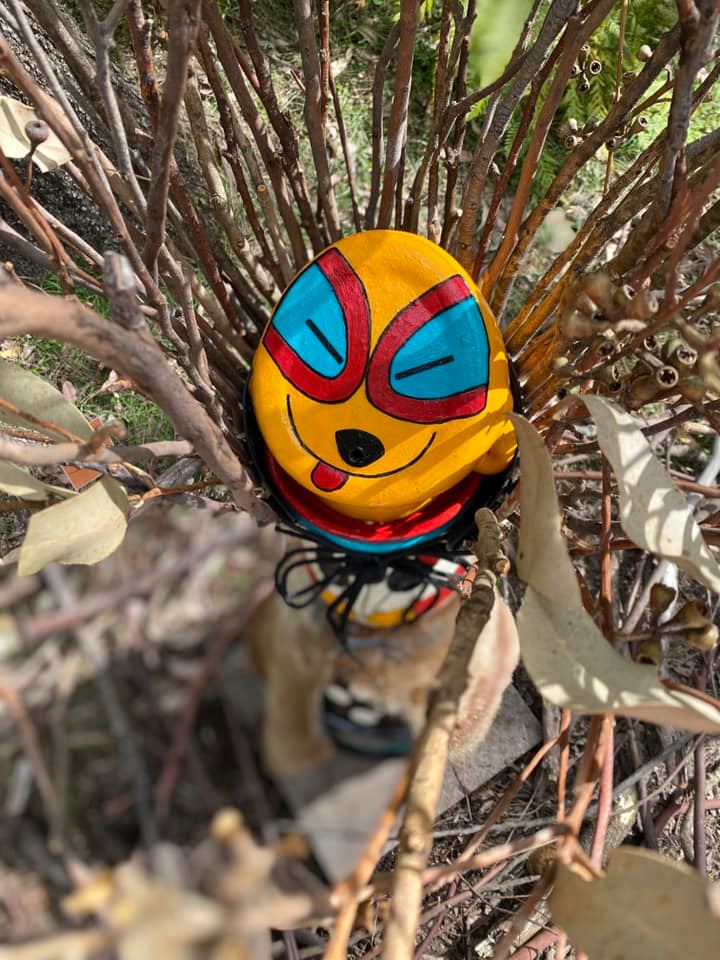

Sydney Cockatoos And Humans Are In An Arms Race Over Garbage Access
September 12, 2022
Residents of southern Sydney, Australia have been in a long-term battle over garbage -- humans want to throw it out, and cockatoos want to eat it. The sulphur-crested cockatoos that call the area home have a knack for getting into garbage bins, and people have been using inventive devices to keep them out. Researchers detail the techniques used by both people and parrots in a study publishing on September 12 in the journal Current Biology.
"When I first saw a video of the cockatoos opening the bins I thought it was such an interesting and unique behaviour and I knew we needed to look into it," says lead author Barbara Klump, a behavioural ecologist at the Max Planck Institute of Animal Behaviour.
The cockatoos' motivation is food waste. "They really like bread," she says. "Once one gets a bin open all the cockatoos in the vicinity will come and try to get something nice to eat."
The birds typically pry the bins open with their beaks and then manoeuvre themselves onto a small rim and flip the lid open. It's a community affair. "We could actually show that this is a cultural trait," says Klump. "The cockatoos learn the behaviour from observing other cockatoos and within each group they sort of have their own special technique, so across a wide geographic range the techniques are more dissimilar."
Human residents trying to keep the cockatoos out can't simply secure the bin lids completely closed because the lids need to open when tipped by an automated arm on the garbage truck. A survey given by the researchers found that people put bricks and stones on their bin lids, strap water bottles to the top, rig ropes to prevent the lid from flipping, use sticks to block the hinges, and switch tactics once the cockatoos figure them out. "There are even commercially available cockatoo locks for bins," says Klump.
"It's not just a social learning on the cockatoo side, but it's also social learning on the human side," she says. "People come up with new protection methods on their own, but a lot of people actually learn it from their neighbours or people on their street, so they get their inspiration from someone else."
Klump won't say who she expects to win the race for control of the bins, but she and her colleagues plan to look at how the cockatoos' behaviour varies from season to season.
Klump expects we will see more of these kinds of human-wildlife interactions in the future. "As cities expand, we will have more interactions with wildlife," she says. "I'm hoping that there will be a better understanding and more tolerance for the animals that we share our lives with."
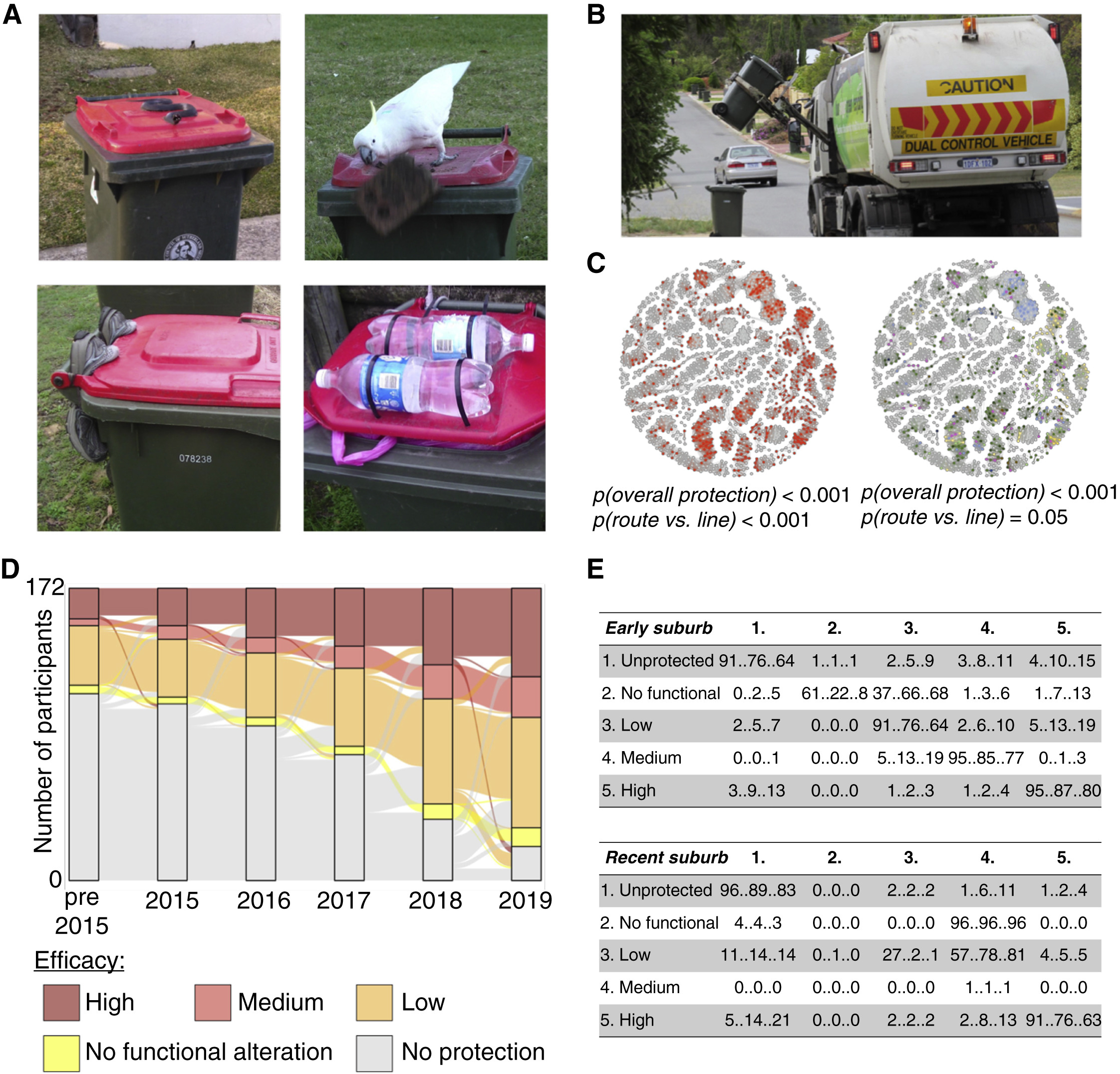
(A) Examples of protection devices (left to right, top to bottom): a snake to scare away cockatoos (level 2 – no functional alteration to the bin), a cockatoo removing a brick from a general household waste bin (level 3 – unfixed object to prevent lifting; low efficacy), shoes between hinges to avoid full flipping of the lid (level 4 – object to prevent flipping; medium efficacy), full water bottles tied to the lid (level 5 – fixed alteration to prevent opening; high efficacy). (B) A household waste bin being emptied by a garbage truck. Photo: Andrew Owens/Wikicommons (CC-BY-SA.3.0). (C) Spatial distribution of bin-protection devices in Helensburgh (protection level: 33%, n = 1312) based on: (i) overall protection: binary yes (red)/ no (grey), (ii) clusters (for colour scheme see Figure S1). Given are p-values for assortment and for comparison of street vs. direct line-of-sight distance (route vs. line). For results from all four suburbs see Figure S1. (D) Change in efficacy of bin-protection devices over time. Of 1134 survey participants, 172 protected their bins at some point and are displayed here. (E) Changes in transition probabilities across the five levels of bin protection over 1, 3 and 5 years for each area (represented by the first, second and third number in each cell, respectively). Top shows transition probabilities for ‘early’ suburbs where cockatoos already opened bins for at least 3 years, bottom shows ‘recent’ suburb where bin-opening has emerged in the last 3 months).
Barbara C. Klump, Richard E. Major, Damien R. Farine, John M. Martin, Lucy M. Aplin. Is bin-opening in cockatoos leading to an innovation arms race with humans? Current Biology, 2022; 32 (17): R910 DOI: 10.1016/j.cub.2022.08.008
Dust Off Your Picnic Blankets For The First Ever Statewide Picnic For Nature
Echidna 'Love Train' Season Commences
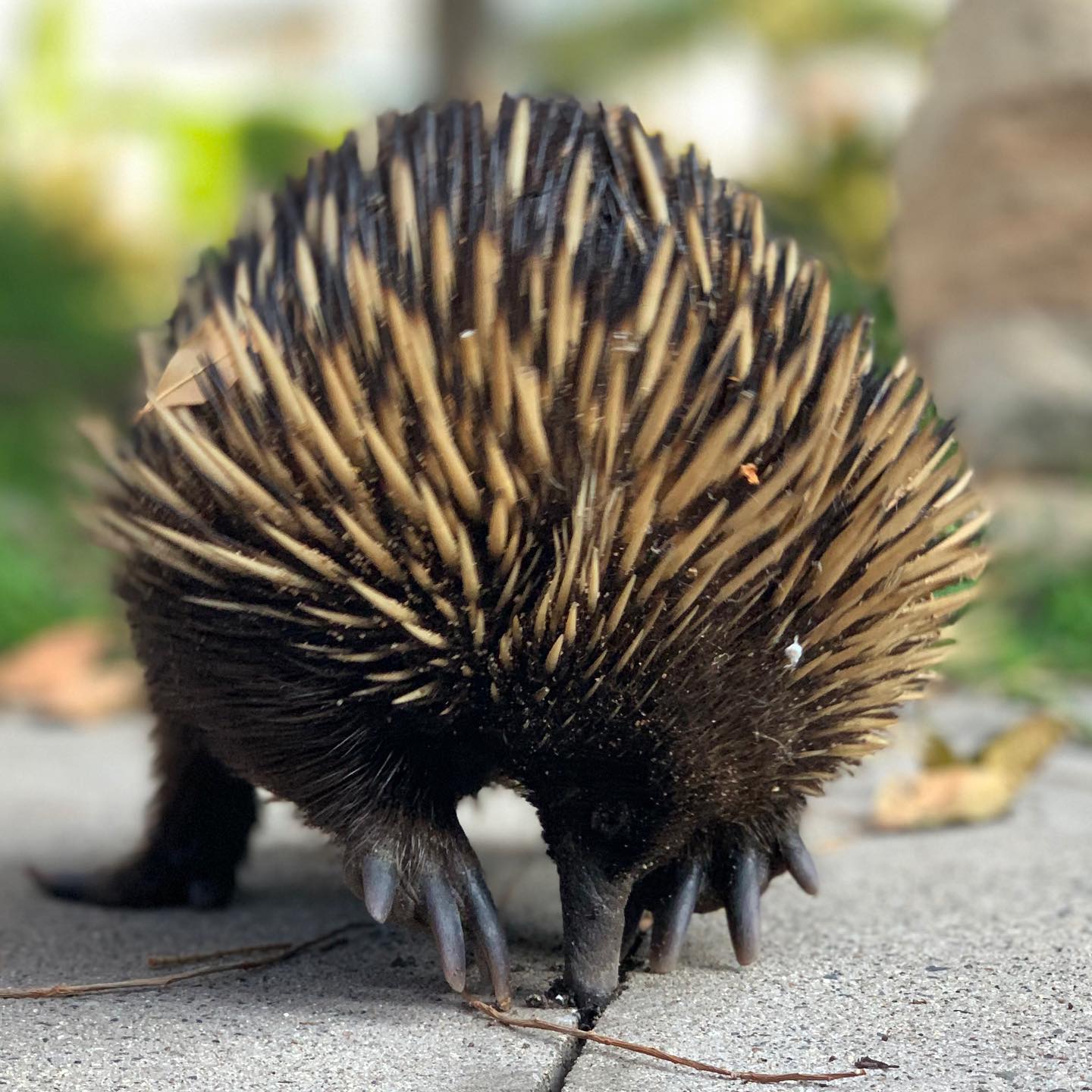
EPA Releases Climate Change Policy And Action Plan
September 8, 2022
The NSW Environment Protection Authority (EPA) is taking action to protect the environment and community from the impacts of climate change, today releasing its new draft Climate Change Policy and Action Plan which works with industry, experts and the community to reduce greenhouse gas emissions and support resilience.
NSW EPA Chief Executive Officer Tony Chappel said the EPA has proposed a set of robust actions to achieve a 50 per cent reduction in carbon emissions by 2030 (from 2005 levels), ensure net zero emissions by 2050, and improve resilience to climate change impacts.
“NSW has ambitious targets that align with the world’s best scientific advice and the Paris commitments, to limit global warming to an average of 1.5 degrees in order to avoid severe impacts on ecosystems,” Mr Chappel said.
“Over the past few years we have seen first-hand just how destructive the impacts of climate change are becoming, not only for our environment, but for NSW communities too.
“We know the EPA has a critical role to play in achieving the NSW Government’s net-zero targets and responding to the increasing threat of climate change induced weather events.
“Equally, acting on climate presents major economic opportunities for NSW in new industries such as clean energy, hydrogen, green metals, circular manufacturing, natural capital and regenerative agriculture.
“This draft Policy sends a clear signal to regulated industries that we will be working with them to support and drive cost-effective decarbonisation while implementing adaptation initiatives that build resilience to climate change risks.
“Our draft plan proposes a staged approach that ensures the actions the EPA takes are deliberate, well informed and complement government and industry actions on climate change. These actions will support industry and allow reasonable time for businesses to plan for and meet any new targets or requirements.
“Climate change is an issue that we all face so it’s important that we take this journey together and all play our part in protecting our environment and communities for generations to come.”
Actions include:
- working with industry, government and experts to improve the evidence base on climate change
- supporting licensees prepare, implement and report on climate change mitigation and adaptation plans
- partnering with NSW Government agencies to address climate change during the planning and assessment process for activities the EPA regulates
- establishing cost-effective emission reduction targets for key industry sectors
- providing industry best-practice guidelines to support them to reduce their greenhouse gas emissions
- phasing in the introduction of greenhouse gas emission limits on environment protection licences for key industry sectors
- developing and implementing resilience programs, best-practice adaptation guidance and harnessing citizen science and education programs
- working with EPA Aboriginal and Youth Advisory Committees to improve the EPA’s evolving climate change response
EPA Acting Chair Carolyn Walsh said the EPA is a partner in supporting and building on the NSW Government’s work to address climate change for the people of NSW.
“The draft Policy and Action Plan adopts, supports and builds on the strong foundations that have been set by the NSW Government through the NSW Climate Change Policy Framework, Net Zero Plan and Climate Change Adaptation Strategy,” Ms Walsh said.
The EPA will work with stakeholders, including licensees, councils, other government agencies, and the community to help implement the actions.
The draft EPA Climate Change Policy and Action Plan is available at https://yoursay.epa.nsw.gov.au/ and comments are open until 3 November 2022.
Wanted: Photos Of Flies Feeding On Frogs (For Frog Conservation)
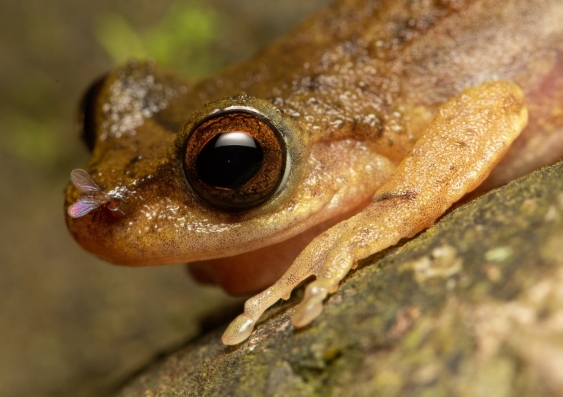
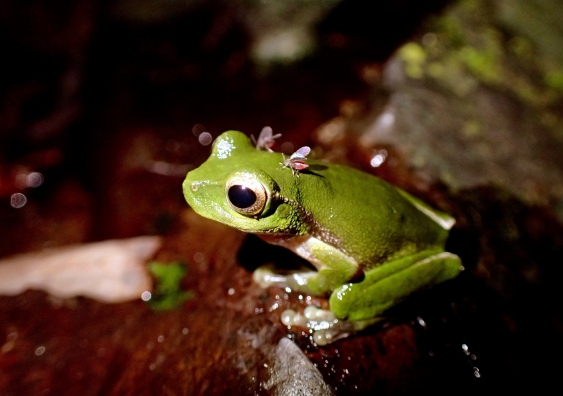
Possums In Your Roof?: Do The Right Thing

Local Wildlife Rescuers And Carers State That Ongoing Heavy Rains Are Tough For Us But Can Be Tougher For Our Wildlife:
- Birds and possums can be washed out of trees, or the tree comes down, nests can disintegrate or hollows fill with water
- Ground dwelling animals can be flooded out of their burrows or hiding places and they need to seek higher ground
- They are at risk crossing roads as people can't see them and sudden braking causes accidents
- The food may disappear - insects, seeds and pollens are washed away, nectar is diluted and animals can be starving
- They are vulnerable in open areas to predators, including our pets
- They can't dry out and may get hypothermia or pneumonia
- Animals may seek shelter in your home or garage.
You can help by:
- Keeping your pets indoors
- Assessing for wounds or parasites
- Putting out towels or shelters like boxes to provide a place to hide
- Drive to conditions and call a rescue group if you see an animal hit (or do a pouch check or get to a vet if you can stop)
- If you are concerned take a photo and talk to a rescue group or wildlife carer
There are 2 rescue groups in the Northern Beaches:
Sydney Wildlife: 9413 4300
WIRES: 1300 094 737
Please be patient as there could be a few enquiries regarding the wildlife.
Generally Sydney Wildlife do not recommend offering food but it may help in some cases. Please ensure you know what they generally eat and any offerings will not make them sick. You can read more on feeding wildlife here
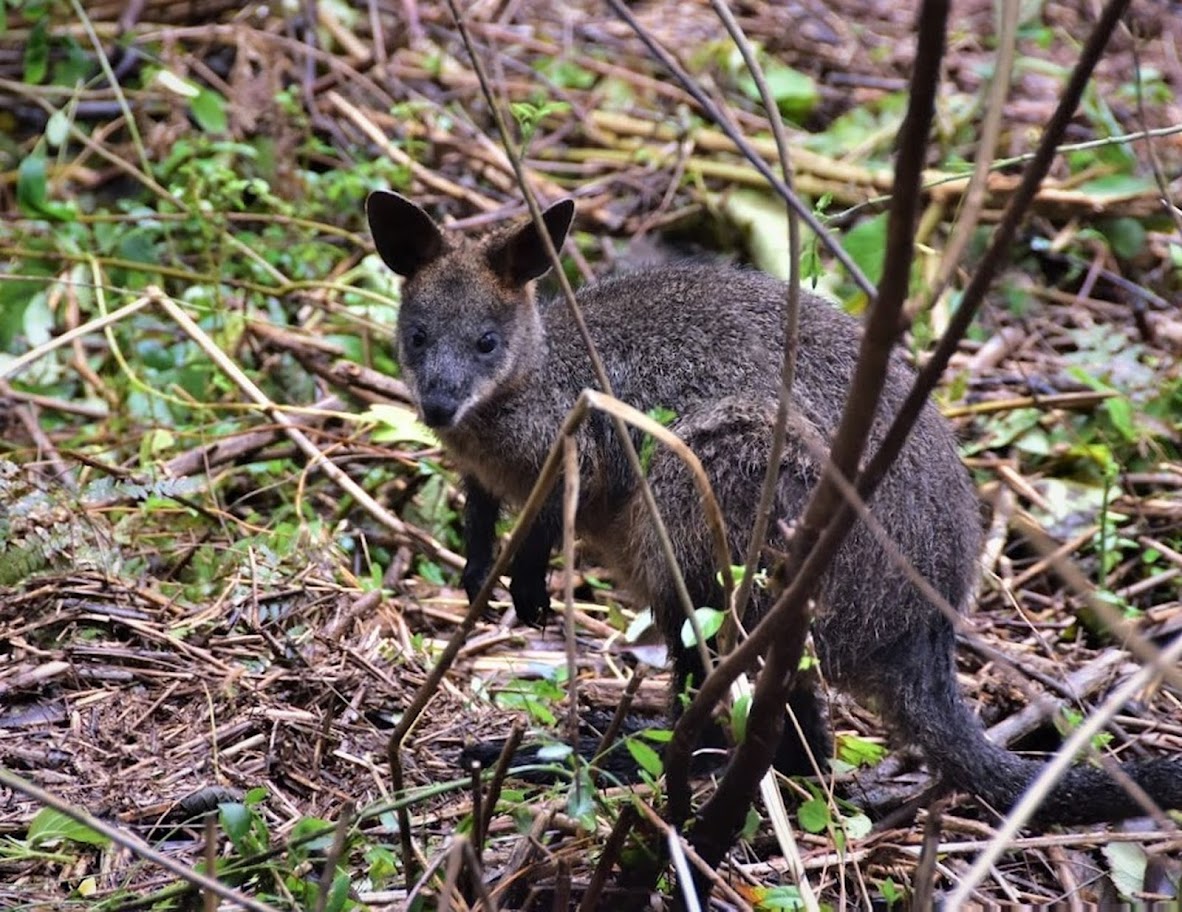
Information courtesy Ed Laginestra, Sydney Wildlife volunteer. Photo: Warriewood Wetlands Wallaby by Kevin Murray, March 2022.
Aviaries + Possum Release Sites Needed

Sydney Wildlife Rescue: Helpers Needed
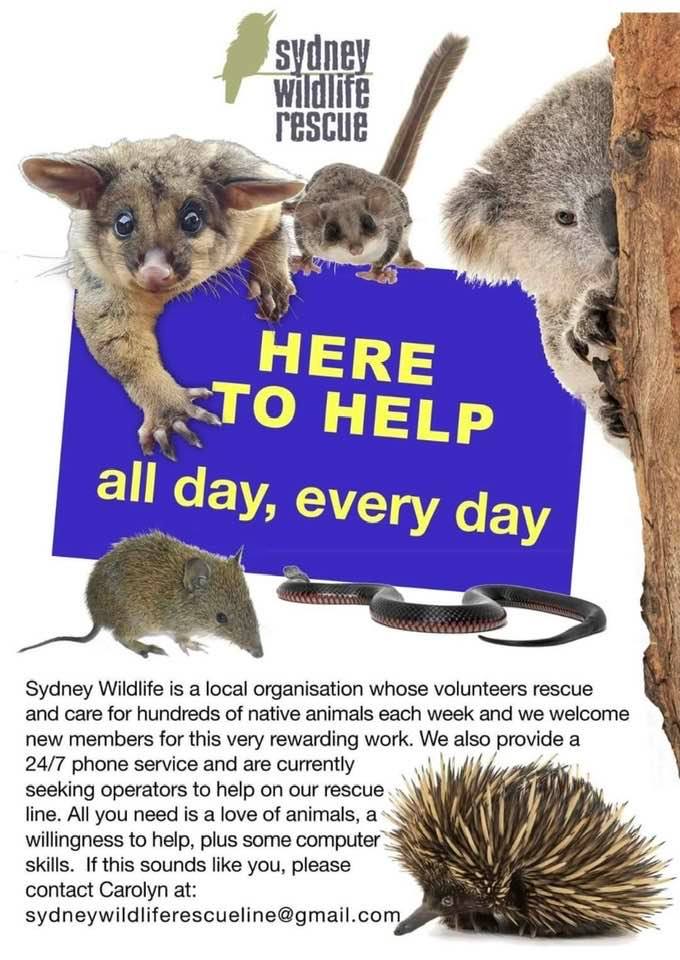
Bushcare In Pittwater
Where we work Which day What time
Avalon
Angophora Reserve 3rd Sunday 8:30 - 11:30am
Avalon Dunes 1st Sunday 8:30 - 11:30am
Avalon Golf Course 2nd Wednesday 3 - 5:30pm
Careel Creek 4th Saturday 8:30 - 11:30am
Toongari Reserve 3rd Saturday 9 - 12noon (8 - 11am in summer)
Bangalley Headland 2nd Sunday 9 to 12noon
Bayview
Winnererremy Bay 4th Sunday 9 to 12noon
Bilgola
North Bilgola Beach 3rd Monday 9 - 12noon
Algona Reserve 1st Saturday 9 - 12noon
Plateau Park 1st Friday 8:30 - 11:30am
Church Point
Browns Bay Reserve 1st Tuesday 9 - 12noon
McCarrs Creek Reserve Contact Bushcare Officer To be confirmed
Clareville
Old Wharf Reserve 3rd Saturday 8 - 11am
Elanora
Kundibah Reserve 4th Sunday 8:30 - 11:30am
 Mona Vale
Mona Vale Mona Vale Beach Basin 1st Saturday 8 - 11am
Mona Vale Dunes 2nd Saturday +3rd Thursday 8:30 - 11:30am
Newport
Bungan Beach 4th Sunday 9 - 12noon
Crescent Reserve 3rd Sunday 9 - 12noon
North Newport Beach 4th Saturday 8:30 - 11:30am
Porter Reserve 2nd Saturday 8 - 11am
North Narrabeen
Irrawong Reserve 2nd Saturday 2 - 5pm
Palm Beach
North Palm Beach Dunes 3rd Saturday 9 - 12noon
Scotland Island
Catherine Park 2nd Sunday 10 - 12:30pm
Elizabeth Park 1st Saturday 9 - 12noon
Pathilda Reserve 3rd Saturday 9 - 12noon
Warriewood
Warriewood Wetlands 1st Sunday 8:30 - 11:30am
Whale Beach
Norma Park 1st Friday 9 - 12noon
Western Foreshores
Coopers Point, Elvina Bay 2nd Sunday 10 - 1pm
Rocky Point, Elvina Bay 1st Monday 9 - 12noon
Gardens And Environment Groups And Organisations In Pittwater
Great Artesian Basin At Risk As Perrottet Government Approves New Coal Exploration
- Part of the recharge area of the Great Artesian Basin
- Several creek systems that flow into the Namoi River and areas of alluvial aquifers on the Namoi River floodplain used for irrigation
- 182 waterbores used for general water supply, irrigation, or stock and domestic.
- A formally listed Aboriginal Heritage site
- 12 threatened species including three endangered species - the Black-striped Wallaby, Koala, and Five-clawed Worm-skink
- 13,502.5 ha of native vegetation in the north eastern section of the Pilliga Forest including four four threatened ecological communities
Transition To Plantation Timber Would Be A Win For The Nature And Industry
Ever heard of ocean forests? They’re larger than the Amazon and more productive than we thought
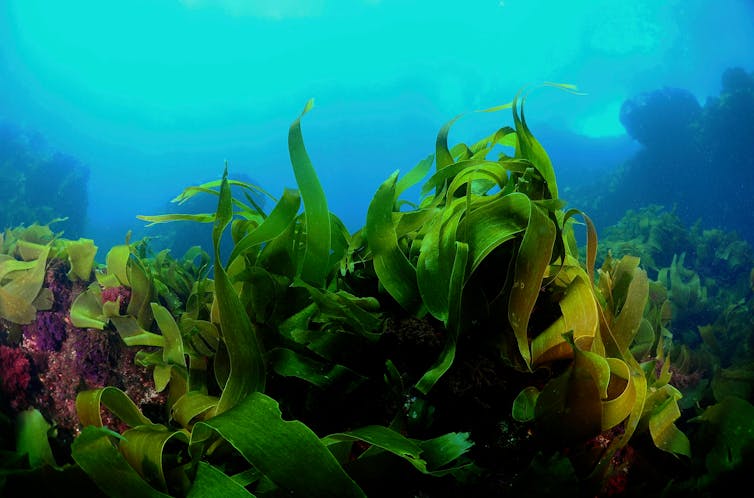
Amazon, Borneo, Congo, Daintree. We know the names of many of the world’s largest or most famous rainforests. And many of us know about the world’s largest span of forests, the boreal forests stretching from Russia to Canada.
But how many of us could name an underwater forest? Hidden underwater are huge kelp and seaweed forests, stretching much further than we previously realised. Few are even named. But their lush canopies are home to huge numbers of marine species.
Off the coastline of southern Africa lies the Great African Seaforest, while Australia boasts the Great Southern Reef around its southern reaches. There are many more vast but unnamed underwater forests all over the world.
Our new research has discovered just how extensive and productive they are. The world’s ocean forests, we found, cover an area twice the size of India.
These seaweed forests face threats from marine heatwaves and climate change. But they may also hold part of the answer, with their ability to grow quickly and sequester carbon.
What Are Ocean Forests?
Underwater forests are formed by seaweeds, which are types of algae. Like other plants, seaweeds grow by capturing the Sun’s energy and carbon dioxide through photosynthesis. The largest species grow tens of metres high, forming forest canopies that sway in a never-ending dance as swells move through. To swim through one is to see dappled light and shadow and a sense of constant movement.
Just like trees on land, these seaweeds offer habitat, food and shelter to a wide variety of marine organisms. Large species such as sea-bamboo and giant kelp have gas-filled structures that work like little balloons and help them create vast floating canopies. Other species relies on strong stems to stay upright and support their photosynthetic blades. Others again, like golden kelp on Australia’s Great Southern Reef, drape over seafloor.
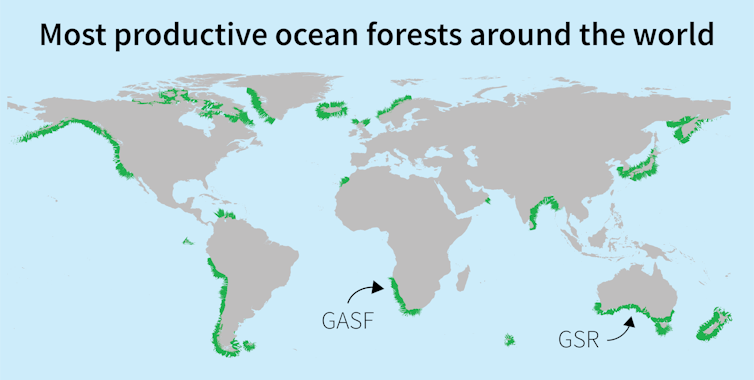
How Extensive Are These Forests And How Fast Do They Grow?
Seaweeds have long been known to be among the fastest growing plants on the planet. But to date, it’s been very challenging to estimate how large an area their forests cover.
On land, you can now easily measure forests by satellite. Underwater, it’s much more complicated. Most satellites cannot take measurements at the depths where underwater forests are found.
To overcome this challenge, we relied on millions of underwater records from scientific literature, online repositories, local herbaria and citizen science initiatives.

With this information, we modelled the global distribution of ocean forests, finding they cover between 6 million and 7.2 million square kilometres. That’s larger than the Amazon.
Next, we assessed how productive these ocean forests are – that is, how much they grow. Once again, there were no unified global records. We had to go through hundreds of individual experimental studies from across the globe where seaweed growth rates had been measured by scuba divers.
We found ocean forests are even more productive than many intensely farmed crops such as wheat, rice and corn. Productivity was highest in temperate regions, which are usually bathed in cool, nutrient-rich water. Every year, on average, ocean forests in these regions produce 2 to 11 times more biomass per area than these crops.

What Do Our Findings Mean For The Challenges We Face?
These findings are encouraging. We could harness this immense productivity to help meet the world’s future food security. Seaweed farms can supplement food production on land and boost sustainable development.
These fast growth rates also mean seaweeds are hungry for carbon dioxide. As they grow, they pull large quantities of carbon from seawater and the atmosphere. Globally, ocean forests may take up as much carbon as the Amazon.
This suggests they could play a role in mitigating climate change. However, not all that carbon may end up sequestered, as this requires seaweed carbon to be locked away from the atmosphere for relatively long periods of time. First estimates suggest that a sizeable proportion of seaweed could be sequestered in sediments or the deep sea. But exactly how much seaweed carbon ends up sequestered naturally is an area of intense research.
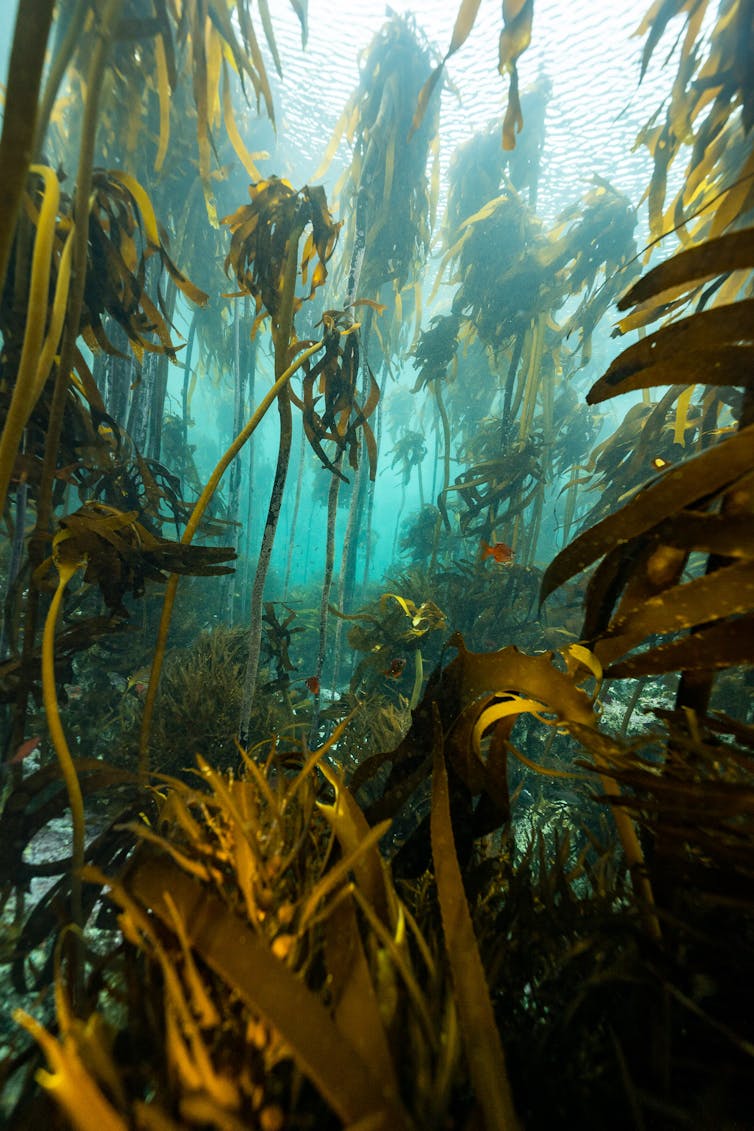
Hard Times For Ocean Forests
Almost all of the extra heat trapped by the 2,400 gigatonnes of greenhouse gases we have emitted so far has gone into our oceans.
This means ocean forests are facing very difficult conditions. Large expanses of ocean forests have recently disappeared off Western Australia, eastern Canada and California, resulting in the loss of habitat and carbon sequestration potential.
Conversely, as sea ice melts and water temperatures warm, some Arctic regions are expected to see expansion of their ocean forests.
These overlooked forests play an crucial, largely unseen role off our coasts. The majority of the world’s underwater forests are unrecognised, unexplored and uncharted.
Without substantial efforts to improve our knowledge, it will not be possible to ensure their protection and conservation – let alone harness the full potential of the many opportunities they provide.![]()
Albert Pessarrodona Silvestre, Postdoctoral Research Fellow, The University of Western Australia; Karen Filbee-Dexter, Research Fellow, School of Biological Sciences, The University of Western Australia, and Thomas Wernberg, Professor, The University of Western Australia
This article is republished from The Conversation under a Creative Commons license. Read the original article.
Nearly 30% of Australia’s emissions come from industry. Tougher rules for big polluters is a no-brainer
Rebecca Pearse, Australian National UniversityAustralia’s historic climate law passed the Senate last week and enshrined an economy-wide target to reduce emissions. But an important measure to reduce Australia’s industrial emissions is still up for debate: the “safeguard mechanism”.
Introduced by the Abbott government in 2014, the safeguard mechanism is supposed to stop Australia’s largest greenhouse gas polluters from emitting over a certain threshold. But the policy has been frequently criticised for lacking teeth. The Labor government has promised to strengthen the mechanism, and is currently reviewing it.
Industry has raised concerns over any toughening of the policy. Meanwhile, the Greens will push Labor to strengthen it further.
The safeguard mechanism covers the grid-connected power stations with a sectoral target. It also applies to 215 of Australia’s largest industrial emitters. Together, these 215 facilities produce almost 30% of Australia’s total annual emissions. So a stringent policy to curb this pollution is crucial to climate action.
Wait, What’s The Safeguard Mechanism?
The safeguard mechanism works by setting a limit on the emissions individual enterprises can produce in a year. This limit is put into place with “baselines” that get set in a number of different ways, depending on the type of company involved. Such companies might include a mining company, aluminium smelter, steelworks or airline.
If the company emits beyond their limit, they can buy carbon credits to compensate for, or “offset”, the excess emissions.
The mechanism covers hard-to-abate industries which are regulated on an individual basis, such as new coal, oil and gas projects, steel, aluminium, manufacturing and transport. These include Woodside’s Northwest Shelf gas project, Qantas, Chevron’s Gorgon gas project, Port Kembla steelworks, and AngloAmerican coal mines in central Queensland.
Coal fired power remains our biggest industrial source of emissions, but is regulated separately. A “sectoral baseline” has been set for all electricity generators connected to the national grid at 198 million tonnes of CO₂ equivalent each year.
Rubbery Baseline Emissions
Historically, the safeguard mechanism hasn’t put strong obligations on industrial emitters to reduce their emissions. Indeed, industrial emissions have increased since the mechanism began in 2016.
Imposing a genuine carbon limit on high-emitting companies requires a clear definition and enforcement of the baselines. But the safeguard mechanism provides enormous scope for expanded production and, therefore, expanded emissions.
The government’s review paper identifies a major problem with how baselines have been set in the past. Namely, many facilities have been allowed to set their baseline emissions well above their actual emissions.
Baselines for each facilities’ emissions are currently measured according to “production-adjusted” emissions intensity. So, for example, a coal mine’s baseline is measured per tonne of coal commodity produced. This means over time, baselines rise or fall in proportion to a company’s expected production.
The government’s consultation paper reports that in the 2020-21 financial year the combined baseline emissions recorded for non-electricity grid emissions under the safeguard mechanism was estimated at 180 million tonnes of CO₂ equivalent.
But actual emissions in the same period were 137 million tonnes of CO₂ equivalent.
It should also be noted that research suggests up to one in five fossil fuel projects are underestimating their actual emissions. But regardless, the high baselines mean there’s no regulatory pressure for companies to reduce their emissions.
The current review paper seeks feedback on these issues. Removing the head room for facilities with baselines well above their actual emissions is on the cards.
Carbon Credit Questions
The government is poised to propose significantly expanding carbon credit trading under the safeguard mechanism.
Carbon credits are granted to projects that reduce, store or avoid greenhouse gas emissions. These credits can be sold to the federal government or to private companies to offset a project’s own emissions.
Under the current safeguard mechanism, if a company exceeds its baseline emissions, then it can purchase Australian carbon credits to offset this.
These carbon offsets, however, are plagued with credibility problems. In fact, another federal government review is underway to examine the issues.
There are calls to strongly limit or remove questionable offsets linked to the safeguard mechanism.
For instance, climate science professor Mark Howden argued recently that offsets should not be used to give big emitters a “free ride” to continue polluting if they invest in carbon sequestration projects, at this stage. Instead, the immediate priorities should be limiting fossil fuel combustion burning, and making concrete plans for other industries to transition.
Despite this, the federal government is considering expanding trade in these and potentially other types of carbon credits.
The government is proposing a new type of carbon credit for companies emitting below their baseline. For instance, if an aluminium smelter reduced its emissions over 2024 and 2025, it could be granted credits to sell to others in the carbon market.
The government is also considering allowing companies to trade carbon credits on an international level, pending reforms to address integrity issues in safeguard mechanism like the baseline headroom problem.
The international trade in carbon credits has been plagued with problems for 20 years. A 2021 literature review found little evidence demonstrating causal effect of carbon trading markets on emissions reduction.
It puts a strong case forward against linking carbon markets internationally, after Europe, Quebec and California case studies show linking carbon markets has led to price crashes and volatility – not stability.
The Risk Of A Weak Carbon Trading Market
We can expect industry to continue to lobby for a weak safeguard mechanism and carbon credit rules. But if the Labor government is genuine about wanting to reduce Australia’s emissions, our biggest polluters cannot be allowed to carry on emitting as usual.
And there is no role for a carbon trading policy that excuses big emitters from making clean energy transition plans.
Labor may need the numerous pro-climate independent senators or the Greens to make changes signalled in the safeguard consultation paper. They are unlikely to be satisfied with a weak carbon trading scheme.
Any proposed changes that undermine Australia’s emissions reduction goals will not easily be passed.![]()
Rebecca Pearse, Lecturer, Australian National University
This article is republished from The Conversation under a Creative Commons license. Read the original article.
‘Too hard to get to work’: climate change is making workers’ lives more difficult
Lauren Rickards, RMIT University and Todd Denham, RMIT University“Work” – broadly defined – is what allows society to function. Like other old certainties, it is under threat from climate change.
A key reason climate-related stresses and disruptions can have such a big impact is precisely because of their effect on the work we do and on the wider system of work we rely on. But little attention has been given to the urgent need to adapt work to climate change.
Our new report on climate impacts at work, released today, documents emerging serious risks.
A female professional told us: “there were days where I simply had to use up sick leave because it was too hot to get safely to work”.
One male sales worker told us about working during the Black Summer of 2019/2020:
Smoke from bushfires two years ago was intolerable. The heat also was horrific at times. During the smokiest days temperatures often shot up to over 40 degrees. It was like the planet Venus. My employer … provided no masks at all at that time, despite numerous requests, even pleadings.
Australia is already 1.4℃ warmer than it was in 1910. Climatic extremes and events like the 2022 floods and Black Summer – as well as many less visible disruptions – are already undermining our capacity to work across different organisations, industries and sectors.
We will have to get better at adapting to our changed climate – and quickly.
What Did We Find?
We found the effects of climate change on workers reach more widely than than previously thought.
In short, no one is immune to climate harms, whether indoor or outdoor, junior or senior. Given we rely on each others’ work, that means climate change impacts are likely to increasingly “cascade” through society, as the 2022 IPCC report on Australasia details.
Our research comes from a survey of 1,165 workers across ten industries undertaken in the first half of 2022, assisted by six unions. The sample is not representative of the workforce as a whole and is skewed towards types of workers not typically considered on harms from climate change, such as professionals and community and personal service workers.
Previous research has documented the serious ways heat affects workers, especially those outdoors or in poorly cooled spaces. Other studies have found outdoor council workers and delivery cyclists in Sydney are already having to use coping mechanisms such as extra breaks, lighter duties and temporarily stopping work to try to avoid heat stress.
Our data similarly points to heat’s health impacts. Outdoor workers were especially likely to report being tired and fatigued, dehydrated and less productive. They were also more likely to sweat excessively and be sunburnt.
Less recognised is that indoor workers are also being affected by heat and smoke.
These health impacts are serious. Close to 450 people died from the effects of smoke inhalation over the Black Summer. These issues were compounded by the COVID pandemic, notably for those workers who have to had to wear personal protective equipment or work from poorly cooled houses during heatwave conditions.
Climate change can undermine people’s capacity to work in other ways. Some workers reported impacts on the amount and focus of their work. For example, some had to take on new tasks to cover for colleagues who were overwhelmed or furloughed due to the Black Summer fires. A quarter reported having to work additional hours due to emergency situations such as the floods, while others reported they had lost hours, had to take personal leave or even lost their job as a result of climatic events.
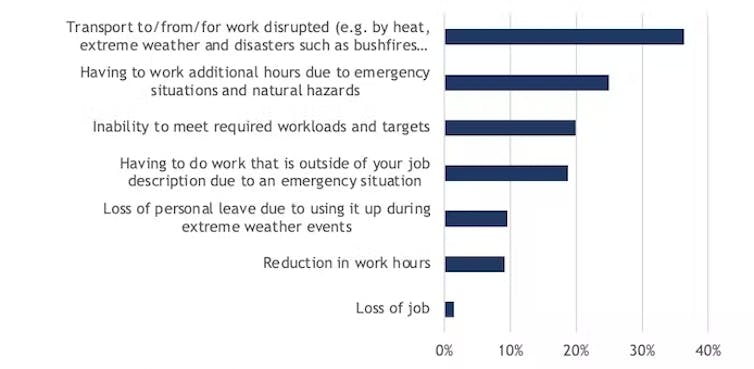
There are even impacts from climatic effects on the wider public. Half of the survey respondents reported having to manage angrier customers, while 60% said climatic events had led to staffing disruptions. Some reported extreme weather was causing supply chain disruption.
One male professional said:
The frequency of storm events has noticeably increased, and these storms are often more severe with higher wind speeds and rates of precipitation than in the past. […] Our workload has increased accordingly and risk to people and property has also increased.
Management are struggling to come to terms with the frequency and severity of storm events and this is leading to anxiety and conflict with management in relation to the perceived need to close the site, or part of it, during severe weather events. Site closure protects individuals from harm […] but is bad for revenue raising for the many businesses that operate on our site.
Our capacity to work often relies on intricate systems of settlements, infrastructure and services that consist of workplaces and support others. When any of these workplaces are affected, there are flow-on effects.
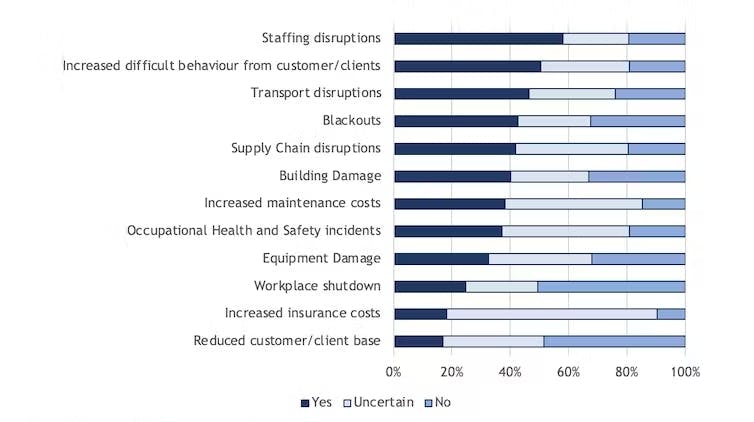
Our survey found more than a third of workers had not been able to travel to work due to climatic factors. If trains don’t run or roads are blocked, it can bring many workplaces to a halt.
We are now enmeshed in a different climate to the one we grew up in – and it will change more.
To make our societies and systems resilient to climate change, we will have to adapt how, where, when we work, who “we” is, what we work on, and why. This adaptation work is urgent. No one is immune.
Friends of the Earth contributed to this research![]()
Lauren Rickards, Professor, RMIT University and Todd Denham, Research officer, Centre for Urban Research, RMIT University
This article is republished from The Conversation under a Creative Commons license. Read the original article.
La Niña, 3 years in a row: a climate scientist on what flood-weary Australians can expect this summer
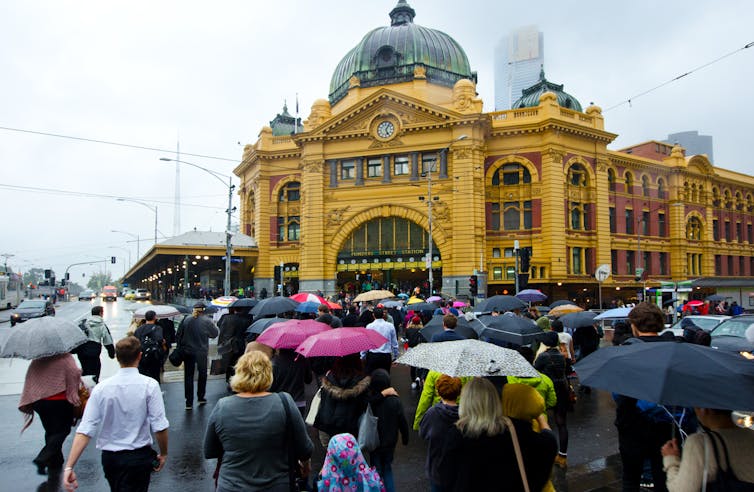
After weeks of anticipation, it’s finally official: the Bureau of Meteorology has declared another La Niña is underway. This means Australia’s east coast will likely endure yet another wet, and relatively cool, spring and summer.
It’s the third La Niña event in a row. This is rare, but not unheard of. Triple La Niñas have also occurred in, for example, 1973–1976 and 1998–2001.
The past two La Niñas mean water catchments are already full, and soils are sodden from Noosa in the north through to Lismore and the Hunter Valley in the south. It means more flood events are likely in the coming months.
The bureau’s declaration will be unwelcome news to many people – especially those in parts of New South Wales and Queensland still recovering from recent floods. So what else can flood-weary Australians expect in the coming months? And is a fourth La Niña on the cards?
A Potentially Mild La Niña
La Niña is part of a natural climate cycle over the tropical Pacific Ocean. Sea surface temperatures in the central and eastern tropical Pacific vary between being warmer than average (El Niño) and cooler than average (La Niña).
This variability has worldwide effects as it shifts weather patterns – bringing droughts to some regions and floods to others.
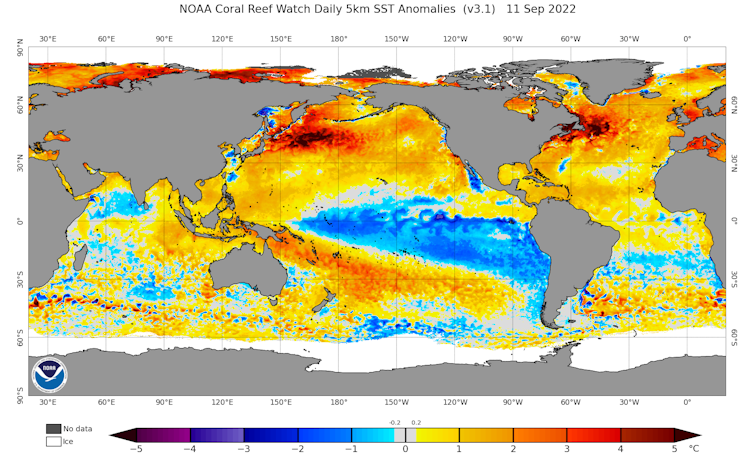
For most of Australia, La Niña raises the chance of rain. It has contributed to some of Australia’s wettest ever conditions, and some of the driest in the southern United States across the Pacific Ocean.
The Bureau of Meteorology says this La Niña may peak during spring, and return to neutral conditions early in 2023. Most seasonal prediction models are suggesting this La Niña event will be weaker and shorter-lived than the last two.
Typically, stronger La Niña seasons are associated with more extreme rainfall in eastern Australia. So hopefully a mild La Niña comes to pass and flood-hit regions avoid the worst of the summertime rain, at least.
La Niña is a part of the El Niño-Southern Oscillation, a natural phenomenon. We know these events have occurred in the past – before large-scale greenhouse gas emissions from human activities.
We don’t yet know how La Niña may change as the planet continues to warm, but evidence suggests climate change may make La Niña (and its counterpart El Niño) events more frequent and intense.
And research from earlier this year suggests relationships between La Niña and regional climate may become stronger over many parts of the world, including much of Australia. This could mean Australia feels the force of La Niña and El Niño events more in future as the planet continues to heat.
Three Climate Forces At Work
It’s not just La Niña affecting Australia’s climate at the moment. Two other natural climate forces are also in play: the Indian Ocean Dipole and the Southern Annular Mode.
The Indian Ocean Dipole is characterised by variable sea surface temperatures in the Indian Ocean, and the Southern Annular Mode by the positioning of winds and weather systems to Australia’s south.
We’re currently in a “negative” Indian Ocean Dipole and a “positive” phase of the Southern Annular Mode.
These all have different effects on the Australian climate. In springtime, these conditions – in combination with La Niña – are conducive to more rain in eastern Australia.
We saw all three of these phenomena occur simultaneously in the spring of 2010, when eastern Australia experienced record high rainfall.
It’s too early to say where exactly in Australia is most likely to experience flooding this spring. While La Niña, the negative Indian Ocean Dipole and positive Southern Annular Mode raise the chances of rainfall, individual weather systems and their trajectories will determine where the worst is located.
What Does La Niña Mean For Drought And Bushfire?
One positive aspect of La Niña is it keeps drought out of the picture for the time being. Some of Australia’s worst droughts are characterised by a lack of La Niña or negative Indian Ocean Dipole conditions over several years. Eastern Australia is unlikely to experience severe drought in the near future.
The La Niña conditions also reduce the likelihood that we’ll see a bad bushfire season in eastern Australia this coming summer.
But it isn’t all good news. La Niña and the other climate influences raise the chances of plant growth and greening in eastern Australia. And this could provide fuel for future fires once conditions dry out again.
Historically, major bushfire seasons in eastern Australia have often followed La Niña events. In 2011, after a La Niña and very wet conditions, we saw some of the biggest fires on record.
A background trend towards hotter, drier weather due to climate change could spell trouble down the track.
Another effect of the triple La Niña is that we haven’t seen record high global-average temperatures since 2016 (noting that 2020 and 2016 are almost tied). This is despite our continued very high greenhouse gas emissions, which have rebounded since the pandemic-associated dip.
La Niña typically reduces global-mean temperatures slightly by cooling a large area of the Pacific Ocean – but this is a temporary effect. Record high global-average temperatures will come again soon, and are more likely when the next El Niño occurs.
Could We Have A Fourth La Niña?
Many Australians hoping La Niña was behind us for a few years now have to contend with a third in a row.
While we’ve seen triple La Niña events before, we have never seen quadruple La Niña in the historical record. This doesn’t mean it couldn’t happen. In fact, the 2001-2002 season that followed the 1998-2001 triple La Niña wasn’t a long way off from being yet another La Niña.
For now, we must prepare for a wet spring and possibly another wet summer to come.
Severe flooding is more likely than usual in already flood-hit zones, so lessons learnt from the devastation caused by the recent floods should be put in place. ![]()
Andrew King, Senior Lecturer in Climate Science, The University of Melbourne
This article is republished from The Conversation under a Creative Commons license. Read the original article.
We may be underestimating just how bad carbon-belching SUVs are for the climate – and for our health
Robin Smit, University of Technology Sydney and Nic Surawski, University of Technology SydneyAustralia’s love for fuel-hungry and fuel-inefficient SUVs is hampering our ability to bring transport emissions down. SUVs make up half of all new car sales last year, a National Transport Commission report revealed this week – up from a quarter of all sales a decade ago.
As a result, the carbon emitted by all new cars sold in Australia dropped only 2% in 2021, the report found. Sales of battery electric vehicles tripled last year, but still make up just 0.23% of all cars and light commercial vehicles on our roads.
In internationally peer-reviewed research earlier this year, we measured the emissions of five SUVs driving around Sydney, and our findings suggest the situation may actually be worse than the new report finds.
The National Transport Commission’s numbers are based on the “New European Drive Cycle” (NEDC) emissions test. Our research found the real-world emissions of SUVs are, on average, about 30% higher than the NEDC values. This means we are not reducing fleet average emissions by a few percent per year, but actually probably increasing them by a few percent every year.
What The Report Found
The transport sector is responsible for almost 20% of Australia’s emissions, ranking third behind the electricity and agriculture sector. The first year of the COVID pandemic only reduced transport carbon dioxide emissions by about 7%, compared to 2019 emission levels.
Overall, Australia’s pride in carbon-belching transport is evident by the fact transport CO₂ emissions have risen 14% between 2005 and 2020.
SUVs are generally larger and heavier than other passenger cars, which means they need quite a bit more energy and fuel per kilometre of driving when compared with smaller, lighter cars.
Although SUV sales are rising globally, the Australian fleet is unique due to its large portion of SUVs in the on-road fleet, often with four-wheel-drive capability.
According to the National Transport Commission report, sales of four-wheel-drives and utes surged by more than 43,000 in 2021, while large SUV sales rose by around 25,000.
Rapidly shifting to electric cars is an important way to bring emissions down. But the report found in 2021, just 2.8% of Australia’s car sales were electric. Compare this to 17% in Europe, 16% in China and 5% in the United States.
In Australia, there is still no option to buy an electric ute, and electric vehicles remain prohibitively expensive.
Measuring SUV Emissions In Sydney
There are a range of methods scientists use to measure vehicle emissions.
One popular method worldwide uses so-called “on-board portable emission monitoring systems”. These systems are effective because they enable second-by-second emissions testing under a variety of real-world driving conditions on the road.
On the other hand, the New European Drive Cycle (NEDC) emissions test is conducted in the laboratory. It was also developed in the early 1970s and reflects unrealistic driving behaviour, because test facilities at the time could not deal with significant changes in speed.
We fitted five SUVs with a portable emission monitoring system and drove them a little over 100 kilometres around Sydney in various situations, such as in the city and on the freeway.
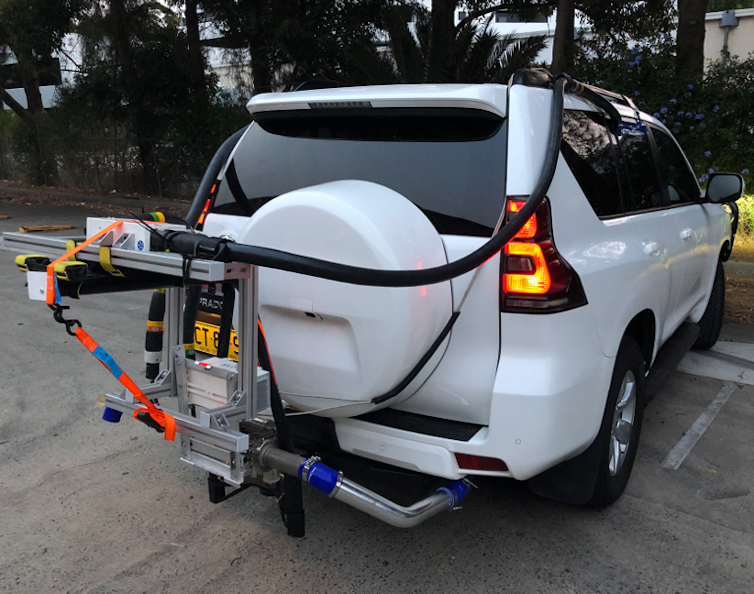
We then compared our measurements with the Green Vehicle Guide – the national guide to vehicle fuel consumption and environmental performance, which is also based on the NEDC test.
Our measurements of fuel consumption and CO₂ emissions were consistently higher. This varied from 16% to 65% higher than NEDC values, depending on the actual car and driving conditions.
On average, real-world fuel consumption and CO₂ emissions were both 27% higher than NEDC values. Importantly, this gap has increased substantially from about 10% in 2008.
Indeed, previous research from 2019 found fleet average greenhouse gas emissions for new Australian cars and SUVs has probably been increasing by 2-3% percent per year since 2015, rather than the reported annual reduction by, for instance, the National Transport Commission.
This detailed analysis showed a sustained increase in vehicle weight and a shift to the sale of more four-wheel-drive cars (in other words, SUVs) are probably the main factors contributing to this change.
More Bad News For SUVs
We also recently summarised the results of various emission measurement campaigns conducted in Australia and compared them with international studies. These include results from a study of vehicle emissions in a tunnel, and a study of vehicle emissions measured on the road with remote sensing.
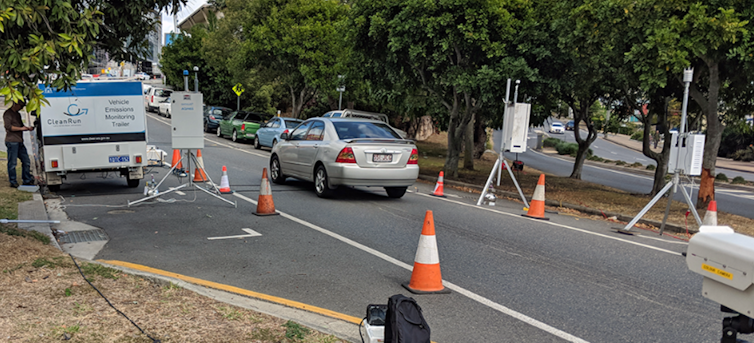
We found modern diesel SUVs and cars or diesel light commercial vehicles (such as utes) in Australia and New Zealand have relatively high emissions of nitrogen oxides and soot – both important air pollutants.
Around 2,600 deaths are attributed to fine-particle air pollution in Australia each year. Transport and industrial activities (such as mining) are the main sources of this.
And in 2015, an estimated 1,715 deaths were attributed to vehicle exhaust emissions – 42% more than the road toll that year.
The remote sensing emissions data suggest 1% of one to two-year-old diesel SUVs and 2% of one-to-two year old diesel light commercial vehicles have issues with their particulate filters, leading to high soot emissions.
These percentages are high when compared with a similar study conducted in the United Kingdom, which could not find any clear evidence of filter issues.
Three Ways To Move Forward
Ever increasing SUVs sales are a drag on successfully reducing Australia’s total greenhouse gas emissions. So what should we do?
Of course there are several things to consider, but in terms of fuel efficiency and greenhouse gas emissions, we believe there are three main points.
First, we need to make sure we have realistic fuel use and emissions data. This means the National Transport Commission and Green Vehicle Guide should stop using the NEDC values and shift to more realistic emissions data. We acknowledge this is not a simple matter and it requires a lot more testing.
Second, we need to electrify transport as fast as we can, wherever we can. This is crucial, but not the whole solution.
To ensure Australia meets its net-zero emissions target, we also need to seriously consider energy and fuel efficiency in transport. This could be by promoting the sales of smaller and lightweight vehicles, thereby optimising transport for energy efficiency.
In all of this, it will be essential for car manufacturers to take responsibility for their increasing contributions to climate change. From this perspective, they should move away from marketing profitable fossil-fueled SUVs that clog up our roads, and instead offer and promote lighter, smaller and electric vehicles.![]()
Robin Smit, Adjunct Associate Professor, University of Technology Sydney and Nic Surawski, Senior Lecturer in Environmental Engineering, University of Technology Sydney
This article is republished from The Conversation under a Creative Commons license. Read the original article.
Scientists are divining the future of Earth’s ice-covered oceans at their harsh fringes

One of the harshest and most dynamic regions on Earth is the marginal ice zone – the place where ocean waves meet sea ice, which is formed by freezing of the ocean’s surface.
Published today, a themed issue of the journal Philosophical Transactions of the Royal Society A reviews the rapid progress researchers have made over the past decade in understanding and modelling this challenging environment.
This research is vital for us to better understand the complex interactions of Earth’s climate systems. That’s because the marginal ice zone plays a role in the seasonal freezing and thawing of the oceans.
A Harsh Place To Study
In the Arctic and Antarctic, surface ocean temperatures are persistently below -2℃ – cold enough to freeze, forming a layer of sea ice.
At the highest latitudes closer to the poles, sea ice forms a solid, several-metre-thick lid on the ocean that reflects the Sun’s rays, cooling the region and driving cool water around the oceans. This makes sea ice a key component of the climate system.
But at lower latitudes, as the ice-covered ocean transitions to the open ocean, sea ice forms into smaller, much more mobile chunks called “floes” that are separated by water or a slurry of ice crystals.
This marginal ice zone interacts with the atmosphere above and ocean below in a very different way to ice cover closer to the poles.
It’s a challenging environment for scientists to work in, with a voyage into the marginal ice zone around Antarctica in 2017 experiencing winds over 90km/h and waves over 6.5m high. It is also difficult to observe remotely because the floes are smaller than what most satellites can see.
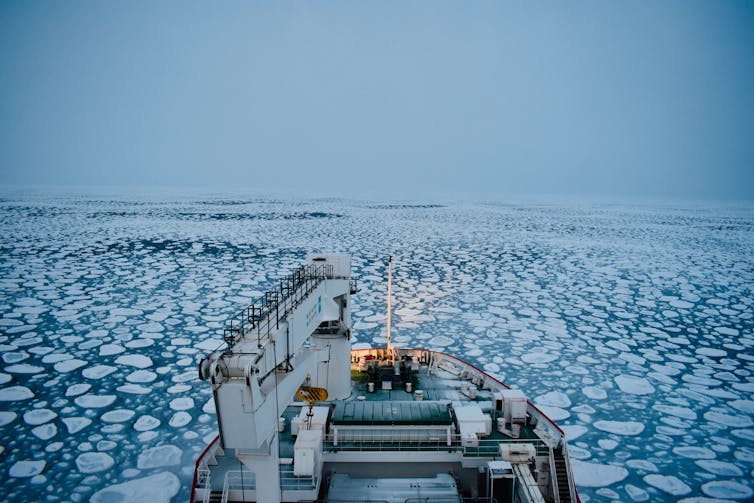
Crushed By Waves
The marginal ice zone also interacts with the open ocean via surface waves, which travel from the open waters into the zone, impacting the ice. The waves can have a destructive effect on the ice cover, by breaking up large floes and leaving them more susceptible to melt during summer.
By contrast, during winter, waves can promote the formation of “pancake” floes, so called because they are thin disks of sea ice (you can see them in the image above).
But wave energy itself is lost during interactions with floes, so that waves gradually become weaker as they travel deeper into the marginal ice zone. This produces wave–ice feedback mechanisms driving sea ice evolution in a changing climate.
For example, a trend for warmer temperatures will weaken the ice cover, allowing waves to travel deeper into ice-covered oceans and cause more breakup, which further weakens the ice cover – and so on.

Scientists studying marginal ice zone dynamics aim to improve our understanding of the zone’s role in the dramatic and often perplexing changes the world’s sea ice is undergoing in response to climate change.
For instance, in the Arctic Ocean, sea ice cover has “has dropped by roughly half since the 1980s”. In the Antarctic, the sea ice cover has recently had both one of its largest and smallest recorded extents, with the marginal ice zone being one source of year-to-year variability.
Our progress in better understanding these harsh regions has revolved around large international research programs, run by the United States’ Office of Naval Research and others. These programs involve earth scientists, geophysicists, oceanographers, engineers and even applied mathematicians (like us).
Recent efforts have produced innovative observation techniques, such as a method to 3D-image wave and floe dynamics in the marginal ice zone from onboard an icebreaker and capture waves-in-ice from satellite images.
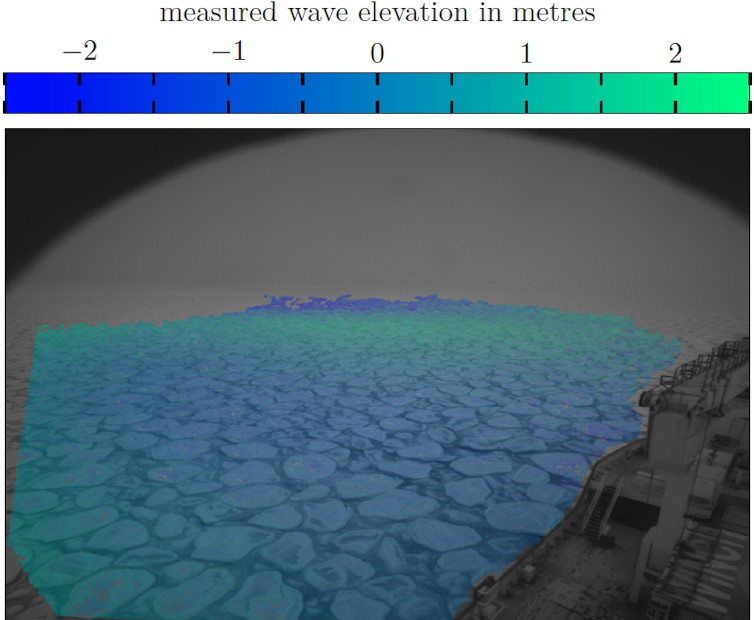
They have also resulted in new models capable of simulating the interaction of waves and ice from the level of individual floes to the overall behaviour of entire oceans. The advances have motivated an Australian led multi-month experiment in the Antarctic marginal ice zone, on the new $500M icebreaker RSV Nuyina, which is expected next year.
The marginal ice zone will be an increasingly important component of the world’s sea ice cover in the future, as temperatures rise and waves become more extreme.
Despite the rapid progress, there is still some way to go before the understanding of feedback processes in the marginal ice zone translates into improved climate predictions used by, for example, the International Panel on Climate Change Assessment Reports.
Including the marginal ice zone in climate models has been described as the “holy grail” for the field by one of its leading figures, and the theme issue points to closer ties with the broader climate community as the next major direction for the field.![]()
Jordan Peter Anthony Pitt, Post-Doctoral Researcher, University of Adelaide and Luke Bennetts, Lecturer in applied mathematics, University of Adelaide
This article is republished from The Conversation under a Creative Commons license. Read the original article.
Where is your seafood really from? We’re using ‘chemical fingerprinting’ to fight seafood fraud and illegal fishing

Fake foods are invading our supermarkets, as foods we love are substituted or adulterated with lower value or unethical goods.
Food fraud threatens human health but is also bad news for industry and sustainable food production. Seafood is one of most traded food products in the world and reliant on convoluted supply chains that leave the the door wide open for seafood fraud.
Our new study, published in the journal Fish and Fisheries, showcases a new approach for determining the provenance or “origin” of many seafood species.
By identifying provenance, we can detect fraud and empower authorities and businesses to stop it. This makes it more likely that the food you buy is, in fact, the food you truly want to eat.

Illegal Fishing And Seafood Fraud
Wild-caught seafood is vulnerable to illegal, unreported, and unregulated fishing.
Illegal, unreported, and unregulated fishing can have a devastating impact on the marine environment because:
it is a major cause of overfishing, constituting an estimated one-fifth of seafood
it can destroy marine habitats, such coral reefs, through destructive fishing methods such as blast bombing and cyanide fishing
it can significantly harm wildlife, such as albatross and turtles, which are caught as by-catch.
So how is illegal, unreported, and unregulated fishing connected to seafood fraud?
Seafood fraud allows this kind of fishing to flourish as illegal products are laundered through legitimate supply chains.
A recent study in the United States found when seafood is mislabelled, it is more likely to be substituted for a product from less healthy fisheries with management policies that are less likely to reduce the environmental impacts of fishing.
One review of mislabelled seafood in the US found that out of 180 substituted species, 25 were considered threatened, endangered, or critically endangered by the International Union for Conservation of Nature and Natural Resources (IUCN).
Illegal fishing and seafood fraud also has a human cost. It can:
adversely affect the livelihoods of law-abiding fishers and seafood businesses
threaten food security
facilitate human rights abuses such as forced labour and piracy
increase risk of exposure to pathogens, drugs, and other banned substances in seafood.
The Chemical Fingerprints In Shells And Bones
A vast range of marine animals are harvested for food every year, including fish, molluscs, crustaceans, and echinoderms.
However, traditional food provenance methods are typically designed to identify one species at a time.
That might benefit the species and industry in question, but it is expensive and time consuming. As such, current methods are restricted to a relatively small number of species.
In our study, we described a broader, universal method to identify provenance and detect fraud.
How? We harnessed natural chemical markers imprinted in the shells and bones of marine animals. These markers reflect an animal’s environment and can identify where they are from.
We focused on a chemical marker that is similar across many different marine animals. This specific chemical marker, known as “oxygen isotopes”, is determined by ocean composition and temperature rather than an animal’s biology.
Exploiting this commonality and how it relates to the local environment, we constructed a global ocean map of oxygen isotopes that helps researchers understand where a marine animal may be from (by matching the oxygen isotope value in shells and bones to the oxygen isotope value in the map).
After rigorous testing, we demonstrated this global map (or “isoscape”) can be used to correctly identify the origins of a wide range of marine animals living in different latitudes.
For example, we saw up to 90% success in classifying fish, cephalopods, and shellfish between the tropical waters of Southeast Asia and the cooler waters of southern Australia.

What Next?
Oxygen isotopes, as a universal marker, worked well on a range of animals collected from different latitudes and across broad geographic areas.
Our next step is to integrate oxygen isotopes with other universal chemical markers to gives clues on longitude and refine our approach.
Working out the provenance of seafood is a large and complex challenge. No single approach is a silver bullet for all species, fisheries or industries.
But our approach represents a step towards a more inclusive, global system for validating seafood provenance and fighting seafood fraud.
Hopefully, this will mean ensure fewer marine species are left behind and more consumer confidence in the products we buy.
Dr Jasmin Martino, a Postdoctoral Research Fellow at the Australian Nuclear Science and Technology Organisation, contributed to this research and article.![]()
Zoe Doubleday, Marine Ecologist and ARC Future Fellow, University of South Australia
This article is republished from The Conversation under a Creative Commons license. Read the original article.
The climate crisis is real – but overusing terms like ‘crisis’ and ‘emergency’ comes with risk
Noel Castree, University of Technology Sydney“Crisis” is an incredibly potent word, so it’s interesting to witness the way the phrase “climate crisis” has become part of the lingua franca.
Once associated only with a few “outspoken” scientists and activists, the phrase has now gone mainstream.
But what do people understand by the term “climate crisis”? And why does it matter?
The Mainstreaming Of Crisis-Talk
It’s not only activists or scientists sounding the alarm.
UN Secretary General Antonio Guterres now routinely employs dramatic phrases like “digging our own graves” when discussing climate. Bill Gates advises us to avoid “climate disaster”.
This linguistic mainstreaming marks redrawn battle lines in the “climate wars”.
Denialism is in retreat. The climate change debate now is about what is to be done and by whom?
Scientists, using the full authority of their profession, have been key to changing the discourse. The lead authors of Intergovernmental Panel on Climate Change (IPCC) reports now pull no punches, talking openly about mass starvation, extinctions and disasters.
These public figures clearly hope to jolt citizens, businesses and governments into radical climate action.
But for many ordinary folks, climate change can seem remote from everyday life. It’s not a “crisis” in the immediate way the pandemic has been.
Of course, many believe climate experts have understated the problem for too long.
And yet the new ubiquity of siren terms like climate “crisis”, “emergency”, “disaster”, “breakdown” and “calamity” does not guarantee any shared, let alone credible, understanding of their possible meaning.
This matters because such terms tend to polarise.
Few now doubt the reality of climate change. But how we describe its implications can easily repeat earlier stand-offs between “believers” and “sceptics”; “realists’ and "scare-mongerers”. The result is yet more political inertia and gridlock.
We will need to do better.
Four Ideas For A New Way Forward
Terms like “climate crisis” are here to stay. But scientists, teachers and politicians need to be savvy. A keen awareness of what other people may think when they hear us shout “crisis!” can lead to better communication.
Here are four ideas to keep in mind.
1. We must challenge dystopian and salvation narratives
A crisis is when things fall apart. We see news reports of crises daily – floods in Pakistan, economic collapse in Sri Lanka, famine in parts of Africa.
But “climate crisis” signifies something that feels beyond the range of ordinary experience, especially to the wealthy. People quickly reach for culturally available ideas to fill the vacuum.
One is the notion of an all-encompassing societal break down, where only a few survive. Cormac McCarthy’s bleak book The Road is one example.
Central to many apocalyptic narratives is the idea technology and a few brave people (usually men) can save the day in the nick of time, as in films like Interstellar.
The problem, of course, is these (often fanciful) depictions aren’t suitable ways to interpret what climate scientists have been warning people about. The world is far more complicated.
2. We must bring the climate crisis home and make it present now
Even if they’re willing to acknowledge it as a looming crisis, many think climate change impacts will be predominantly felt elsewhere or in the distant future.
The disappearance of Tuvalu as sea levels rise is an existential crisis for its citizens but may seem a remote, albeit tragic, problem to people in Chicago, Oslo or Cape Town.
But the recent floods in eastern Australia and the heatwave in Europe allow a powerful point to be made: no place is immune from extreme weather as the planet heats up.
There won’t be a one-size-fits-all global climate crisis as per many Hollywood movies. Instead, people must understand global warming will trigger myriad local-to-regional scale crises.
Many will be on the doorstep, many will last for years or decades. Most will be made worse if we don’t act now. Getting people to understand this is crucial.
3. We must explain: a crisis in relation to what?
The climate wars showed us value disputes get transposed into arguments about scientific evidence and its interpretation.
A crisis occurs when events are judged in light of certain values, such as people’s right to adequate food, healthcare and shelter.
Pronouncements of crisis need to explain the values that underpin judgements about unacceptable risk, harm and loss.
Historians, philosophers, legal scholars and others help us to think clearly about our values and what exactly we mean when we say “crisis”.
4. We must appreciate other crises and challenges matter more to many people
Some are tempted to occupy the moral high ground and imply the climate crisis is so grand as to eclipse all others. This is understandable but imprudent.
It’s important to respect other perspectives and negotiate a way forward. Consider, for example, the way author Bjørn Lomborg has questioned the climate emergency by arguing it’s not the main threat.
Lomborg was widely pilloried. But his arguments resonated with many. We may disagree with him, but his views are not irrational.
We must seek to understand how and why this kind of argument makes sense to so many people.
Words matter. It’s vital terms like “crisis” and “calamity” don’t become rhetorical devices devoid of real content as we argue about what climate action to take.![]()
Noel Castree, Professor of Society & Environment, University of Technology Sydney
This article is republished from The Conversation under a Creative Commons license. Read the original article.
Now, we begin: 10 simple ways to make Australia’s climate game truly next-level
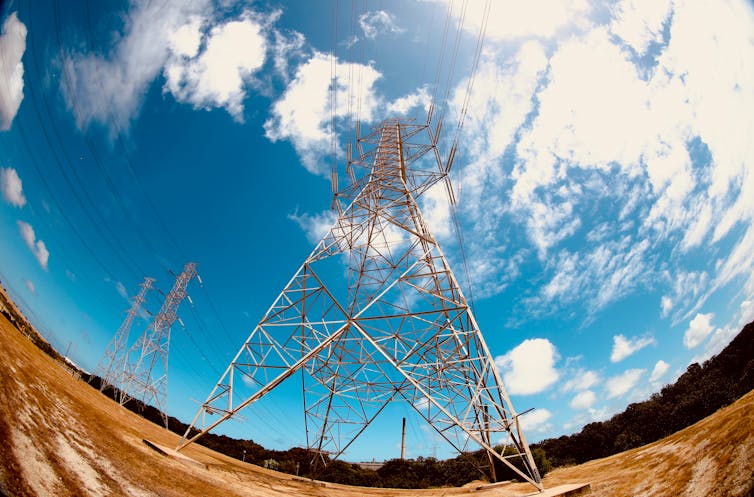
Australia last week moved to tackle the climate crisis when federal parliament passed Labor’s climate bill. But the new law is just the first step. Over the next eight years to 2030, we must get on a steep trajectory of emissions reductions.
The law set a national target to cut emissions by 43% this decade, based on 2005 levels. While this brings Australia closer to the international consensus, we should be aiming to go much further, much faster.
When Prime Minister Anthony Albanese informed the United Nations of Australia’s new target, he wrote of his government’s aspiration for “even greater emission reductions in the coming decade”. But how will Australia go beyond a 43% cut to emissions? And what policies should the government implement and fund first?
A roadmap released today by the Climate Council charts the way forward. It sets out key goals Australia should be chasing this decade, and ten climate policy “game-changers” to help get us there.
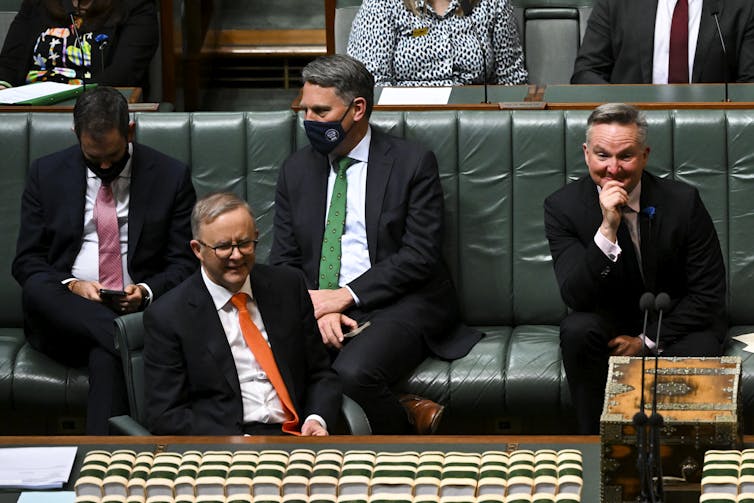
100% Renewables By 2030
Australia’s energy grid is responsible for 33% of our national emissions. Today, 59% of our electricity comes from coal-fired power plants.
Renewables are not just a clean form of energy – they are also the cheapest form of new energy. Our analysis suggests Australia should aim to achieve 100% renewables by 2030.
We must also increase overall power generation by around 40% this decade to make steep inroads into electrifying other sectors of the economy.
Here’s how to do it:
1. Enable transmission infrastructure: the federal government has promised A$20 billion for transmission infrastructure. This is crucial. To connect renewables to the grid, we need new transmission lines, and lots of them. The total length of transmission will need to be about 24 times what it is now.
2. Boost storage: to support grid security, we’ll need lots of electricity storage – think grid-scale batteries and pumped-hydro. To encourage greater investment the federal government should set a mandatory Renewable Energy Storage target, with specific goals for additional storage each year to 2030.
3. Upskill Australians: a new energy system will need skilled workers. The federal government must help workers upskill for clean trades through new investment in TAFE courses and electrical apprenticeships.
4. Establish a National Energy Transition Authority: this new organisation should set closure dates and develop transition plans for all coal-fired power stations by 2024, and support communities through the process.
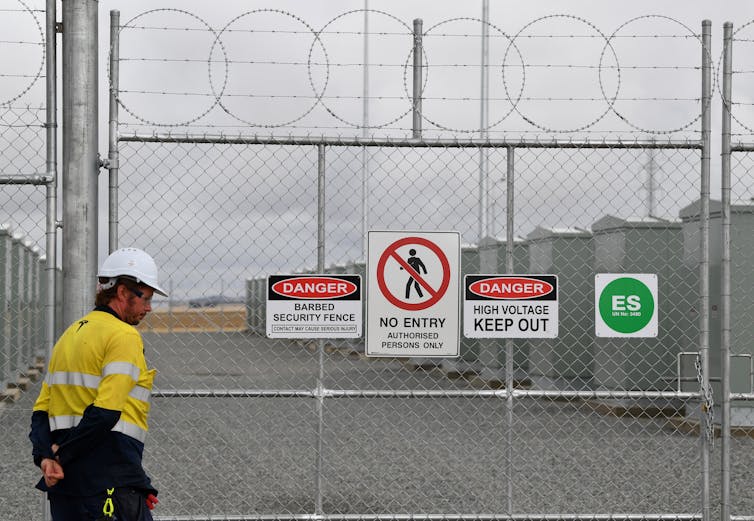
Clean Up Transport
Australia’s transport sector is responsible for 19% of national greenhouse gas emissions. By the end of this decade, transport emissions should be halved. Almost all new cars in Australia will need to be zero-emissions vehicles, and we’ll need major improvements in public and active transport infrastructure and use.
How do we get there?
5. Fuel efficiency: the federal government should implement mandatory fuel efficiency standards. Already common across the developed world, these standards encourage auto companies to supply more low and zero-emissions vehicles to the market.
The standards can be made more stringent over time, ensuring an orderly shift to zero-emissions vehicles. Without them, Australia risks becoming a dumping ground for polluting older-model cars – while the rest of the world charges ahead.
6. Ditch dirty diesel: Governments – both state and federal – need to invest in cleaner and more convenient public transport. A key first step is replacing diesel buses with a renewable electric fleet.

Net-Zero Buildings
Some 20% of Australia’s emissions are created by the building sector. (It should be noted, this figure includes electricity consumed in buildings, which is also counted as emissions from the energy sector). To reach our climate goals we’ll need to change the way our homes, businesses and other buildings are constructed and run.
This should be done by:
7. Tightening building rules: The National Construction Code must be tightened so all new homes are net-zero emissions – through energy efficient design, rooftop solar and all-electric appliances.
By 2025 gas connections should be banned for new homes, and new gas appliances should be banned for established homes. This would ensure the move to cheaper and cleaner forms of heating and cooking.
Households will also need government support to refit their homes with electric appliances, through incentive programs and concessional finance. As Australians switch energy-efficient renewables-powered homes, they’ll save on bills.

Overhaul Industry
Australia’s industrial sector creates 34% of our national emissions – and that’s excluding electricity use. These emissions must be halved, by increasing energy efficiency, electrifying processes where possible, switching fuels and phasing out fossil fuel extraction.
At the same time, we must seize new economic opportunities for industry in a future low-carbon world.
Reaching this goal will require:
8. Proper rules for big polluters: The federal government must reform what’s known as the “safeguard mechanism” to ensure big polluters do their fair share to cut emissions. This includes government incentives to drive the steepest emissions reduction possible.
Redirect Public Spending
Public spending must be aligned with the net-zero goal. That means:
9. No more handouts: federal and state governments spent an estimated $11.6 billion on subsidies for the fossil fuel industry last financial year, up $1.3 billion on the previous year. These handouts, such as fuel tax credits, must stop.
10. Create a climate and energy investment plan: the federal government should introduce climate budget statements outlining how taxpayer investment is aligned with the goal of rapidly reducing emissions.
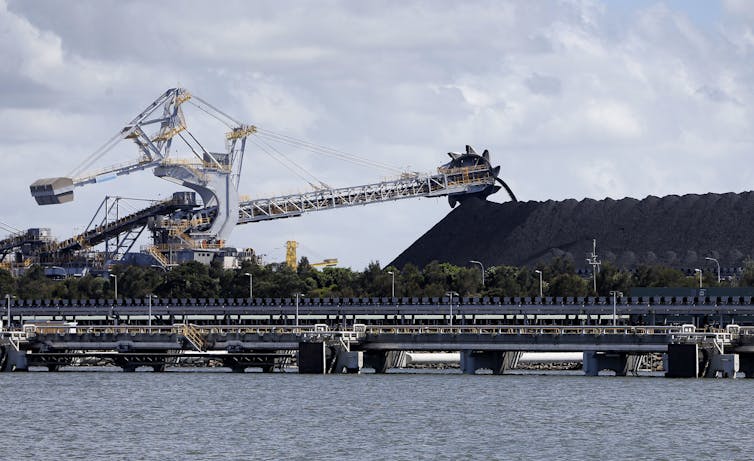
Time To Get Started
Australia has already warmed by around 1.4℃ since pre-industrial times. We’re suffering significant losses from accelerating climate change, and worse is on the way.
The passing of the climate bill into law has set the floor for action. Now, we must immediately build our cleaner future – because waiting until the 2030s will be much too late.![]()
Wesley Morgan, Research Fellow, Griffith Asia Institute, Griffith University
This article is republished from The Conversation under a Creative Commons license. Read the original article.
‘The most significant environmentalist in history’ is now king. Two Australian researchers tell of Charles’ fascination with nature
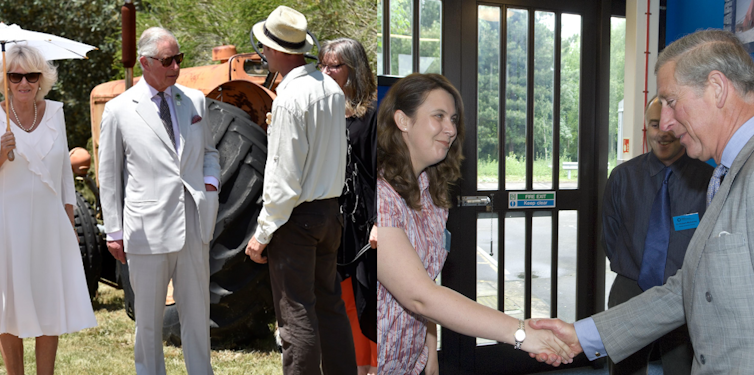
The natural world is close to the heart of Britain’s new King Charles III. For decades, he’s campaigned on environmental issues such as sustainability, climate change and conservation – often championing causes well before they were mainstream concerns.
In fact, Charles was this week hailed as “possibly most significant environmentalist in history”. Upon his elevation to the throne, the new king is expected to be less outspoken on environmental issues. But his advocacy work have helped create a momentum that will continue regardless.
As Prince of Wales, Charles regularly met scientists and other experts to learn more about environmental research in Britain and abroad. Here, two Australian researchers recall encounters with the new monarch that left an indelible impression.
Nerilie Abram, Australian National University
In 2008, I was a climate scientist working on ice cores at the British Antarctic Survey in Cambridge. On one memorable day, Prince Charles visited the facility – and I was tasked with giving him a tour.
At the time, I’d just returned from James Ross Island, near the northern tip of the Antarctic Peninsula. There, at one of the fastest warming regions on Earth, I’d helped collect a 364-metre-long ice core.
Ice cores are cylinders of ice drilled out of an ice sheet or glacier. They’re an exceptional record of past climate. In particular, they contain small bubbles of air trapped in the ice over thousands of years, telling us the past concentration of atmospheric gases.
We started the tour by showing Prince Charles a video of how we collect ice cores. We then ventured into the -20℃ freezer and held a slice of ice core up to the lights to see the tiny, trapped bubbles of ancient atmosphere.
Outside the freezer, we listened to the popping noises as the ice melted and the bubbles of ancient air were released into the atmosphere of the lab.
Holding a piece of Antarctic ice is a profound experience. With a bit of imagination, you can cast your mind back to what was happening in human history when the air inside was last circulating.
Prince Charles embraced this idea during the tour, making a connection back to the British monarch that would have been on the throne at the time.
All this led into a discussion about climate change. Ice cores show us the natural rhythm of Earth’s climate, and the unprecedented magnitude and speed of the changes humans are now causing.
At the time of the 2008 visit, carbon dioxide levels in the atmosphere had reached 385 parts per million - around 100 parts per million higher than before the Industrial Revolution. Today we are at 417 parts per million, and still rising each year.
In 2017, Prince Charles co-authored a book on climate change. It includes a section on ice cores, featuring the same carbon dioxide data I showed him a decade earlier.
Last year, the royal urged Australia’s then Prime Minister Scott Morrison to attend the COP26 climate summit at Glasgow, warning of a “catastrophic” impact to the planet if the talks did not lead to rapid action.
And in March this year, the prince sent a message of support to people devastated by floods in Queensland and New South Wales, and said:
“Climate change is not just about rising temperatures. It is also about the increased frequency and intensity of dangerous weather events, once considered rare.”
As prince, Charles used his position to highlight the urgency of climate change action. His efforts have helped to bring those messages to many: from young children to business people and world leaders.
He may no longer speak as loudly on these issues as king. But his legacy will continue to drive the climate action our planet needs.
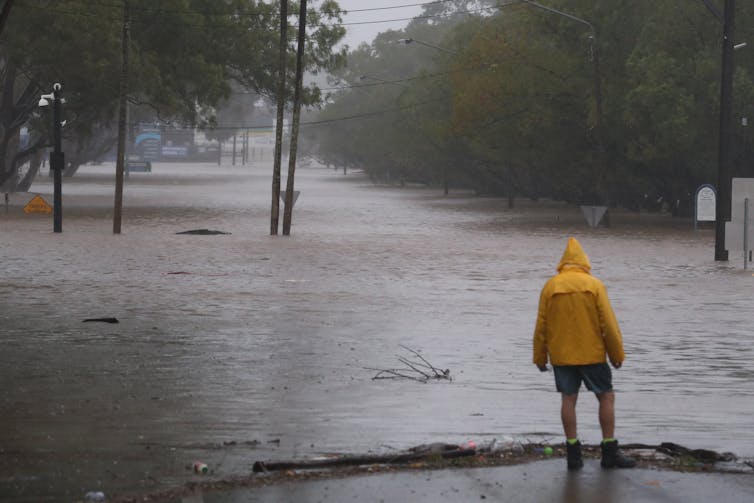
Peter Newman, Curtin University
In the 1970s, being an environmentalist was lonely work. It meant years of standing up for something that people thought was a bit marginal. But even back then Prince Charles – now King Charles III – was an environmental hero, advocating on what we needed to do.
I met the Prince of Wales in 2015. He and Camilla, the Duchess of Cornwall, visited Perth on the last leg of their Australia tour. I was among a group of Order of Australia recipients asked to meet the prince at Government House. I spoke to him about my lifelong passion – sustainability, including regenerative agriculture.
I knew earlier in their trip, Charles had toured the orchard at Oranje Tractor Wine, an organic and sustainable wine producer on Western Australia’s south coast. The vineyard is run by my friend Murray Gomm and his partner, Pam Lincoln, and I’d encouraged them over the years. They’d started winning awards, and it became even more special when the prince came down and blessed it!
The Oranje Tractor is now a net-zero-emissions venture: the carbon dioxide it sucks up from the atmosphere and into the soil is well above that emitted from its operations.
Charles’ eyes really lit up when I mentioned the Oranje Tractor. He was trying to do similar things in his gardening and at his farms – avoiding pesticides and sucking carbon from the atmosphere back into the soil.
Charles has that same knack the Queen had – an extraordinary ability to really listen and engage. To meet him, and see he’s been involved in sustainability as long as I have, it was validating and inspirational.
Now he’s king, Charles will be a little more constrained in his comments about environment issues. But I don’t think you can change who you are. He will just be more subtle about how he goes about it.
Climate change is now at the forefront of the global agenda. But the world needs to accelerate its emissions reduction commitments. If we don’t move fast enough, King Charles will no doubt raise a royal eyebrow – and that’s enough.![]()
Nicole Hasham, Energy + Environment Editor, The Conversation
This article is republished from The Conversation under a Creative Commons license. Read the original article.
A rapid shift to electric vehicles can save 24,000 lives and leave us $148bn better off over the next 2 decades

Reducing air pollution from road transport will save thousands of lives and improve the health of millions of Australians. One of the quickest ways to do this is to accelerate the current slow transition to electric vehicles.
Our newly published research evaluated the costs and benefits of a rapid transition. In one scenario, Australia matches the pace of transition of world leaders such as Norway. Our modelling estimates this would save around 24,000 lives by 2042. The resulting greenhouse emission reductions over this time would almost equal Australia’s current total annual emissions from all sources.
We also calculated the total costs and benefits through to 2042. Australia would be about A$148 billion better off overall with a rapid transition.
Air Pollution Causes Thousands Of Deaths
Every year, around 2,600 deaths in Australia are attributed to fine-particle air pollution. The main sources of this pollution are transport and industrial activities such as mining and energy generation.
An estimated 1,715 deaths were attributed to vehicle exhaust emissions in 2015. This was 42% more than the road toll that year.
Vehicle emissions increase respiratory infections as well, particularly in young children. Transport pollution contributes to many diseases, including lung cancer, heart disease, pneumonia, asthma and diabetes. It has also been linked to Alzheimer’s disease.
A 2019 study by the Electric Vehicle Council and Asthma Australia found vehicle emissions had 21,000 serious health impacts each year in New South Wales alone.
A Grattan Institute study last month showed exhaust-pipe pollutants from trucks kill more than 400 Australians every year.
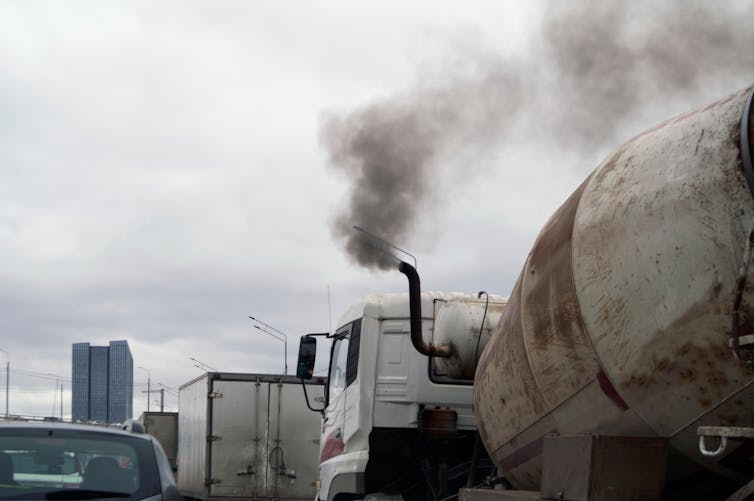
The Benefits Greatly Outweigh The Costs
Our new Swinburne University of Technology research evaluated the benefits of a transition to electric vehicles by considering public health, household and emissions reductions savings. We compared the benefits with costs, including charging infrastructure outlay, higher purchase prices for electric vehicles and green energy package costs – for household solar panels, battery storage and charging points.
Each electric vehicle was considered to have been bought along with a green energy package. The package minimises emissions and demands on electricity grid capacity, while increasing the benefits for households.
The study explored three scenarios:
slow scenario – business-as-usual, with electric vehicle sales increasing slowly from the current rate (a 5% increase in the first year, followed by a 10% yearly increase)
accelerated market-based scenario – aligns with the highest rates of adoption around the world like those in Norway (where 64% of new vehicles sold in 2021 were battery-powered), increasing by 5% every year
aggressive regulatory scenario – assumes all new vehicle sales would be electric in the base year as a result of government regulation.
The main differences between the scenarios are the rate of electric vehicle uptake (once consumers decide to retire their current vehicles) and the degree of government intervention.
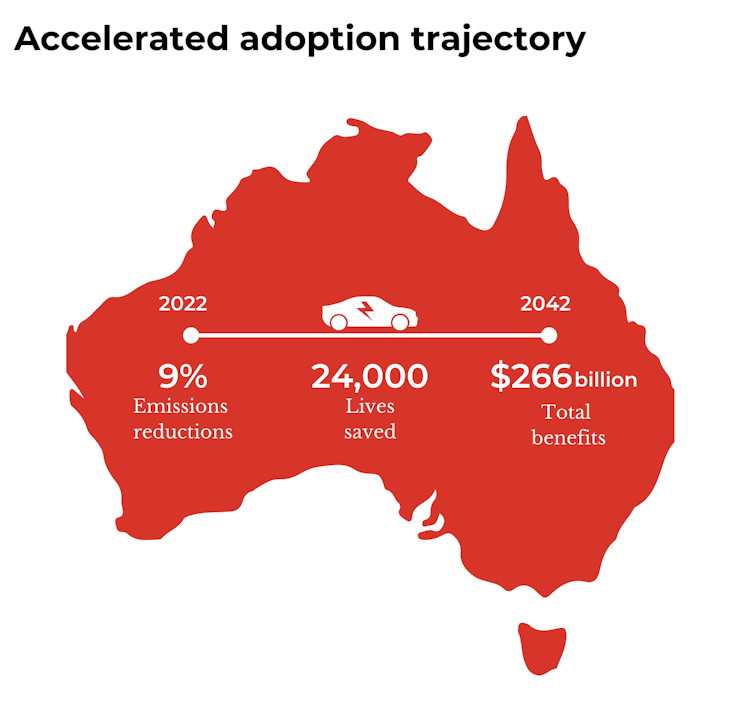
The research found the business-as-usual scenario undermines national efforts to reduce the loss of life and cut emissions. It also found the aggressive strategy would have to overcome massive barriers given Australia trails many other countries in adopting electric vehicles.
The accelerated adoption strategy, however, is well aligned with uptake in other nations. Their example shows it can be achieved using progressive policies and incentives.
If implemented, the accelerated scenario could reduce the loss of life by around 24,000 by 2042. The reduction in emissions over this time would be 444 million tonnes of carbon dioxide equivalent, or 91% of Australia’s emissions from all sources in 2021. The cost would be around $118 billion, less than half of the total benefits of $266 billion.
Putting Us On Track For Emissions Targets
The new Climate Change Act mandates targets of a 43% cut in emissions by 2030 and net-zero emissions by 2050. Our research shows effective electric vehicle policies can help achieve these targets.
Such policies can be adopted from nations that have made rapid progress on electrifying their transport sectors. These policies include strict and mandatory fuel efficiency standards, investment in electric vehicle charging stations and standardisation of charging infrastructure. They also include financial incentives to buy and run electric vehicles, and cheap loans to help households and freight operators with purchase costs.
Importantly, these nations recognise that electric vehicles are not a remedy for all transport challenges. They should be complemented by strategies to manage travel demand, reduce the numbers of cars and journeys by car, and improve access to public transport.
We Shouldn’t Accept So Many Avoidable Deaths
Without a rapid shift to electric vehicles, Australia risks losing at least 1,200 lives a year – deaths that we could avoid – over the next 20 years.
The loss of life would be equivalent to six planes, each carrying 200 passengers, falling out of the sky every year and killing everyone on board. We don’t accept this in air travel, and we should not accept the loss of life to preventable air pollution.
Australia has a feasible rapid pathway to decarbonise its transport sector. Our findings show the benefits to society and the planet are hard to dismiss.![]()
Hussein Dia, Professor of Future Urban Mobility, Swinburne University of Technology; Christian A. Nygaard, Associate Professor in Social Economics, Swinburne University of Technology; Krzysztof Dembek, Senior Lecturer Social Impact, Swinburne University of Technology, and Magnus Moglia, Associate Professor, Swinburne University of Technology
This article is republished from The Conversation under a Creative Commons license. Read the original article.
What caused the world’s largest die-off of mangroves? A wobble in the Moon’s orbit is partly to blame
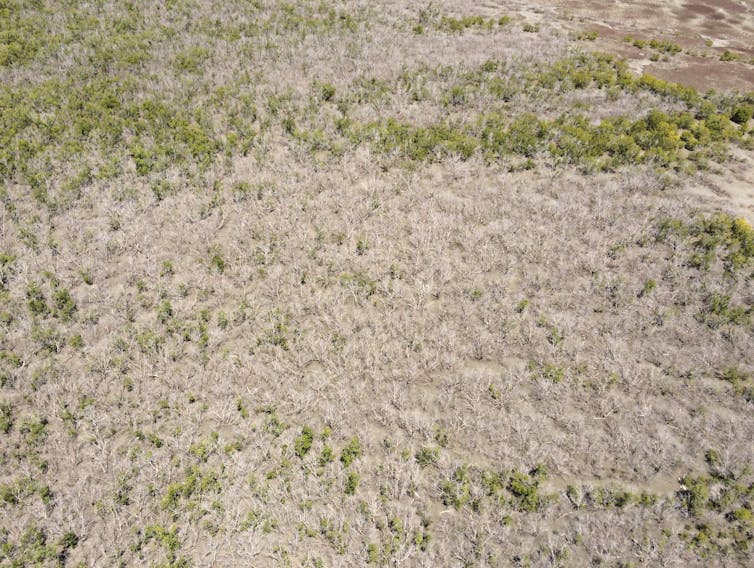
Over the summer of 2015, 40 million mangroves died of thirst. This vast die-off – the world’s largest ever recorded – killed off rich mangrove forests along fully 1,000 kilometres of coastline on Australia’s Gulf of Carpentaria.
The question is, why? Last month, scientists found a culprit: a strong El Niño event, which led to a temporary fall in sea level. That left mangroves, which rely on tides covering their roots, high and dry during an unusually dry early monsoon season.
Case closed. Or is it? While evidence clearly implicates El Niño, we found this climate cycle had a very large accomplice: the Moon.
In our study, released today, we mapped the expansion and contraction of mangrove forest cover over the past 40 years, and found clear evidence that the Moon’s orbital wobble had an effect.
Our mapping also shows mangroves are expanding and their canopy thickening across the entire continent, which is most likely due to higher carbon dioxide levels. Spectacular though it was, the Gulf of Carpentaria mangrove dieback event was entirely natural.
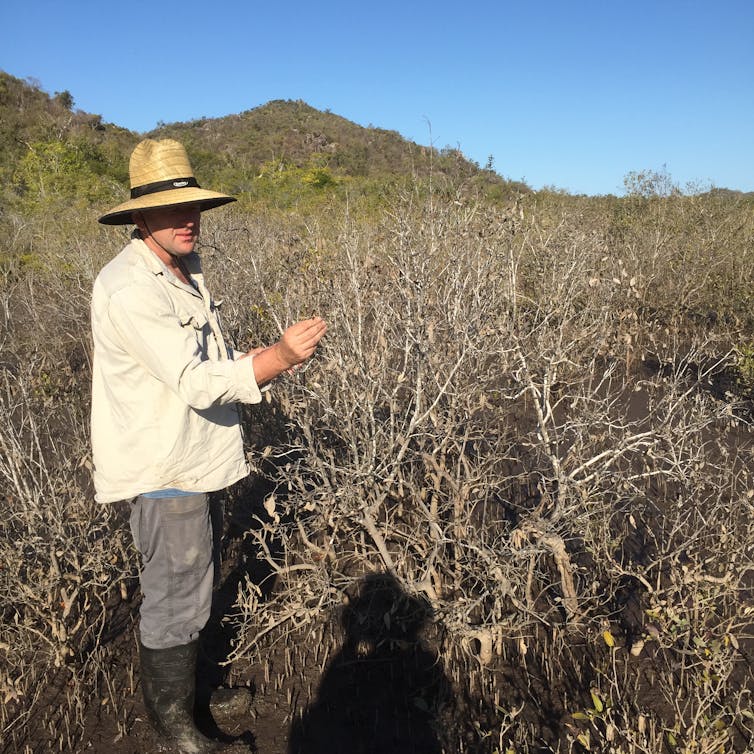
What Clues Gave Away The Moon’s Role?
During El Niño cycles like the one in 2015, sea levels fall around Australia and other countries in the western Pacific.
But these climate cycles affect the whole Indo-Australian region. If El Niño was the main cause, mangroves elsewhere should have been hit too. But the deaths of these tidal-flat dwelling shrubs and trees were largely localised to the Gulf of Carpentaria. Death rates were highest along shorelines that experience the full range of the tide. By contrast, mangroves continued to thrive at the tidal limits of the estuaries, far into the floodplains where climatic effects ought to be most strongly felt.
That’s where the Moon comes in – and particularly the “lunar wobble”. Back in 1728, astronomers noticed the plane in which the Moon orbits Earth isn’t fixed. Instead, it wobbles up and down, a bit like a spinning coin as it begins to slow.
When we mapped the extent and distribution of Australian mangrove forests over the past 40 years, we found clear signs of the Moon’s wobble at work. This 18.6-year orbital cycle turns out to be the main reason why mangrove canopy expands and contracts around most of Australia’s coastlines – and explains the patterns of mangrove mortality in the Gulf of Carpentaria.
You might be wondering why the wobble has such influence over whether mangroves live or die. It’s the tides. The wobble changes how the Moon’s gravity pulls on the world’s oceans, so periods of exceptionally high tides are followed by exceptionally low tides 9.3 years later.

Research by NASA scientists suggests this cycle is likely to lead to major coastal flooding in the early 2030s, as extreme high tides meet accelerating sea-level rise.
The lunar-mangrove cycle is clearly visible from above. When we mapped changes to dense mangrove forest in Northwest and Western Australia, we saw clear peaks in closed canopy – where mangrove leaves and branches thicken to cover more than 80% of the ground – coinciding with the highest tidal phase of the lunar cycle.
When the tides are at their highest, water inundates mangroves and brings nutrients, which accelerate growth. These periods potentially influence how much blue carbon is stored by mangroves over thousands of square kilometres.
But when the tides are at their lowest, mangroves can’t get the water they need. Over 2015-2016, the lunar wobble reduced tide range in the Gulf of Carpentaria – enough to slash tides by an estimated 40cm. Earlier mangrove dieback events in 1998 and 1982 also coincided with these troughs.
In 2015, tides along Australia’s northern coastline fell further still under the influence of El Niño, which moves seawater to the eastern Pacific. The result of the overlapping lunar and climate cycle in the Gulf of Carpentaria was the mass death of mangroves.
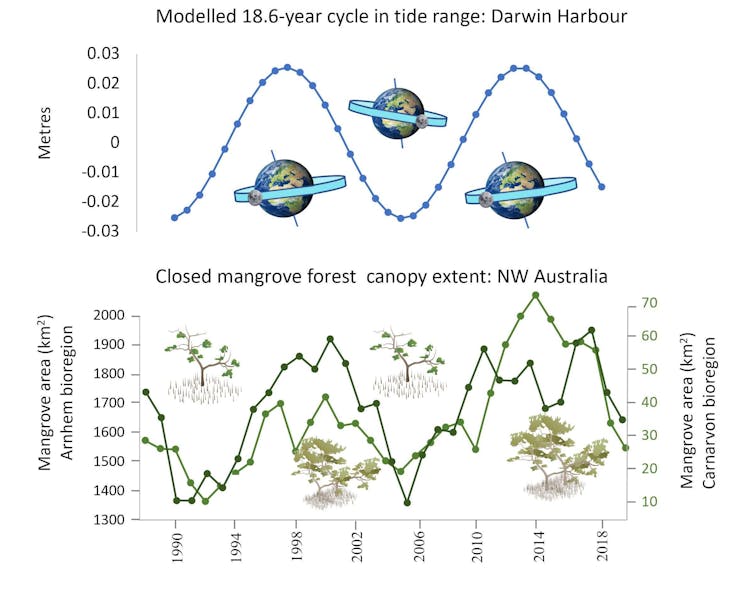
One challenge we had was to distinguish between the effects of El Niño and the lunar wobble, given they tend to occur in the same time period in the western Pacific. Some scientists have even suggested the lunar wobble may contribute to intense El Niño events.
To tease out the two causes, we relied on a quirk in the lunar wobble – and a quirk in the coastline.
The lunar wobble’s timing of the high and low tide range periods is reversed between coastlines with two high tides each day (semi-diurnal tides) and those receiving one high tide each day (diurnal tides).
The Gulf of Carpentaria is one of the few coastlines in Australia with diurnal tides. Most other coastlines have two high tides each day. Put together, this meant that in 2015, semi-diurnal coastlines had bigger-than-usual tides, while rare diurnal coastlines like those along the gulf had smaller-than-usual tides.
This explains why mangroves in the semi-diurnal coastlines directly next to the Gulf of Carpentaria were spared over the 2015-16 summer.
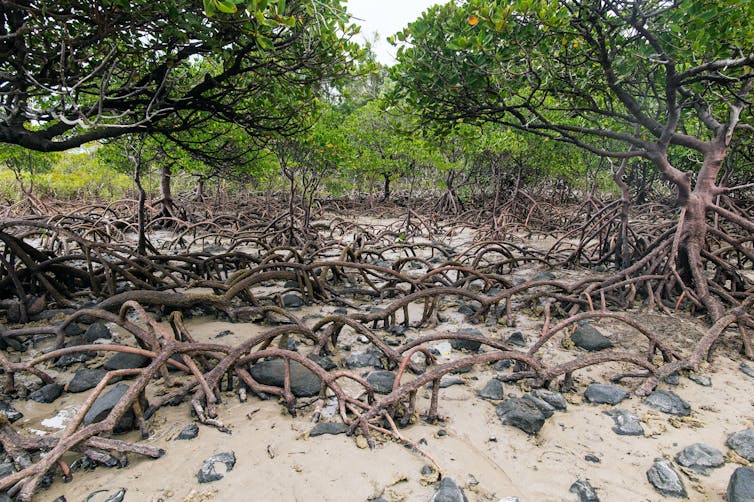
The northern coastlines next to the gulf were in the big-tide, high-productivity phase of the 18.6-year cycle and so were protected from El Niño. In the diurnal Gulf of Carpentaria, the small tide phase of the lunar wobble cycle combined with El Niño. Lower sea levels and lower tidal range pushed mangroves over the edge.
Interestingly, mangroves kept growing near the tidal head of rivers in the gulf despite the El Niño, because the effect of the lunar wobble was less pronounced upriver.
This is good news for mangroves. We now know short-term natural climate cycles like El Niño likely cannot cause widespread mangrove deaths by themselves. And we can anticipate the danger times when it coincides with the low tides brought by the lunar wobble.
While mangroves still face an uncertain future adapting to a world of higher seas, we can chalk the 2015 mass death up to “natural causes”. ![]()
Neil Saintilan, Professor, School of Natural Sciences, Macquarie University
This article is republished from The Conversation under a Creative Commons license. Read the original article.
Pittwater Reserves: Histories + Notes + Pictorial Walks
A History Of The Campaign For Preservation Of The Warriewood Escarpment by David Palmer OAM and Angus Gordon OAM
America Bay Track Walk - photos by Joe Mills
An Aquatic June: North Narrabeen - Turimetta - Collaroy photos by Joe Mills
Angophora Reserve Angophora Reserve Flowers Grand Old Tree Of Angophora Reserve Falls Back To The Earth - History page
Annie Wyatt Reserve - A Pictorial
Avalon's Village Green: Avalon Park Becomes Dunbar Park - Some History + Toongari Reserve and Catalpa Reserve
Bairne Walking Track Ku-Ring-Gai Chase NP by Kevin Murray
Bangalley Headland Bangalley Mid Winter
Banksias of Pittwater
Barrenjoey Boathouse In Governor Phillip Park Part Of Our Community For 75 Years: Photos From The Collection Of Russell Walton, Son Of Victor Walton
Barrenjoey Headland: Spring flowers
Barrenjoey Headland after fire
Bayview Baths
Bayview Wetlands
Beeby Park
Bilgola Beach
Botham Beach by Barbara Davies
Bungan Beach Bush Care
Careel Bay Saltmarsh plants
Careel Bay Birds
Careel Bay Clean Up day
Careel Bay Playing Fields History and Current
Careel Creek
Careel Creek - If you rebuild it they will come
Centre trail in Ku-ring-gai Chase National Park
Chiltern Track- Ingleside by Marita Macrae
Clareville Beach
Clareville/Long Beach Reserve + some History
Coastal Stability Series: Cabbage Tree Bay To Barrenjoey To Observation Point by John Illingsworth, Pittwater Pathways, and Dr. Peter Mitchell OAM
Cowan Track by Kevin Murray
Curl Curl To Freshwater Walk: October 2021 by Kevin Murray and Joe Mills
Currawong and Palm Beach Views - Winter 2018
Currawong-Mackerel-The Basin A Stroll In Early November 2021 - photos by Selena Griffith
Currawong State Park Currawong Beach + Currawong Creek
Deep Creek To Warriewood Walk photos by Joe Mills
Drone Gives A New View On Coastal Stability; Bungan: Bungan Headland To Newport Beach + Bilgola: North Newport Beach To Avalon + Bangalley: Avalon Headland To Palm Beach
Duck Holes: McCarrs Creek by Joe Mills
Dunbar Park - Some History + Toongari Reserve and Catalpa Reserve
Dundundra Falls Reserve: August 2020 photos by Selena Griffith - Listed in 1935
Elsie Track, Scotland Island
Elvina Track in Late Winter 2019 by Penny Gleen
Elvina Bay Walking Track: Spring 2020 photos by Joe Mills
Elvina Bay-Lovett Bay Loop Spring 2020 by Kevin Murray and Joe Mills
Fern Creek - Ingleside Escarpment To Warriewood Walk + Some History photos by Joe Mills
Iluka Park, Woorak Park, Pittwater Park, Sand Point Reserve, Snapperman Beach Reserve - Palm Beach: Some History
Ingleside
Ingleside Wildflowers August 2013
Irrawong - Ingleside Escarpment Trail Walk Spring 2020 photos by Joe Mills
Irrawong - Mullet Creek Restoration
Katandra Bushland Sanctuary - Ingleside
Lucinda Park, Palm Beach: Some History + 2022 Pictures
McCarrs Creek
McCarr's Creek to Church Point to Bayview Waterfront Path
McKay Reserve
Mona Vale Beach - A Stroll Along, Spring 2021 by Kevin Murray
Mona Vale Headland, Basin and Beach Restoration
Mount Murray Anderson Walking Track by Kevin Murray and Joe Mills
Mullet Creek
Narrabeen Creek
Narrabeen Lagoon Catchment: Past Notes Present Photos by Margaret Woods
Narrabeen Lagoon State Park
Narrabeen Lagoon State Park Expansion
Narrabeen Rockshelf Aquatic Reserve
Nerang Track, Terrey Hills by Bea Pierce
Newport Bushlink - the Crown of the Hill Linked Reserves
Newport Community Garden - Woolcott Reserve
Newport to Bilgola Bushlink 'From The Crown To The Sea' Paths: Founded In 1956 - A Tip and Quarry Becomes Green Space For People and Wildlife
Pittwater spring: waterbirds return to Wetlands
Pittwater's Lone Rangers - 120 Years of Ku-Ring-Gai Chase and the Men of Flowers Inspired by Eccleston Du Faur
Pittwater's Parallel Estuary - The Cowan 'Creek
Resolute Track at West Head by Kevin Murray
Resolute Track Stroll by Joe Mills
Riddle Reserve, Bayview
Salvation Loop Trail, Ku-Ring-Gai Chase National Park- Spring 2020 - by Selena Griffith
Seagull Pair At Turimetta Beach: Spring Is In The Air!
Stapleton Reserve
Stapleton Park Reserve In Spring 2020: An Urban Ark Of Plants Found Nowhere Else
Stony Range Regional Botanical Garden: Some History On How A Reserve Became An Australian Plant Park
The Chiltern Track
The Resolute Beach Loop Track At West Head In Ku-Ring-Gai Chase National Park by Kevin Murray
Topham Track Ku-Ring-Gai Chase NP, August 2022 by Joe Mills and Kevin Murray
Towlers Bay Walking Track by Joe Mills
Trafalgar Square, Newport: A 'Commons' Park Dedicated By Private Landholders - The Green Heart Of This Community
Tranquil Turimetta Beach, April 2022 by Joe Mills
Turimetta Beach Reserve by Joe Mills, Bea Pierce and Lesley
Turimetta Beach Reserve: Old & New Images (by Kevin Murray) + Some History
Turimetta Headland
Warriewood Wetlands and Irrawong Reserve
Whale Beach Ocean Reserve: 'The Strand' - Some History On Another Great Protected Pittwater Reserve
Wilshire Park Palm Beach: Some History + Photos From May 2022
Winji Jimmi - Water Maze

New Shorebirds WingThing For Youngsters Available To Download
A Shorebirds WingThing educational brochure for kids (A5) helps children learn about shorebirds, their life and journey. The 2021 revised brochure version was published in February 2021 and is available now. You can download a file copy here.
If you would like a free print copy of this brochure, please send a self-addressed envelope with A$1.10 postage (or larger if you would like it unfolded) affixed to: BirdLife Australia, Shorebird WingThing Request, 2-05Shorebird WingThing/60 Leicester St, Carlton VIC 3053.

 Shorebird Identification Booklet
Shorebird Identification Booklet
The Migratory Shorebird Program has just released the third edition of its hugely popular Shorebird Identification Booklet. The team has thoroughly revised and updated this pocket-sized companion for all shorebird counters and interested birders, with lots of useful information on our most common shorebirds, key identification features, sighting distribution maps and short articles on some of BirdLife’s shorebird activities.
The booklet can be downloaded here in PDF file format: http://www.birdlife.org.au/documents/Shorebird_ID_Booklet_V3.pdf
Paper copies can be ordered as well, see http://www.birdlife.org.au/projects/shorebirds-2020/counter-resources for details.
Download BirdLife Australia's children’s education kit to help them learn more about our wading birdlife
Shorebirds are a group of wading birds that can be found feeding on swamps, tidal mudflats, estuaries, beaches and open country. For many people, shorebirds are just those brown birds feeding a long way out on the mud but they are actually a remarkably diverse collection of birds including stilts, sandpipers, snipe, curlews, godwits, plovers and oystercatchers. Each species is superbly adapted to suit its preferred habitat. The Red-necked Stint is as small as a sparrow, with relatively short legs and bill that it pecks food from the surface of the mud with, whereas the Eastern Curlew is over two feet long with a exceptionally long legs and a massively curved beak that it thrusts deep down into the mud to pull out crabs, worms and other creatures hidden below the surface.
Some shorebirds are fairly drab in plumage, especially when they are visiting Australia in their non-breeding season, but when they migrate to their Arctic nesting grounds, they develop a vibrant flush of bright colours to attract a mate. We have 37 types of shorebirds that annually migrate to Australia on some of the most lengthy and arduous journeys in the animal kingdom, but there are also 18 shorebirds that call Australia home all year round.
What all our shorebirds have in common—be they large or small, seasoned traveller or homebody, brightly coloured or in muted tones—is that each species needs adequate safe areas where they can successfully feed and breed.
The National Shorebird Monitoring Program is managed and supported by BirdLife Australia.
This project is supported by Glenelg Hopkins Catchment Management Authority and Hunter Local Land Services through funding from the Australian Government’s National Landcare Program. Funding from Helen Macpherson Smith Trust and Port Phillip Bay Fund is acknowledged.
The National Shorebird Monitoring Program is made possible with the help of over 1,600 volunteers working in coastal and inland habitats all over Australia.
The National Shorebird Monitoring program (started as the Shorebirds 2020 project initiated to re-invigorate monitoring around Australia) is raising awareness of how incredible shorebirds are, and actively engaging the community to participate in gathering information needed to conserve shorebirds.
In the short term, the destruction of tidal ecosystems will need to be stopped, and our program is designed to strengthen the case for protecting these important habitats.
In the long term, there will be a need to mitigate against the likely effects of climate change on a species that travels across the entire range of latitudes where impacts are likely.
The identification and protection of critical areas for shorebirds will need to continue in order to guard against the potential threats associated with habitats in close proximity to nearly half the human population.
Here in Australia, the place where these birds grow up and spend most of their lives, continued monitoring is necessary to inform the best management practice to maintain shorebird populations.
BirdLife Australia believe that we can help secure a brighter future for these remarkable birds by educating stakeholders, gathering information on how and why shorebird populations are changing, and working to grow the community of people who care about shorebirds.
To find out more visit: http://www.birdlife.org.au/projects/shorebirds-2020/shorebirds-2020-program
Aussie Bread Tags Collection Points

Be The Boss: I Want To Be A Marine Electrician
- Troubleshoot wiring and other electrical systems on marine equipment and make repairs
- Test low and high-voltage circuit systems for safety
- Work on power generators or other alternative sources of energy, like solar or wind power
- Wire and test the alarm and communication systems
- Monitor for potential electrical voltage threats
- Design and update bonding systems to protect the ship against weather elements
- Protect the boat's equipment using drip loops and heat shrinks
- Interpret and write technical reports and estimate repair costs
- Install wiring and electrical equipment when building new ships
- Install and configure generators
- Test marine electrical equipment like voltmeters and oscilloscopes for efficiency
- Electrical power generation and distribution
- The ship's boats engine and steering systems
- Propulsion systems (gas turbines, diesel and electrical engines, gear boxes, propellers, thrusters, and positioning systems)
- Electrical systems (alternators, batteries, charging systems, electrical switchboards, and corrosion protection systems)
- Auxiliary engineering systems (air-conditioning, refrigeration, generators, air compressor systems, stabilisers, winches, and cranes)
- Hull structures and fittings
- Free medical and dental
- Competitive salary package
- Incremental salary increases as you progress through training and ranks
- 16.4% superannuation
- Job security
- Career progression and development
- Good work/life balance
- Travel opportunities
- Excellent social and fitness facilities
- Subsidised housing
- Balance of shore and sea postings
- Great chef made meals at sea
- Variety of allowances
- Technical: Working as a marine electrician involves a lot of technical work. You will need to troubleshoot the electrical system, rewire systems and install equipment in the ship.
- Mechanical: Good mechanical skills are also useful as you will use certain tools and machinery to install and repair systems. A basic understanding of mechanics can be helpful.
- Problem-solving: A big part of the job of a marine electrician is identifying electrical problems and repairing them. This involves good troubleshooting skills and the ability to quickly come up with a solution.
- Project management: Marine electricians will often manage multiple projects at one time. They may complete projects for different ships and will need to manage time and delegate tasks.
- Knowledge of electrical systems: A good working knowledge of electrical systems in ships is important. In addition to reading and navigating electrical blueprints, marine electricians will need to know where to find certain access points and wires.
- Coast guard: Some marine electricians may choose to work with the U.S. government on military ships. If this is your preferred route, you may need special coast guard training.
- Knowledge of circuit breakers, transformers and high-voltage control panels: Working as a marine electrician, you are likely to work with each of these things. An apprenticeship can be a good way to learn these areas in-depth.
- Knowledge of certain safety protocols: Up-to-date safety protocols are needed as marine electricians often work on electrical systems near water. Knowledge of emergency protocols is needed.
Also Available:
- Be The Boss: I want To Be A Cabinet Maker
- Be The Boss: I Want To Be An Automotive Mechanic
- Be The Boss: I Want To Be A Biotechnologist
- Be The Boss: I Want To Be A Pilot
- Be The Boss: I Want To Be A Music Producer
- Be The Boss: I Want To Be A Gardener
- Be The Boss: I Want To Be A Builder
- Be The Boss: I Want To Be A Confectioner
- Be The Boss: I Want To Be A Ship's Captain
Word Of The Week: Galoot
Noun
slang, mainly US; a clumsy or uncouth person, someone who is awkward.
Galoot can be a mildly offensive term that originally referred to a marine or soldier on board ship, much like a modern sailor might use jarhead. Etymologist Anatoly Liberman points to the thirteenth century Italian galeot(t)o, “sailor, steersman,” as a possible source for galoot. others state: From Quranic Arabic jālūt, pronounced galūt in Egyptian Arabic, proper name equivalent to English Goliath, giant warrior of the ancient Philistine ethnicity; cf. connotations of derogatory uses of English.
It's basically an all-purpose term of mild contempt with humorous undertones while others state galoot can also be a term of affection. It was quite widely used from about 1900 to the 1940s but is now outdated and unfashionable even in its American heartland.
Compare Awkward;
lacking dexterity or skill (as in the use of hands); lacking ease or grace (as of movement or expression). From Middle English awkeward in the wrong direction, from awke turned the wrong way, from Old Norse ǫfugr; akin to Old High German abuh turned the wrong way
We found the oldest ever vertebrate fossil heart. It tells a 380 million-year-old story of how our bodies evolved
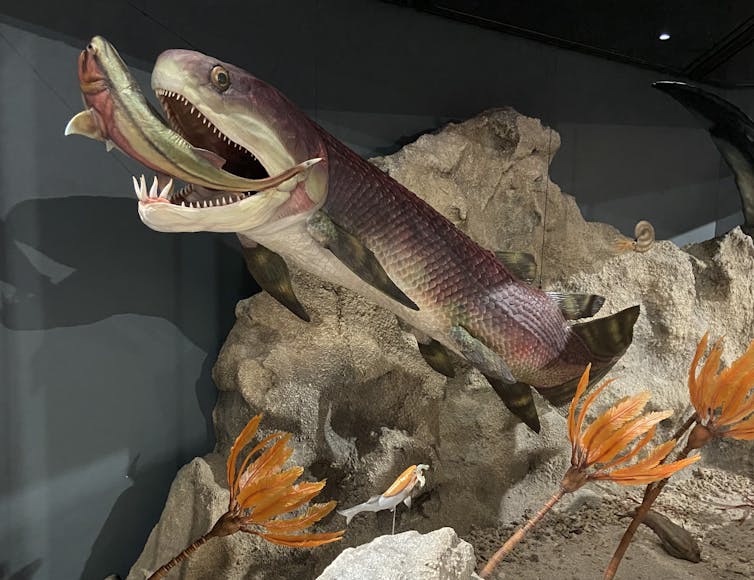
In the limestone ranges of Western Australia’s Kimberley region, near the town of Fitzroy Crossing, you’ll find one of the world’s best-preserved ancient reef complexes.
Here lie the remnants of myriad prehistoric marine animals, including placoderms, a prehistoric class of fish that represents some of our earliest jawed ancestors.
Placoderms were the rulers of the ancient seas, rivers and lakes. They were the most abundant and diverse fishes of the Devonian Period (419–359 million years ago) – but died out at the end in a mass extinction event.
Studying placoderms is important as they provide insight into the origins of the jawed vertebrate body plan (vertebrates are animals with backbones). For instance, placoderms have revealed when the first jaws, teeth, paired skull bones and paired limbs evolved. They’ve also taught us about the origins of internal fertilisation and live birth in vertebrate evolution.
Now, in a paper published in Science, we detail our findings of the oldest three-dimensionally preserved heart from a vertebrate – in this case a jawed vertebrate. This placoderm heart is about 380 million years old, and 250 million years older than the previous oldest vertebrate heart.
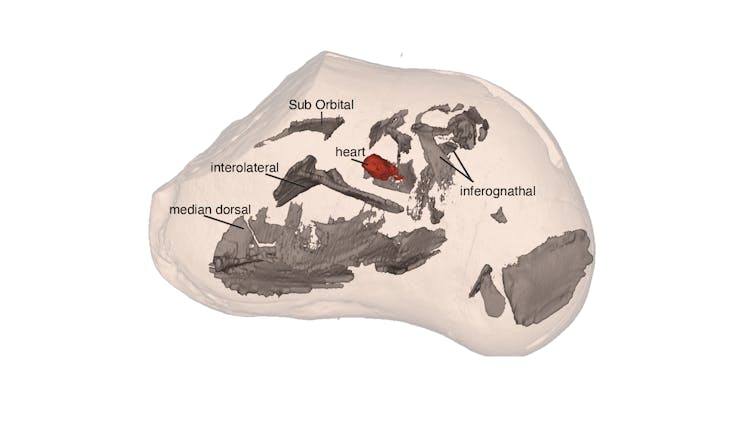
How Did We Do It?
Fish fossils from near Fitzroy Crossing were first reported from Gogo Station in the 1940s. But it wasn’t until the 1960s that beautiful 3D preservations were revealed, using a technique that removes rock from bones with weak acetic acid.
However, this technique proved to be a double-edged sword. While the fine details of the bony skeleton were uncovered, soft tissues in the fossils dissolved away. It wasn’t until 2000 that the first pieces of fossilised muscle were identified in placoderms.
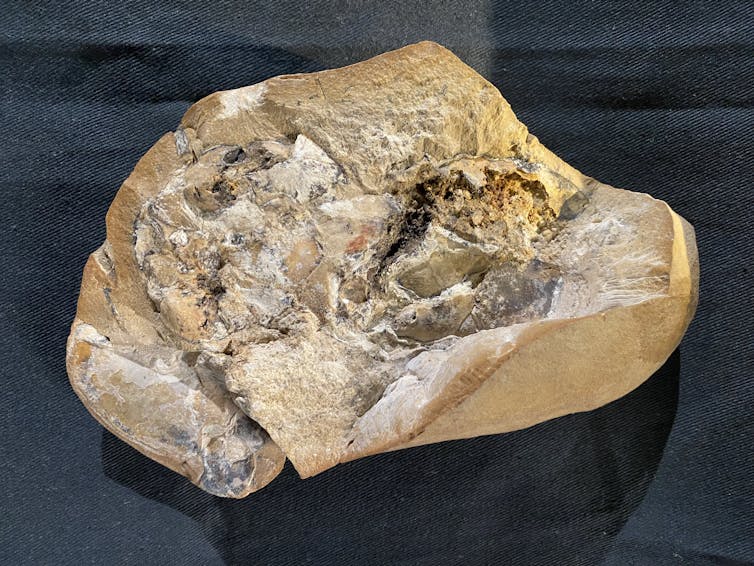
With the advent of an X-ray method called “synchrotron microtomography” – first used on the Gogo fossils in 2010 – more muscles were revealed from the Gogo placoderms, including neck and abdominal muscles.
Our work used this same technology to show, for the first time, the presence of a liver, stomach and intestines in a Devonian fish. Some of the specimens even showed remnants of their last meal: a crustacean.
We found the soft organs fossilised in an order of placoderms called arthrodires. These were the most common and diverse of all known placoderms, characterised by a unique joint between their head and trunk armour.
The Heart Of The Placoderm
The most exciting find for us was the heart. We found our first placoderm heart using synchrotron imagining.
Then while experimenting with a technology called neutron imaging, we discovered a second heart within a different specimen.
Life must have been nerve-racking in the Devonian seas, because placoderms literally had their hearts in their mouths!
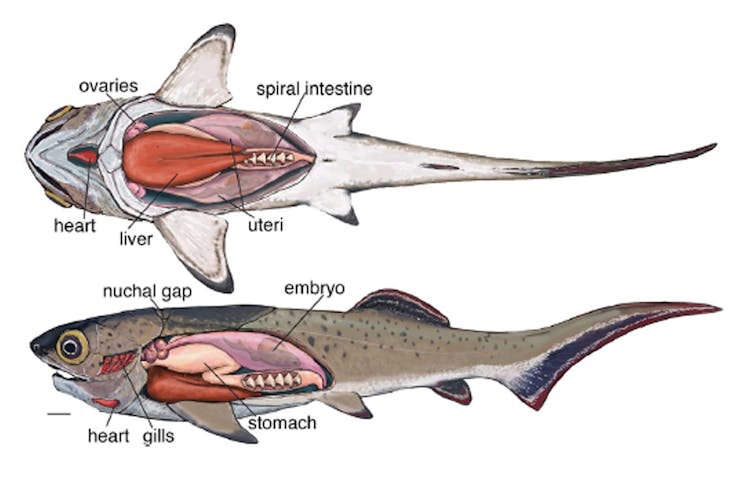
At this point in vertebrate evolution, the neck was so short that the heart was located at the back of the throat and under the gills.
Fishes that are even more primitive than arthrodires, such as the jawless lamprey, have their heart close to their liver. And the chambers of the heart (called the atrium and ventricle) sit side by side.
On the other hand, arthrodire placoderms had the heart in a more forward (anterior) position, at the back of the throat. And the atrium sat on top of the ventricle – similar to sharks and bony fishes today.
Today, 99% of all living vertebrates have jaws. Arthrodires provide the first anatomical evidence to support the hypothesis that, in jawed vertebrates, the repositioning of the heart to a more forward position was linked to the evolution of jaws and a neck.
But that’s not all. This movement of the heart would also have made room for lungs to develop.
So Did Placoderms Have Lungs?
One of the most challenging evolutionary questions today is whether lungs were present in the earliest jawed vertebrates. Although fish have gills, the presence of lungs in some fish can help with buoyancy, which is needed to sink and rise in the water.
Today, lungs are only present in primitive bony fishes such as lungfish and African reedfishes.
More advanced bony fish (such as the teleosts) stay afloat using a swim bladder, whereas sharks have neither lungs nor a swim bladder, and instead use a large fatty liver to help with buoyancy.
But what about ancient placoderms? Previous studies (which were somewhat controversial) suggested lungs were present in a primitive placoderm called Bothriolepis.
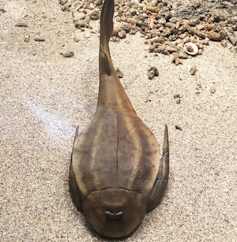
Our analysis of the arthrodires from Gogo reveals the structures thought to be lungs in Bothriolepis are in fact a liver with two lobes, so lungs are now thought to have been missing from placoderms.
Our discovery therefore shows a single origin for lungs in bony fishes (osteichthyans). The movement of the heart to a forward position from jawless fishes (Cyclostomata) would have allowed room for lungs to develop in later lineages.
The absence of lungs in placoderms suggests these fish relied on their liver for buoyancy, like modern sharks do.

A Crucial Site
The preservation of organs is a race against time. In some cases, an animal’s decomposition will aid soft tissue preservation, but too much decomposition and the soft tissues decay away. For excellent preservation the balance needs to be just right.
In the fossilised heart we found the atrium and ventricles are shown clearly, while the conus arteriosus – a section of the heart that directs blood from the ventricle to the arteries – is not as well preserved.
Being able to make these discoveries before they’re lost forever is crucial if we are to fully understand the early evolution of vertebrates, including the origins of the human body plan.
So beyond our immediate findings, our work has reinforced the significance of the Gogo site in the Kimberley as one of the world’s most important sites for carrying out this work. ![]()
Kate Trinajstic, John Curtin Distinguished Professor, Molecular and Life Sciences, Curtin University and John Long, Strategic Professor in Palaeontology, Flinders University
This article is republished from The Conversation under a Creative Commons license. Read the original article.
‘He was deadly, a deadly man’: remembering the incredible life and work of Uncle Jack Charles
Julie Andrews, La Trobe UniversityThe family of Uncle Jack Charles have given permission for his name and images to be used.
Aboriginal Melbourne is mourning the loss of another iconic member of its community – Uncle Jack Charles.
Uncle Jack Charles was born on the Cummeragunja Aboriginal Reserve in 1943 and was descended from the Victorian peoples of the Boon Wurrung, Dja Dja Wurrung, Woiwurrung and the Yorta Yorta. He spent his life retracing his ancestral heritage after being forcibly removed from his family.
His search brought about happy and sad stories that he documented for us all across his autobiography, screen and theatre. He took us on his journey and cemented this as proof for generations to come. His search for his family even led him to the shores of Tasmania where he found his ancestor Mannalargenna.
At this year’s NAIDOC week, Uncle Jack was awarded the 2022 Male Elder of the Year. In his acceptance speech, he drew attention to the prisoners he visited. He was always dedicated to acknowledging those who looked on from the sidelines, and to fight for change.
It was fitting he received that award. Thank you, Uncle Jack, for bringing to people’s minds and homes to not fear the other. No doubt there is mourning across all Aboriginal communities, prisoners and street people across Australia.
Truth Telling
Uncle Jack Charles was a valued member of our Aboriginal community. His commitment to advocating on behalf of incarcerated Aboriginal people knew no bounds.
Despite the hardships he faced of abuse as a child and incarceration as a young adult, his life made a difference to many others to hold their head up and not be ashamed. We are not invisible, and for this we thank you Uncle Jack.
His truth telling of his personal experiences as a member of the Stolen Generation opened the minds and understanding of many Australians, making it easier for his people to find a voice.
He spoke for all Aboriginal people who struggle with everyday life. He helped people believe in the future. He showed no matter what wrong they might have done in the eyes of the law, or in the eyes of other people, there is a way to come to your own understanding and gain control of the situation.
Uncle Jack would have said this much better than I can. That is what was so inspiring about him: the way he spoke about his life experiences as a child, a youth, a young man and an adult.
To us, he was a well travelled Elder that brought so much teaching and knowledge to those who struggled or were forced to live in alternative ways. He never judged others – except to call out where there was injustice for those who did not have a voice.
He gave us his life teachings and, in return, there was human understanding and support for those he advocated for.
An Amazing Artist
Uncle Jack’s work towards understanding and comprehending the impact of government policies upon Aboriginal children and the trauma they carry with them as a result of being institutionalised became just one of the many roles he created.
His training as an actor instilled within him the most eloquent speech.
There will never be another Jack Charles – his ability to educate and tell a narrative on stage, in a television commercial and his pure acting talent in a film.
As an actor, performer and author he documented his life. He controlled his own narrative.
In 2008, his documentary Bastardy told of his life as a street person and heroin addict. It was a ground-breaking teaching to those who did not know about living with addiction. By placing his own heroin use in the spotlight, he created an awareness of the perils of addiction and incarceration.
He toured the world with his brilliant 2010 stage play, Jack Charles vs the Crown. Through storytelling and song, he converted government assimilation policy into an artform and a teaching tool.
Telling stories of the plight of Aboriginal homelessness, mental health and incarcerated men and women, he could reach an audience of all ages and make a connection to them.
Across Melbourne, he was easily recognised in streets, cafes and continued to be a valued member of the Aboriginal community.
Most of all, the younger generations recognised him. He had the ability to speak to them and they listened.
The young ones across Australia are feeling shock and disbelief today. My son asked “Why?”; my nephew texted me today and said “Aunt, I met him a few times, he was deadly, a deadly man”.
Yes, he was.![]()
Julie Andrews, Professor Indigenous Research & Convenor of Aboriginal Studies, La Trobe University
This article is republished from The Conversation under a Creative Commons license. Read the original article.
It’s hard to imagine better social media alternatives, but Scuttlebutt shows change is possible

Last week, the US government released six principles for reforming Big Tech. It’s the latest example of growing efforts to regulate the handful of companies with enormous influence over the internet. But while there’s a growing appetite for a new, better kind of internet, it’s hard to imagine what that might look like.
We’ve just published research that looks at one alternative – a social network called Scuttlebutt, which provides an example of a platform that puts people before profit.
The Internet Wasn’t Supposed To Be Like This
In the 1990s, many thought the internet would make the world a better place. By letting ordinary people connect across vast distances, it would help us become more empathetic and egalitarian. Today, that vision seems naive. The internet is fraught with serious issues regulators are struggling to tackle.
One factor underpinning many of these problems is the huge influence that a handful of companies, such as Meta and Google, have over the internet. By putting corporate interests ahead of user wellbeing and society at large, they are key contributors to misinformation, privacy violations, and online harassment and abuse.
There’s increasing interest in regulating these companies and the markets in which they operate, including from the Australian government. However, it’s hard to imagine alternatives to an internet dominated by private companies – they are such a ubiquitous and powerful part of our online lives.
Enter Scuttlebutt
Scuttlebutt is an example of alternative social media platforms, which try to keep the best bits of popular places like Facebook and Twitter while improving on their downsides.
On the surface, Scuttlebutt looks quite similar to Facebook. Users create a profile, post content, and like and comment on others’ posts. There are lots of people chatting about politics, current events, and obscure shared interests.
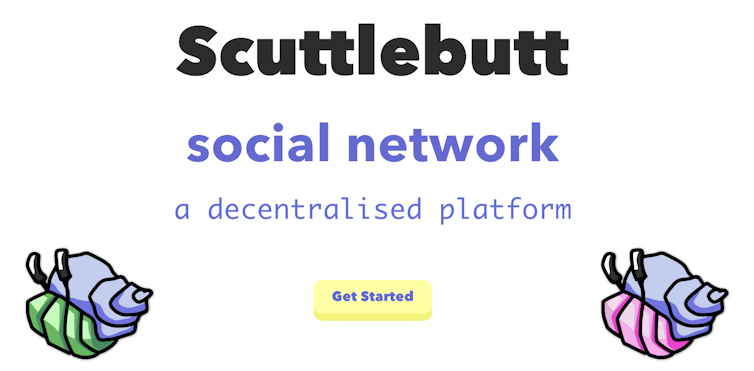
But compared with regular platforms, Scuttlebutt has some radically different qualities. Crucially, it isn’t run by a company. Started by software engineer Dominic Tarr while living on a sailboat in New Zealand, Scuttlebutt is now being developed by an international community of people who run the platform collectively, using grant funding, donations and volunteer labour.
Because it’s not a company, Scuttlebutt doesn’t need to make a profit. There is no persuasive design trying to keep you hooked, no advertising, and it doesn’t collect, process or sell users’ personal data. Instead, data are stored and controlled on users’ own devices. (This process uses the novel secure “gossip” protocol for which the platform is named.) As it is open source, anyone can see, interact with, and reuse the code it’s built on.
While it’s impossible to know how many people are using this decentralised platform, Scuttlebutt has attracted substantial grant funding, along with the attention of tech luminaries and cultural critics.
Lessons For A Better Internet
We spent several years studying Scuttlebutt to understand the community building it, and the new models of online participation they’re trying to create.
We found that participation on Scuttlebutt is much deeper and more varied than mainstream platforms allow. Not only can users participate on the platform by posting, liking and sharing, they can also participate in the platform by helping shape how it is designed and run. Anyone interested is encouraged to contribute in whatever ways they can.
Compared with Facebook users, who resort to protests and petitions to try and improve its practices, Scuttlebutt users are empowered to collaborate in the creation of the online spaces they use.
Unlike mainstream social media, Scuttlebutt doesn’t ask you to give up your personal data as payment. So even forms of participation that look the same as on Facebook, such as creating a post, take place under more equitable conditions.
Scuttlebutt’s principles also reflect a view that developing fair and inclusive participation is as much a matter of culture as of technology design.
In contrast to Big Tech’s common focus on technology-first solutions, most Scuttlebutt contributors are as invested in improving the platform’s culture and governance as they are in building better technology. For example, when electing a council to distribute one of Scuttlebutt’s grants, priority was given to people with historically marginalised experiences in open-source communities.
These social elements may not scale to a platform the size of Facebook, but this isn’t a problem for Scuttlebutt, which doesn’t maximise user participation for profit. This means users can concentrate on encouraging a positive culture rather than trying to make as many people participate as much as possible.
In fact, we found that much of the Scuttlebutt community believes people need more choices in social media platforms, not a single Facebook replacement.
The Future Is Already Here
Scuttlebutt isn’t going to solve all the internet’s problems and, as we discuss in our research, it has its own issues – including the messiness of decentralised governance and ensuring accessibility for people from diverse backgrounds. But it does provide a way of exploring what the future of internet could look like.
These explorations highlight the importance of an internet where no single platform dominates and users have more control over shaping the spaces in which they gather.
In the meantime, Scuttlebutt also shows that platforms focusing on public benefit instead of profit are already possible.
Kate Mannell, Research Fellow in Digital Childhoods, Deakin University and Eden T. Smith, Research Fellow, History and Philosophy of Science, The University of Melbourne
This article is republished from The Conversation under a Creative Commons license. Read the original article.
Lord of The Rings: Rings of Power – a guide to the expanded world of Middle-earth in J.R.R Tolkein’s other books

With Lord of the Rings: Rings of Power having aired there has been a resurgence of interest in the vibrant fantasy world created by J.R.R. Tolkien over a century ago. What many might not know is that there is a whole universe in several books that expand what we know outside of The Lord of the Rings and The Hobbit.
For those not familiar with the new television series, it is set in the Second Age of Tolkien’s mythology. To give that some perspective, his most famous works, The Hobbit (1937) and The Lord of the Rings (1954–55), are set during the Third Age, which means that the events of the show take place approximately four and a half thousand years prior to the events of Lord of the Rings.
The universe created by Tolkien is vast, with an incredible depth of vision and detail that inspires people to this day. While Peter Jackson’s Lord of the Rings film trilogy is widely considered to be a masterpiece of cinema, he was still obliged to make alterations to Tolkien’s story, and took even more liberties with the less well-received Hobbit trilogy.
The Amazon streaming service only has the rights to the appendices to the Lord of the Rings books and The Hobbit so the film-makers have had to draw all their material only from these appendices. This has resulted in sweeping changes to the lore written by Tolkien, so if you want to know the true world that Tolkien envisioned, any of the books listed below will provide readers with the genuine experience created by one of the greatest fantasy writers of all time.

This article is part of Quarter Life, a series about issues affecting those of us in our twenties and thirties. From the challenges of beginning a career and taking care of our mental health, to the excitement of starting a family, adopting a pet or just making friends as an adult. The articles in this series explore the questions and bring answers as we navigate this turbulent period of life.
You may be interested in:
Lord of the Rings: Rings of Power – a cheat’s guide to Middle-earth before you watch the new show
Salman Rushdie: where to start with this pioneering and controversial author
The Silmarillion

The most famous of these works is The Silmarillion (1977). Unlike The Hobbit and Lord of the Rings, The Silmarillion is a collection of epic tales worked (by Christopher Tolkien) into a single narrative. It begins with the creation myth for Tolkien’s world and includes his great romantic epic concerning the adventures of Beren, a mortal Man, and Luthien, an Elven princess. These two characters are of particular relevance to anyone seeking to explore Tolkien’s mythology as they are the ancestors of many important figures from the major narratives, such as Aragorn and Elrond. They were also personally significant to Tolkien himself as he was inspired to write their love-story by his real-life romance with his wife, Edith. On Tolkien’s gravestone in Oxford is inscribed the name “Beren”, while on Edith’s is the name “Luthien”.
The Tales

The stories in Unfinished Tales (1980), edited by Christopher Tolkien, offer more background details regarding some of the most famous characters, including Gandalf. The anthology includes many of Tolkien’s notes about the world he was building, notes that he may not have intended to publish but which nevertheless offer a fascinating insight into his methodology and influences.
The two-volume Book of Lost Tales (1983–84) was compiled by Christopher Tolkien from his father’s notes to form the opening volumes of the all-encompassing 12-volume “History of Middle Earth” (1983-1996). While the stories are broadly similar to those told in The Silmarillion they go into more (some have said too much) detail and include extensive annotations added by Christopher with the intention of making them more like encyclopedias, or at least reference guides to Tolkien’s source material, rather than simple narratives.
On Fairy-Stories
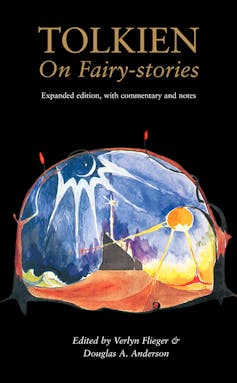
On Fairy-Stories is an essay Tolkien wrote in 1939, two years after the initial publication of The Hobbit. Given originally as a lecture at the University of St Andrews, the text was published in 1947 in Essays Presented to Charles Williams, who was one of the Inklings, the literary discussion group in Oxford in the 1930s and 1940s that included Tolkien and C.S. Lewis.
Tolkien’s essay is noteworthy because it articulates his early opinion regarding what constitutes a “fairy story”, a genre we now refer to as “fantasy” or even “high fantasy” in Tolkien’s case. The essay essentially makes the claim that stories involving fairies or magical creatures that are set in the real world are not true fairy stories. For works of fiction to be truly considered as fantasy they must also be set in entirely imaginary worlds (unlike C. S. Lewis’s Narnia books, for example). Tolkien ultimately justifies this assertion with the argument that the relationship between language and imagination can only develop with one driving the other.
The Adventures Of Tom Bombadil

Given that he is one of Tolkien’s most enigmatic characters, The Adventures of Tom Bombadil (1962) is a genuine curiosity. The book was published in Tolkien’s lifetime but it is a collection of poetry rather than a novel.
Tom Bombadil appears in Lord of the Rings but was written out of the film version. In The Fellowship of the Ring, he uses his extensive powers to rescue the Hobbits, but we never learn who or what he is, only that he alone is immune to the One Ring.
Inevitably, Tom has been the subject of much debate and speculation but Tolkien himself said of Tom: “Even in a mythical Age there must be some enigmas.” In The Adventures of Tom Bombadil, there are some intriguing nuggets about the character, but no definitive answers. While some might argue that Tolkien’s poetry is an acquired taste, the volume nevertheless provides further insights into the world that Tolkien spent his life building.![]()
Helen Fulton, Professor and Chair of Medieval Literature, University of Bristol
This article is republished from The Conversation under a Creative Commons license. Read the original article.
Starlink, Amazon and others are racing to fill the sky with bigger satellites to deliver mobile coverage everywhere on Earth
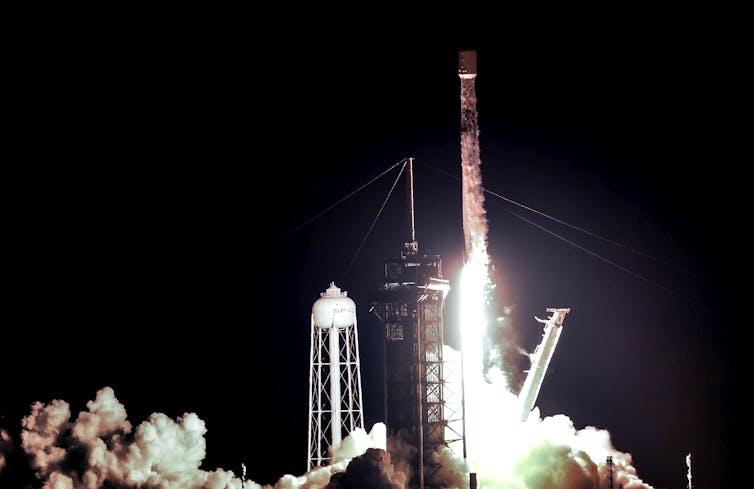
Elon Musk’s space tech company SpaceX is rapidly advancing towards its goal of establishing Starlink – a massive satellite network capable of providing high-speed broadband internet across the world.
Starlink claims the network is already servicing more than 30 countries with high-speed internet, including the United States, parts of Australia and most of the United Kingdom. There are about 2,500 Starlink satellites in orbit, with plans to eventually create a constellation of 42,000.
The satellites are in “low Earth orbit” at an altitude of about 550 kilometres. This relative proximity provides the benefit of low latency (less delay in data processing), faster internet, and service for areas that cable internet can’t service.
Beyond internet, however, Starlink and a number of other satellite network providers are also in a race to establish global mobile phone service connection. Some of the latest proposals could be game changers, especially for people on the move and in remote parts of the world. But there are several hurdles to jump first.
Mobile Phone Service From Space Is Coming
This weekend Starlink launched one of its Falcon 9 rockets for the 14th time, sending another 34 Starlink satellites into space.
The same rocket also carried a very different payload into orbit – a satellite called the BlueWalker 3. It’s the largest commercial antenna array ever launched into space.
Operated by American company AST SpaceMobile, the BlueWalker 3 is expected to provide global satellite phone service (distinct from internet) directly to standard mobile phones from space.
For now, satellite-to-phone connections still require special dedicated handsets, such as through the Iridium network. Iridium provides satellite phone services via its 66 satellites in low Earth orbit (at an altitude of 780km).
AST SpaceMobile will need to launch at least 100 more satellites to obtain global coverage. It has partnered with a number of mobile service providers, who will participate in connectivity tests starting next year. Currently, no date has been set for when the service will become commercially available.
T-Mobile, Apple And Verizon
Musk too plans to expand his Starlink network to provide satellite mobile phone connection directly to mobile devices.
In August, Musk announced a partnership between Starlink and US telecommunication provider T-Mobile. This will link T-mobile users directly to Starlink satellites, providing a limited service of text, MMS, voice messaging and potentially some messaging app connectivity to most of the US (including outside standard service areas).
The service is expected to launch in beta phase by the end of 2023, pending the deployment of second-generation Starlink satellites with larger antennas. However, at this stage it’s only intended as a connection of “last resort”, providing coverage for rescue and emergency services in areas currently without coverage. There are no plans for expansion beyond the US.
These announcements come around the same time as the launch of Apple’s iPhone 14 – the first regular smartphone to allow direct satellite connectivity.
From November, iPhone 14 users will be able to send short SOS messages where no other connection is available. The connection, which uses the Globalstar satellite network, will rely on access to clear skies and may not be available at all times and in all locations.
Similarly, US-based mobile phone service provider Verizon has partnered with Amazon’s proposed Kuiper satellite network to provide mobile services. But the Kuiper network has yet to launch any of its planned 3,200 broadband satellites, so it’s unclear when the additional capacity for mobile phone service connection would roll out.
Moreover, all of these arrangements will involve working out the complicated allocation of mobile phone spectrum licences across the globe.
A licence to operate in the US would not necessarily give access to such rights in another country. For example, America can grant AST SpaceMobile a licence to provide satellite mobile phone connectivity to people in America, but Australia would have to grant a different licence for it to service people in Australia.
Starlink is lobbying to prevent changes to the allocation of the 12GHz spectrum in the US. Last year, the US Federal Communications Commission proposed opening up the 12GHz frequency band (currently used for space-based services) for more widespread use on Earth for 5G mobile connection.
Starlink satellites use this band to communicate data to the ground, so this change would lead to significant interference in its services.
Internet On The Move
Starlink internet users within Australia can’t currently obtain a fully mobile service. With some exceptions, such as mobile homes, their service is locked to a single location where their satellite dish is placed.
Elsewhere, things seem to be advancing. In June the US Federal Communications Commission granted Starlink a licence to operate in moving vehicles, including cars, boats, planes and trucks.
And cruise operator Royal Caribbean (which services Australia) recently began installing Starlink terminals on its fleet, after successful internet trials on a cruise earlier this year.
SpaceX is also in negotiation with several commercial airlines regarding its internet service, which will be installed on Hawaiian Airlines flights beginning next year.
Subject to licensing approvals, the Starlink network will also provide internet for its Tesla vehicles – with emergency phone connection only available in the US.
What About Australia?
Australia, with its vast remote areas, would certainly benefit from mobile phone coverage provided by a low Earth orbit satellite network. It would particularly benefit emergency services, remote communities, long-haul travellers and adventurers.
There are no clues as to when such a rollout may happen here. Yet, with the speed at which these developments are occurring, it seems likely Australians will get access to satellite-to-phone connections sooner rather than later – subject to the necessary licensing approvals.
In the interim, many are concerned about the congestion and light pollution that will arise due to the deployment of so many satellites. The BlueWalker 3, at 64 square metres, has only added to these concerns.![]()
Melissa de Zwart, Professor (Digital Technology, Security and Governance), Flinders University
This article is republished from The Conversation under a Creative Commons license. Read the original article.
Negative feedback is part of academia (and life) – these 6 strategies can help you cope

Imagine you have years-worth of research and it is dismissed by a 15-word rejection letter from a journal editor. That has happened to us.
Or peer reviewers write demeaning, anonymous commentary about your work. That has also happened to us.
Or student evaluations critique your appearance or the way you speak. Yes, that’s also happened to us.
Academics also get negative feedback on research grants and funding applications, conference submissions and mainstream writing outlets, like The Conversation. And, yes, we’ve experienced all this, too. And we are not alone.
We are experts in management and psychology. The good news is, there are strategies available to help you overcome and even use negative feedback to your advantage.
Feedback Is Unavoidable
Feedback is a key component for any academic career. It is part of how the profession maintains rigour and quality in what it does.
While it can of course be positive, research shows, it tends to be negative. And this comes at a cost to individuals, their sense of self worth and their mental health.
Academia is not alone here. Managers across all industries use feedback to enhance workplace performance and online reviews are a fact of life for businesses. Yet, despite this, not many people know how to do it well. And, the receivers are not always able to use the feedback in the way it was intended.
On top of calls to improve training for academics, managers and leaders on how to provide helpful feedback (we do this here and here), being able to use the feedback we get is also important for our wellbeing.
Tough feedback can hurt and shake our confidence. Yet it may be necessary to process this feedback to grow and develop as professionals. And this is where positive psychology can help.
Positive psychology is the study of strengths and virtues over human deficiencies and diagnoses. It focuses on promoting strengths – like courage, optimism, and hope – as a buffer against mental ill-health.
6 Things To Do When You Get Negative Feedback
1. Empathise with the person giving feedback
Do you remember receiving formal training for providing feedback? Probably not. It is likely the reviewer or person giving you feedback did not either.
And humans have a bias towards negative information too. Perhaps this is an evolutionary challenge, with early humanity needing to fixate on dangerous and threatening matters to survive.
A reviewer or manager’s potential lack of training and natural bias does not excuse their harmful comments, but it might help us to empathise with their circumstances.
Academics have complex, very busy careers. When anonymous reviews are negative, it might have more to do with their (lack of) experience and heavy workloads, rather than our work.
2. Pause
When dealing with negative feedback, it can help to pause, take a walk around the block or grab a cup of tea. One of the authors of this piece has the practice of reading a review and then putting it in a draw for a week before she begins to address the feedback.
Distance allows us to gain perspective and think through the parts of the feedback that are valuable and worth addressing. This puts us into a positive state of mind and prompts us to considers solutions as a way of coping.
3. Talk about what happened
Vent to some friends or your colleagues.
Affective labelling theory says when people talk about their feelings, they feel better about them. A Geneva Emotion Wheel might help label more complex emotions.
You can also try self-affirmations, or the practice of recognising the value of one’s self. Affirmations may not suit everyone’s style but if you think they will work for you, useful self-affirmations may include: “I am getting better as a researcher” or “this obstacle will help me grow”. (You can look at some more examples here).
Positive affirmations give rise to more positive emotions and this is useful because positive emotions boost our problem-solving skills.
4. Address your inner critic
Our inner critic is often an ally who motivates us to achieve. It can sometimes be toxic though, especially when receiving unwanted feedback. The inner critic prompts cognitive distortions, such as catastrophising (“I’ll never be published”) or assigning self-blame (“I’m not smart enough”).
As we know, distortions are not true and they stop us seeing the situation clearly. When these voices are left unchecked, it can lead to mental health problems.
Instead, we need to practice self-compassion. This could include, visualising positive and non-judgmental images. Perhaps visualising a walk on your favourite beach, without a care or concern.
Talking back to our inner critic (verbally or non-verbally) also helps. Cognitive reappraisal is the practice of identifying a negative thought pattern and changing the perspective. In response to “I’m not smart enough” try “This time, this work was not valued, but it is valuable, and I can grow from the feedback”.
5. Reframe what happened
Our brains almost prime us to take negative feedback personally at first.
When receiving negative feedback, the primal (“fight or flight”) and emotional (“do they hate me?”) parts of our brain often jump to respond first.
But we can deliberately look for benefits, upsides and lessons if something bad happens. This is what psychologists call “positive reframing”.
For example, if you get unhelpful personal feedback on anonymous student feedback forms, it might prompt you to talk with your next group of students about the purpose of this feedback and about the importance of them being professional and constructive.
6. Look for opportunities
Each strategy above is designed to help you cope with and accept feedback. The final strategy is to focus on the opportunity.
Despite the negativity or the difficult conversation, someone took time to give this feedback. What is it that can be learned? Or done better next time?
All of this is of course assuming the feedback was constructive. Sometimes negative feedback is just toxic. In these cases, submit your work somewhere else!
If this article has raised issues for you, or if you’re concerned about someone you know, call Lifeline on 13 11 14.![]()
Joseph Crawford, Senior Lecturer, Management, University of Tasmania; Kelly-Ann Allen, Associate Professor, School of Educational Psychology and Counselling, Faculty of Education, Monash University, and Lea Waters, Psychology Professor, Centre for Positive Psychology, University of Melbourne, The University of Melbourne
This article is republished from The Conversation under a Creative Commons license. Read the original article.
AI art is everywhere right now. Even experts don’t know what it will mean

An art prize at the Colorado State Fair was awarded last month to a work that – unbeknown to the judges – was generated by an artificial intelligence (AI) system.
Social media have also seen an explosion of weird images generated by AI from text descriptions, such as “the face of a shiba inu blended into the side of a loaf of bread on a kitchen bench, digital art”.
Or perhaps “A sea otter in the style of ‘Girl with a Pearl Earring’ by Johannes Vermeer”:

You may be wondering what’s going on here. As somebody who researches creative collaborations between humans and AI, I can tell you that behind the headlines and memes a fundamental revolution is under way – with profound social, artistic, economic and technological implications.
How We Got Here
You could say this revolution began in June 2020, when a company called OpenAI achieved a big breakthrough in AI with the creation of GPT-3, a system that can process and generate language in much more complex ways than earlier efforts. You can have conversations with it about any topic, ask it to write a research article or a story, summarise text, write a joke, and do almost any imaginable language task.
In 2021, some of GPT-3’s developers turned their hand to images. They trained a model on billions of pairs of images and text descriptions, then used it to generate new images from new descriptions. They called this system DALL-E, and in July 2022 they released a much-improved new version, DALL-E 2.
Like GPT-3, DALL-E 2 was a major breakthrough. It can generate highly detailed images from free-form text inputs, including information about style and other abstract concepts.
For example, here I asked it to illustrate the phrase “Mind in Bloom” combining the styles of Salvador Dalí, Henri Matisse and Brett Whiteley.
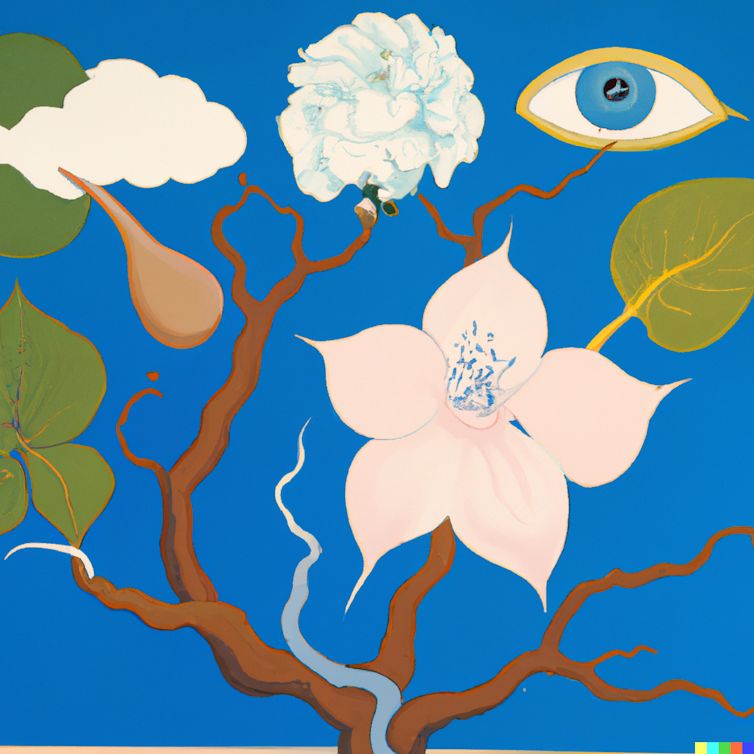
Competitors Enter The Scene
Since the launch of DALL-E 2, a few competitors have emerged. One is the free-to-use but lower-quality DALL-E Mini (developed independently and now renamed Craiyon), which was a popular source of meme content.

Around the same time, a smaller company called Midjourney released a model that more closely matched DALL-E 2’s capabilities. Though still a little less capable than DALL-E 2, Midjourney has lent itself to interesting artistic explorations. It was with Midjourney that Jason Allen generated the artwork that won the Colorado State Art Fair competition.
Google too has a text-to-image model, called Imagen, which supposedly produces much better results than DALL-E and others. However, Imagen has not yet been released for wider use so it is difficult to evaluate Google’s claims.
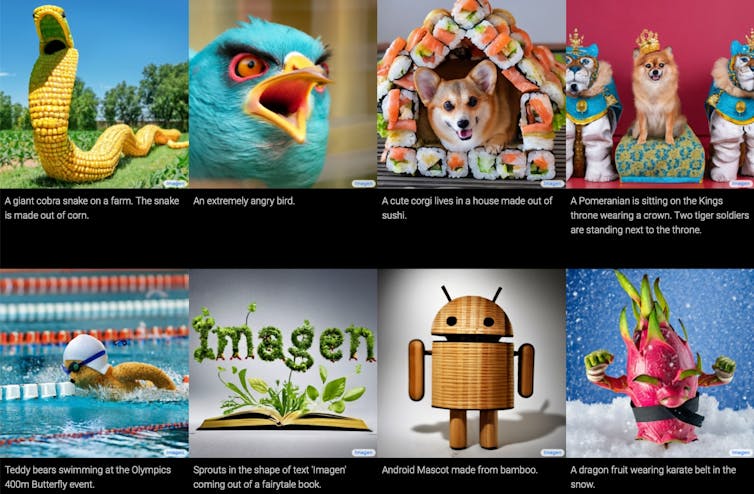
In July 2022, OpenAI began to capitalise on the interest in DALL-E, announcing that 1 million users would be given access on a pay-to-use basis.
However, in August 2022 a new contender arrived: Stable Diffusion.
Stable Diffusion not only rivals DALL-E 2 in its capabilities, but more importantly it is open source. Anyone can use, adapt and tweak the code as they like.
Already, in the weeks since Stable Diffusion’s release, people have been pushing the code to the limits of what it can do.
To take one example: people quickly realised that, because a video is a sequence of images, they could tweak Stable Diffusion’s code to generate video from text.
Another fascinating tool built with Stable Diffusion’s code is Diffuse the Rest, which lets you draw a simple sketch, provide a text prompt, and generate an image from it. In the video below, I generated a detailed photo of a flower from a very rough sketch.
In a more complicated example below, I am starting to build software that lets you draw with your body, then use Stable Diffusion to turn it into a painting or photo.
The End Of Creativity?
What does it mean that you can generate any sort of visual content, image or video, with a few lines of text and a click of a button? What about when you can generate a movie script with GPT-3 and a movie animation with DALL-E 2?
And looking further forward, what will it mean when social media algorithms not only curate content for your feed, but generate it? What about when this trend meets the metaverse in a few years, and virtual reality worlds are generated in real time, just for you?
These are all important questions to consider.
Some speculate that, in the short term, this means human creativity and art are deeply threatened.
Perhaps in a world where anyone can generate any images, graphic designers as we know them today will be redundant. However, history shows human creativity finds a way. The electronic synthesiser did not kill music, and photography did not kill painting. Instead, they catalysed new art forms.
I believe something similar will happen with AI generation. People are experimenting with including models like Stable Diffusion as a part of their creative process.
Or using DALL-E 2 to generate fashion-design prototypes:
A new type of artist is even emerging in what some call “promptology”, or “prompt engineering”. The art is not in crafting pixels by hand, but in crafting the words that prompt the computer to generate the image: a kind of AI whispering.
Collaborating With AI
The impacts of AI technologies will be multidimensional: we cannot reduce them to good or bad on a single axis.
New artforms will arise, as will new avenues for creative expression. However, I believe there are risks as well.
We live in an attention economy that thrives on extracting screen time from users; in an economy where automation drives corporate profit but not necessarily higher wages, and where art is commodified as content; in a social context where it is increasingly hard to distinguish real from fake; in sociotechnical structures that too easily encode biases in the AI models we train. In these circumstances, AI can easily do harm.
How can we steer these new AI technologies in a direction that benefits people? I believe one way to do this is to design AI that collaborates with, rather than replaces, humans.![]()
Rodolfo Ocampo, PhD student, Human–AI Creative Collaboration, UNSW Sydney
This article is republished from The Conversation under a Creative Commons license. Read the original article.
Moonage Daydream: brilliant Bowie film takes big risks to create something truly new

Don’t fake it baby, lay the real thing on me
– David Bowie, Moonage Daydream (1971)
Hypnotic, immersive, kaleidoscopic, sublime: Brett Morgen’s film Moonage Daydream has been described as an “experiential cinematic odyssey” and a “colossal tidal wave of vibrant images and overpowering sound”.
But as a Bowie fan of 40 years, this film was a transformative experience for me because of the integrity with which Morgen reassembled “the real thing” to make something authentic and new.
Inspired by Bowie’s cautionary words about comfort and his philosophy to “always go further into the water than you feel you’re capable of being in”, Morgen embarked on a mission that would take him far outside his comfort zone.
Boldly eschewing the conventional biopic format, he immersed himself in a seven-year creative process – one that has led to a subjective but respectful representation of the artist who helped him navigate his own teenage journeys.
Propelling the biographical music documentary form beyond the expected conventions of talking heads and expert analysis, Morgen combines a documentary style with music video aesthetics and surrealist assemblage methods to craft a new form.
Employing an even more extensive collage approach than he’d used for his Kurt Cobain film Montage of Heck (2015), Morgen treats Moonage Daydream as an audiovisual tapestry, woven from numerous archival materials: songs, vocal recordings, still photographs and film footage derived from music videos, theatrical films, televised interviews and live performance.
Morgen brings these things to life by punctuating them with sonic and visual effects. Bravely facing the potential wrath of Bowie devotees, he takes the creative liberty of disassembling and reanimating Bowie’s hand-drawn sketches, storyboards and paintings.
Ziggy Stardust Lives
A risky way to treat the work of a deceased artist, the approach nonetheless works because Morgen is channelling the Bowie “on his shoulder”. This is his reality of Bowie, but it allows space for viewers to fill in the gaps. As he explained recently:
Bowie invited us the way kabuki does, to kind of project and fill in the blanks. And so I tried to create a film in that manner […] We all have our own Bowie. You have your Bowie, I have my Bowie. I wanted the canvas to reflect back to each viewer their own Bowie, and ultimately themselves.
Taking two years to familiarise himself with millions of archival pieces, Morgen developed an intuitive sense about which materials to use and how they would project when blown up on a cinema screen. By allowing this raw material to retain flaws such as scratches, camera shake and blur, he conjures nostalgia for a moment in time.
Transported to the Hammersmith Odeon in 1973, I marvelled at the grainy texture of the film stock used to shoot D.A. Pennebaker’s film of the famous last Ziggy Stardust concert. I absorbed the texture of Bowie’s hair and the colour of his mismatched eyes in extreme closeups from Mick Rock’s music video Life On Mars? from the same year.
Grounding the film in reality, the rawness and heightened proximity of these projections enhance the sensory experience. One moment I was on stage with Bowie, just behind his shoulder, experiencing his exhilaration as he stepped towards throngs of adoring fans. Next, I was one of those fans in full Ziggy garb, reaching out to touch Bowie on that stage.
Cut-Up And Collage
This sense of intimacy and immersion in Bowie’s life explains why Moonage Daydream is such a treat for fans. But why did Bowie’s estate give their wholehearted approval to this film and not others?
Firstly, rather than relying on actors or expert commentators, the film allows Bowie to tell his story through his own words and his own art. Secondly, Morgen has taken more than inspiration from Bowie’s philosophy about life and creativity. He approached Moonage Daydream in a way that mirrors Bowie’s own creative process.
Often described as a cultural magpie, Bowie was a rampant forager who used methods such as cut-up and collage to weave together a diverse array of inspirations and found materials. Morgen uses similar methods with archive material from across Bowie’s expansive oeuvre.
He shows how Bowie synthesised the gestures of Hollywood starlets, visual motifs gleaned from kabuki theatre and noh mask traditions, protopunk style and a Kubrick-esque science fiction aesthetic.
Morgen also uses cut-up and collage methods to show how Bowie fused the Pierrot persona (derived from the Commedia dell'arte performance form) with visual references derived from surrealist and German expressionist films, along with the aesthetics of the fledgling New Romantic subculture.

Time And Space
Mirroring Bowie’s creative process, the approach also replicates the artist’s treatment of time as medium, and his penchant for time travel. His songs, music videos and performances portray a constant, dizzying transit between past, present and future – something Bowie described as “future nostalgia”.
Ironically, Morgen’s non-linear editing works in tension with the film’s overarching linear chronology. This complex structure is appropriate, since it portrays the temporal fluidity and “loose continuity” that Bowie wove across five decades and several mediums.
This sense of time travel extends to the treatment of the songs, too. Morgen worked with Bowie’s long-time friend and collaborator Tony Visconti, who uses cut-up and collage to create new soundscapes by merging isolated tracks from the original song recordings.
At one point, Blackstar (2016) gradually begins to merge with parts of Memory of a Free Festival (1970) and other songs. Combined with visual collage, this surprising mashup forms a densely layered audiovisual bricolage that takes the audience on an exhilarating trip through time and space.
Recalling the liberating experience of dancing up the red carpet at the premiere for Moonage Daydream, and the creative process behind this almost psychedelic filmic experience, Morgen told one interviewer:
If you ingest Bowie into your veins for seven years, you’re probably going to be a better person at the end of it than you were when you started […] It’s like having a natural high, I mean it’s like the endorphins are all alert.
I would never have arrived at that perspective without embracing his teachings, his philosophies towards creation.
Creating this film was a life changing experience for Morgen. Moonage Daydream is a bold work of art that promises a transformative experience for all of us. I saw my Bowie reflected back from Morgen’s canvas. Will you see your Bowie?
Moonage Daydream opens in cinemas worldwide on September 15.![]()
Lisa Perrott, Senior Lecturer & Researcher in Screen and Media Studies, University of Waikato
This article is republished from The Conversation under a Creative Commons license. Read the original article.
The Whitewash is a scathing, hilarious satire of Asian misrepresentation in Hollywood

Siang Lu’s debut novel The Whitewash is a scathing satire of the big-budget film industry’s ethnic and racial myopia. Original, critical and hilarious, the book is a product of the Glendower Award for an Emerging Queensland Writer, which this manuscript won in 2021.
Review: The Whitewash - Siang Lu (UQP)

Lu innovatively blends features of oral history and mockumentary into a fast-paced multi-vocal exposé. The story recounts the sad fate of a Hollywood spy thriller, “Brood Empire”, which crashes during production. Adapted from a popular novel written by an influential Hong Kong writer, Brood Empire is expected to be a box-office success. It has a top production team, coupled with a sizeable budget. And for the first time in history, a Hong Kong actor takes the lead in a Hollywood movie. How can it fail?
Whitewash takes the form of an oral history: the novel is compiled of interviews with people involved with “Brood Empire”. The editor-in-chief of a scurrilous rag, “Click Bae”, drives the story. His aim is to get the dirt on the production, expose its failure – and publish a lucrative book … which will be entitled “The Whitewash”. Fiction and reality wittily converge.
Orientalism Retold
Almost half a century has passed since Edward Said traced an inevitable connection between simplistic views of races (or ethnicities) and racism. His term “Orientalism” sums up the attitudes of those who
adopt an essentialist conception of the countries, nations and peoples of the Orient under study, a conception which expresses itself through a characterized ethnist typology […] and will soon proceed with it towards racism.
The urgency of Said’s critique is palpable in Lu’s energetic framing of current views of Asia. Lu’s novel shows how politics and the economics of big-screen productions contribute to racial stereotyping and racism towards Asians. Lu departs from Said only in revealing how unintentionally risible this form of present-day Orientalism is.
An academic perspective comes via an “Adjunct Professor of Chinese Cultural Studies” who’s enlisted by “Click Bae”. For a fee, he agrees to ventriloquise another academic (who refused to be involved in the project). So, a bottom-feeding journal enlists an academic in need of money to lend credibility to a story about the venality of the film industry. There is no end to the unscrupulousness.
Stereotypes And Market
Apart from the link between politics and what we get to see on the big screen, Lu reveals that whitewashing Asians is profitable. People pay to see foreignness repackaged as stereotypes – and thus rendered virtually invisible.
This has been going on since the early days of cinema. In the 1930s, it was Boris Karloff who played the evil genius Fu Manchu. And Swedish actor Warner Oland played the self-righteous detective Charlie Chan, with his tongue-in-cheek Confucianism.
Later, even celebrated Asians like martial arts prodigy Bruce Lee and action-movie star Jackie Chan ended up in supporting roles. (Though Lee starred in his films, his character was demoted in the much-criticised 2016 biopic, Birth of the Dragon, which centralised a fictional white character in a film ostensibly about Lee.) Whitewashing caters to audiences who want “Asians” on the screen to match the “Asians” of their preconceptions. The only way to change this, as Lu’s professor explains, is money:
You want to see rapid and progressive shifts in societal attitudes towards minorities in the mass media, in the Hollywood industrial complex? No problem, as long as it makes money.
Lamentably, if any change of cultural framing of Asians still depends on the market, this is no real change at all. We already have stock Asian elements on the screen such as kung fu and wuxia (martial arts heroes). Bringing more to the mix – just as long it turns a profit – means adding one stereotype after another.
Where To From Now?
Lu reminds us that a lack of multi-dimensional representation on the screen is harmful. JK Jr, the actor cast as Brood Empire’s initial lead, reflects on the shared experience of Asian people in Western countries:
Our grandparents grew up with the Yellow Peril. Our parents grew up with yellow discomfort. Our generation grew up with yellow invisibility.
I genuinely believe that representation is the key to cultural acceptance. If your heroes on the screen, in the world, look like you, that can change everything! So if what I’m doing is able to shift the needle even an inch towards mainstream cultural acceptance of Asians in film and TV, then there could be a whole new group of kids out there who mightn’t have the baggage that I had growing up. All the wasted energy I spent trying to fit in and act white.
I hope Siang Lu’s novel will spark readers to reject stereotypes – to instead discover an interest in the countless different ways of being Asian. This might allow, as Whitewash’s professor hopes, “a new generation of Asian kids to see themselves reflected on the screen”.
This novel’s relevance is not confined to Asia. The more people from diverse cultural backgrounds are visible on screen, the more we can authentically encounter each other in the world. Lu’s The Whitewash succeeds in helping us to properly see one another, on the road towards a more inclusive society.![]()
Jindan Ni, Lecturer, Global and Language Studies, RMIT University
This article is republished from The Conversation under a Creative Commons license. Read the original article.
It’s corn! How the online viral ‘Corn Kid’ is on a well-worn path to fame in the child influencer industry

An American seven-year-old named Tariq went viral on the internet last month after appearing in an 85-second Instagram clip professing his love for corn. His quirky quips, including the catchphrase “Have a cornstastic day!” quickly found favour with internet audiences, who turned him into the meme affectionately known as “Corn Kid”.
At the time of writing, the original Instagram clip has been viewed over 26 million times and has been widely reposted by several other accounts across Instagram, YouTube, Twitter and TikTok.
On the strength of accidental viral popularity, Corn Kid is now well on his way to becoming a child celebrity. His time in the limelight has followed a predictable path carved out over the past decade as the era of “cute videos of kids” has given way to a full-blown child influencer industry.
Turning Accidental Virality Into Commercial Opportunities
Corn Kid’s humorous interview was auto-tuned into a catchy song “It’s corn!” by comedy music YouTubers The Gregory Brothers. He began featuring in a string of content collaborations with notable influencers. He was even recently named “Corn-bassador” – an ambassador of corn – for South Dakota in the US.
But Corn Kid’s serendipitous fame has also brought tangible commercial opportunities.
He starred in a social media ad for Chipotle that went viral, and also registered an account on Cameo – a video-sharing platform where users can pay for personalised video messages.
And it is here where what seems like fun on the internet can begin to have real-world consequences.
Accelerated Pathways Into ‘Child Celebrity’
If Corn Kid’s story sounds familiar, it is because this rapid pathway from “accidental virality” to “meme celebrity” to “influencer” has been a tried-and-tested recipe for more than a decade.
In 2011, British cousins Sophia Grace and Rosie (then aged 8 and 5, respectively) went viral with a short dance clip. It led to regular appearances on The Ellen Show, followed by music and film opportunities, and careers as YouTube influencers.
In 2014, five-year-old Noah Ritter’s viral street interview eventually led to regular fixtures on talkshows and appearances at cons, after similarly being picked up by The Ellen Show.
But there are also less wholesome examples, such as when 14-year-old Danielle Bregoli went viral for her appearance on the Dr. Phil Show in 2016, after he had called out her bad behaviour and publicly shamed her. She went on to establish herself as a rapper and as a NSFW influencer who reportedly earned US$50 million in her first year.
As I note in my book Internet Celebrity: Understanding Fame Online, young children who go viral on social media are quickly perceived by industry stakeholders as commercial investments to be “spotted and groomed”. And this initial period of instant fame is a critical moment for important decisions.
Some Pitfalls Of The Influencer Industry
Parents of children who go viral online often suddenly find themselves in a world of opportunity. Paid cameos, corporate partnerships, offers of talent brokerage and child influencer contracts can line up swiftly. In the growing market, even micro- and mid-tier influencers can demand thousands of dollars for a single post.
As parents are quickly pushed into the glitzy world of child celebrity, there is usually little time to make concerted and informed decisions. Tantalising offers may be short-lived and contingent upon wavering public interest.
Yet, it is important to consider the pitfalls and longer-term consequences in the child influencer industry.
Earlier this year, a TikTok-famous child was sexualised by fan accounts, leading to a public conversation about the safety and privacy of similar child influencers. In another instance, an influencer in my research reported she and her child were involved in a car chase by over-enthusiastic fans.
As advertising opportunities expand in range, parents may also find themselves on a slippery slope as they move from child-centred products to less child-relevant recommendations like car decals and fast food.
Parents must also recognise when their children may no longer enjoy creating content, such as when they need to be “enticed by rewards for compliance to stay in the frame and continue filming”.
In some cases, parents have also been found to exploit and abuse their children when creating sensational content to attract viewers.
In Australia, the industry is growing rapidly.
Navigating Unregulated Terrain
The child influencer industry is still largely unregulated terrain. One exception is in France, where the government passed a law in 2020 to regulate workable hours, safeguard the income of under-16s, and ensure that companies apply for permission to work with child influencers.
In the UK, a House of Commons committee conducted an inquiry into the child influencer industry in 2021. The UK parliament is presently working on a response to calls for more regulation.
Formal regulations are beginning to catch up with the industry.
In the meantime parents of aspiring child influencers are also doing more to protect their children.
Established “family influencers” on YouTube have role-modelled how to negotiate children’s involvement in content creation – treating it as a reward rather than an obligation, and allowing them to opt out when they want.
Lessons From Asia
I am conducting a five-year ethnography of the influencer industry in Australia and East Asia, during which I have found many more examples of parents doing more to stand up for the interests of their children.
Parents in South Korea are requesting specific clauses in their child influencer contracts with sponsors to give their children more agency. These may accommodate “no shows” if a child refuses to participate in a client event at late notice, or flexibility to renegotiate advertising briefs if a child does not want to engage with the sponsored product or service.
In China, talent managers are trained professionals who act as mediators and brokers for child influencer services. They safeguard access to prominent child influencers, ensure client contracts are fair, educate parents by advising them on legal and contractual matters, and provide quality control for the content that child influencers deliver to clients.
Further, influencer agencies are contractually responsible for any faux pas. Thus, they work quickly to resolve issues that impinge on the welfare of the child.
Even the most loving and well-meaning parents may not have the capacity and skills to protect the interests of their children in the volatile influencer industry. And while change is coming, we can draw on lessons from the past.![]()
Crystal Abidin, Associate Professor & ARC DECRA Fellow, Internet Studies, Curtin University
This article is republished from The Conversation under a Creative Commons license. Read the original article.
2023 Year 12 School Scholarship Program Now Open: DYRSL

Securing A Brighter Future For Disadvantaged Youth
HSC Online Help Guides
Stay Healthy - Stay Active: HSC 2022

World Barber Day Highlights Demand For Age Old Craft

UNSW Launches Artificial Intelligence (AI) Institute
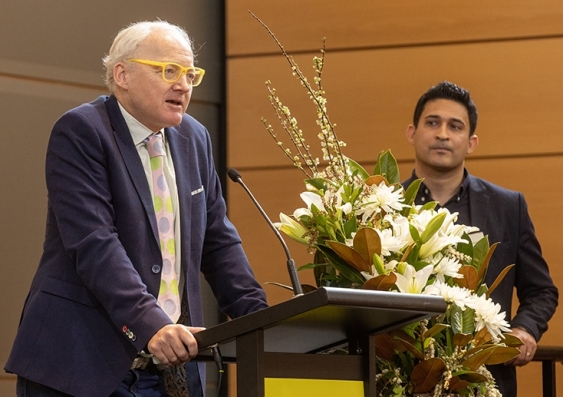
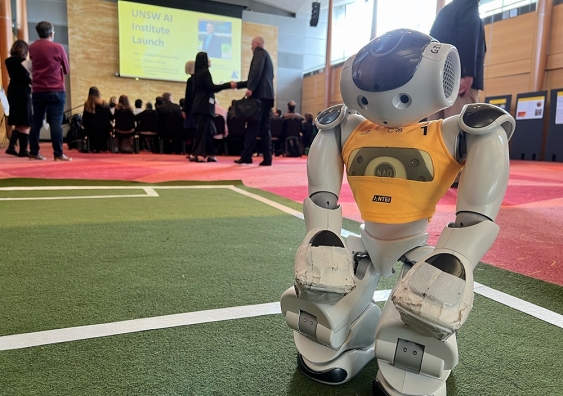
Youth For Soibada – Be A Part Of It!

The youth of the world are the future, and we must nurture, educate, and provide them with what they need to prosper. In our sister village of Soibada in Timor Leste the young people are full of energy, love, and laughter. They are small in stature due to malnourishment but their desire to learn is huge!
.jpg?timestamp=1663452956862)
Since Maria Regina School in Avalon first connected with Our Lady of Aitara School in Soibada in 2009, followed by Sacred Heart School and Tasi Fatin School soon after, and then Mater Maria and Nicolau Lobato Senior High School, many other schools, both State and Private, here in Sydney have taken up the link of friendship with schools in Soibada. Most recently Narrabeen North Primary School connected with Somoro School in central Soibada. Teacher Olivia Scully visited Soibada in July to formalise the friendship – there will be lots of news on that soon!
.jpg?timestamp=1663452981361)
It is a wonderful opportunity to learn about each other’s cultures but it also provides a chance for our young people to see what a difference they can make in the lives of others - even in small ways. Although it is all about friendship, there is still so much need in Timor Leste after the years of occupation and the fight for freedom. Maria Regina students recently did a “Seeds for Soibada” campaign that did not cost much – just a packet of vegetable seeds – but will have a big impact on nutrition.
.jpg?timestamp=1663453019513)
The Youth for Soibada committee has been reinvigorated after the Covid Years and there was a great team in the village in July. One of them was even an ex-Maria Regina (and current Mater) student. The kids connected in a way impossible to adults and language proved no barrier. They have initiated a new Instagram page to generate interest and support from other teenagers. They have some great events planned, including performances from some of the young artists and bands we had at Soup for Soibada recently. If you are interested in getting involved or know someone who is, or just want to keep up to date with what is going on, please send a direct message on Instagram to friendsofsoibada
Or contact Tamara on tamara.harding@bigpond.com
Tamara Sloper Harding OAM
.jpg?timestamp=1663453056124)
Barrenjoey High School Maths Teacher Farewell

Sunday Comics And Cartoons
One of the reasons we first started reading the Sunday paper was to get the children's section and read the cartoons. In keeping with that a cartoon or animation will run each Sunday on your page. Some of these you will need to read and others you can watch. This week it's A message from Ginger Meggs in 1947.
Surfer Groms Comp In Coffs Harbour Sees Local Surfers Among Winners
The Woolworths Surfer Groms Comps in Coffs Harbour finished on Sunday September 11, 2022, with some great placings for local surfers. Well done to all those who had a go and all those who won a place in the results.
Regarded as one of the major stepping stones in the development of young Australian surfers, the 10-event Woolworths Surfer Groms Comps series caters for surfers from Under 8 to Under 14 and will be held in New South Wales, Queensland, Victoria, Western Australia, Tasmania and South Australia over Spring and into Summer.
As an added bonus, the respective winners of the Under 14 boys’ and girls’ divisions from each event will receive an invite to attend an all-expenses-paid, three-day Woolworths Surfer Groms Comps National Final Surf Camp, (1-day coaching clinic, two days of competition and heat analysis coaching) at the Surfing Australia High-Performance Centre (HPC). For the South Australian, Victorian and Tasmanian events, the Woolworths Surf Camp prize will be awarded to the highest place Under-14 Boy and Girl who reside in that respective state.
Run through Surfing NSW this is a great competition for those who like their surfing and a great opportunity to meet youngsters from other places.
Woolworths Surfer Groms Comps 2022 Schedule:
- EVENT 1 – Kiama, NSW – Sept 3 – 4, 2022
- EVENT 2 – Coffs Harbour, NSW – Sept 10 – 11, 2022
- EVENT 3 – Gold Coast, QLD – Sept 24 – 25, 2022
- EVENT 4 – Fleurieu Peninsula, SA – Oct 1, 2022
- EVENT 5 – Northern Beaches, NSW – Oct 15 – 16, 2022
- EVENT 6 – Clifton Beach, TAS – Oct 29, 2022
- EVENT 7 – Torquay, VIC – Nov 12 – 13, 2022
- EVENT 8 – Trigg, WA – Nov 19 – 20, 2022
- EVENT 9 – Cronulla, NSW – Dec 3 – 4, 2022
- EVENT 10 – Sunshine Coast, QLD – Dec 10 – 11, 2022
Coffs Harbour Results
U8 Mixed
1st Atlas Zoric (Broken Head)
2nd Flynn Swierczewski (Coolangatta
3rd Lakey Schomberg (Bonville)
4th Noah De Campos (Emerald Beach)
U10 Girls
1st Zoee Bradshaw (Haleiwa)
2nd Isabel O’Boyle (Lennox Head)
3rd Coco Woolley (Boomerang)
4th Alanni Morriss (Shelly Beach)
U10 Boys
1st Phoenix Talbot (Yamba)
2nd Sage Lewis (Sandy Beach)
3rd Billy Daniel (Fingal Head)
4th Conor O’Boyle (Lennox Head)
U12 Girls
1st Lehiani Zoric (Broken Head)
2nd Talia Tebb (Avoca)
3rd Zoee Bradshaw (Haleiwa)
4th Olive Morriss (Shelly Beach)
U12 Boys
1st Kade Kelly (Newcastle)
2nd Locana Cullen (Avalon)
3rd Luca Martin (Coffs Harbour)
4th Liam Gason (Collaroy)
U14 Girls
1st Charli Hatley (Currumbin)
2nd Lehiani Zoric (Broken Head)
3rd Madora Barton (Yamba)
4th Avalon Vowels (Scotts Head)
U14 Boys
1st Ben Zanatta (Manly)
2nd Balin Cullen (Avalon
3rd Lucas Leal (Dee Why)
4th Will Tebb (Avalon)
Locana Cullen (Avalon)
Liam Gason (Collaroy)
Ben Zanatta (Manly)
Balin Cullen (Avalon
Lucas Leal (Dee Why)
Will Tebb (Avalon)
Photos by Lighthouse Photography
What Is The Beaufort Scale?
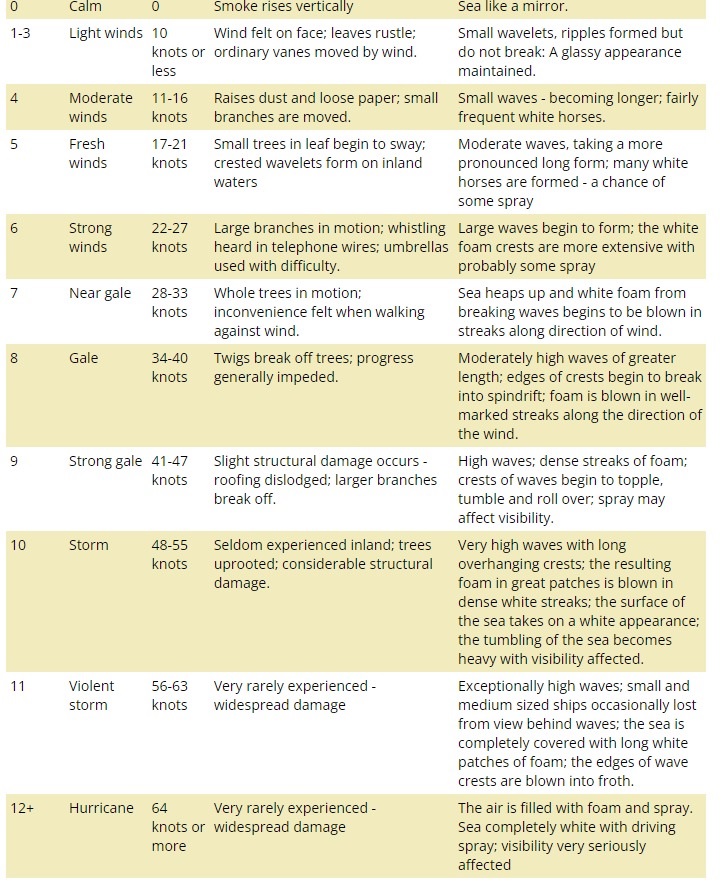
- Marine warnings: The Bureau of Meteorology issues a range of warnings for marine areas when dangerous winds and waves are expected.
- Changing weather: Take note of forecasts indicating reduced visibility from fog or rain, or risks to safety and comfort from thunderstorms, lightning or squall conditions. Some forecasts will also include information on UV levels and the times of day to use sun protection.
- Wind conditions: Winds of any speed can be hazardous for boating. Know the limits of your vessel and your abilities. A typical rule of thumb is for small craft to avoid winds greater than 15 knots. Marine wind warnings are issued whenever strong winds, gales, storm force or hurricane force winds are expected. The six things you need to know about wind warnings will help you understand how to get these warnings, and what to do when they are issued.
- Wave conditions: It is important to know what wave conditions are forecast, as waves can make your boating trip dangerous and uncomfortable - especially close to the coast where the waves enter shallower water.
- Tide times: Knowing when high and low tide will occur is important for boats entering and exiting river entrances and crossing bars. The combination of an outgoing tidal flow or low tide can cause waves to become steeper than usual, making your boat difficult to navigate. The changing tide over the day can cover rock platforms or reefs at high tide, whilst exposing them and creating a hazard at low tide.
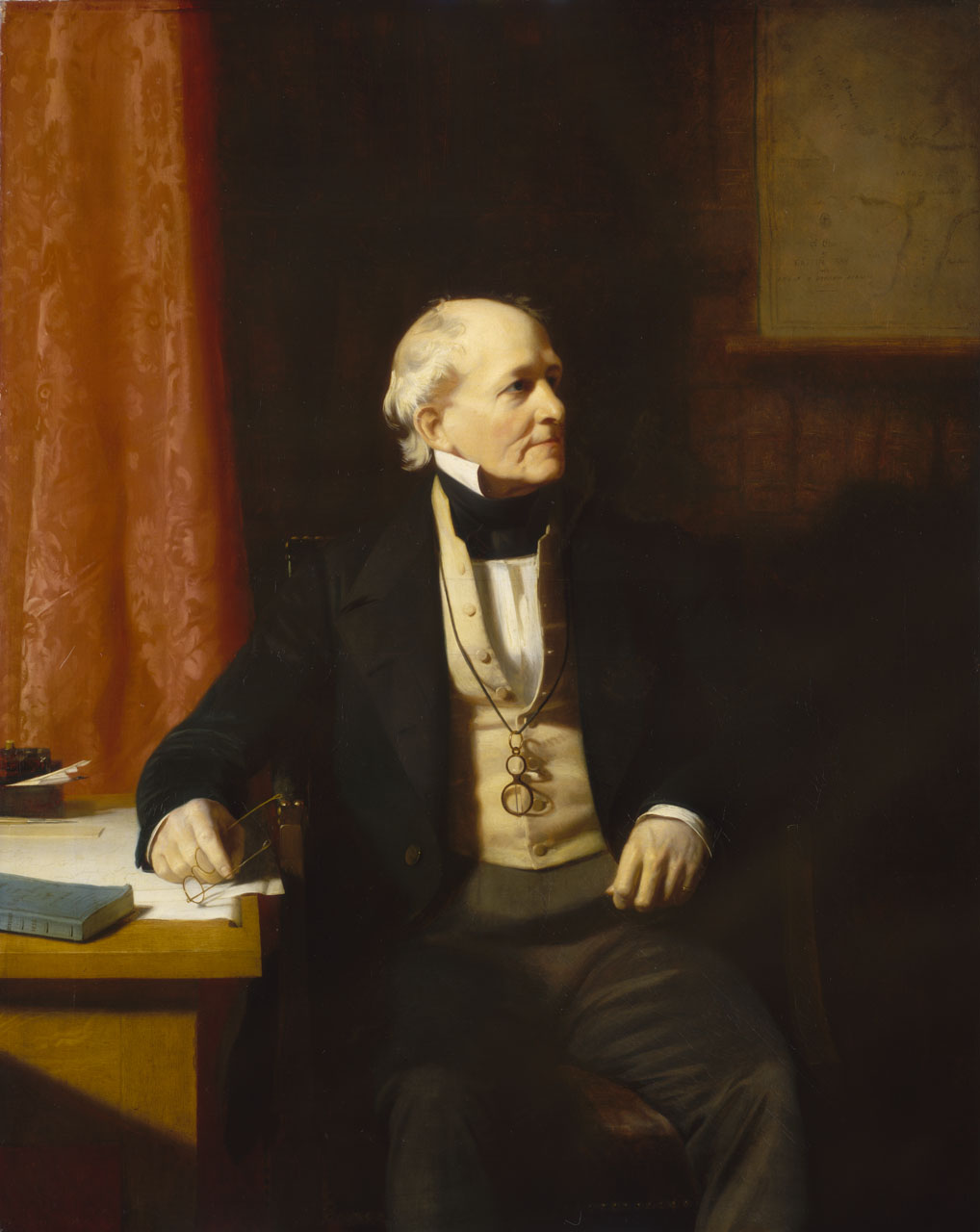
2022 Schools Spectacular
- Avalon Public School
- Belrose Arts Alive
- Collaroy Plateau Public School
- Curl Curl North Public School
- Davidson High School
- Elanora Heights Public School
- Forestville Public School
- Harbord Public School
- Killarney Heights High School
- Mona Vale Public School
- Narrabeen Lakes Public School
- Narrabeen Sports High School
- Neutral Bay Public School
- Northern Beaches Secondary College Cromer Campus
- Northern Beaches Secondary College Freshwater Senior Campus
- Northern Beaches Secondary College Mackellar Girls Campus
- Northern Beaches Secondary College Manly Campus
- Pittwater High School
- has taken place annually at Qantas Credit Union Arena (formerly known as the Sydney Entertainment Centre) since 1984, and in 2016 was held at the Qudos Bank Arena.
- in 2016, set a new GUINNESS WORLD RECORDS TM for the Largest Amateur Variety Act with over 5,300 students performing in the show!
- is an established and well-recognised event on the Sydney live entertainment calendar
- showcases a cast of 2,300 dancers, a combined choir of 2,500, an 80-piece full symphony orchestra, and a 25-piece stage band
- delivers outstanding, cutting-edge artistry in dance and musical performance
- features state-of-the-art sound, lighting and staging
- is televised nationally in prime-time on Channel 7.
- Dates: show week rehearsals – Monday 21 November to Thursday 24 November 2022, including final combined dance rehearsal, orchestra and stage band sound checks, mass choir rehearsal and dress rehearsal.
- Performances: Friday, 25 November, and Saturday, 26 November 2022, including the schools’ preview matinee, Friday evening, Saturday matinee and Saturday evening performances.

Ho Ho Ho ... Pencil In This Date
The popular Christmas card competition has been expanded to more primary school students.
‘All I want for Christmas’ is the theme of this year’s competition for students to design a Christmas card for the Minister for Education and Early Learning, Sarah Mitchell, and senior department executives.
The annual competition is now open to students from Kindergarten to Year 6.
The winning artist will have their artwork featured on the Minister’s 2022 Christmas card and receive a book pack and 20 copies of the card. The runners up will feature on cards for the Department of Education Secretary, Georgina Harrisson, and Deputy Secretaries – School Performance, Murat Dizdar and Leanne Nixon.
The competition has previously been open only to Kindergarten students. Last year’s winning image from Hayley Shepard from Surveyors Creek Public School in Glenmore Park featured a dream of waking up to a puppy in Santa’s stocking.
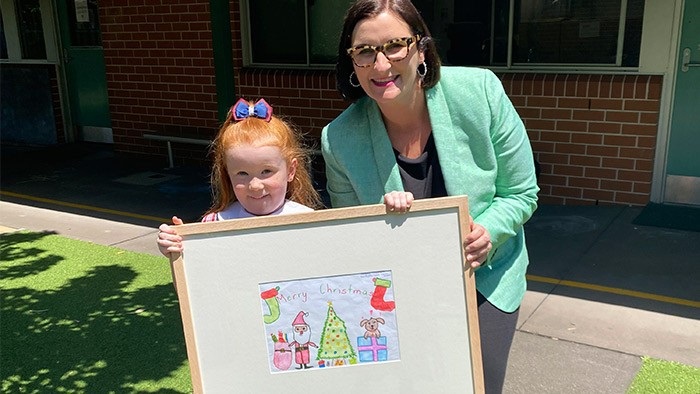
Doggone it: Hayley Shepherd and Education Minister Sarah Mitchell hold Hayley's winning design.
How to enter
Schools can submit artwork entries on behalf of students by email to mcc@det.nsw.edu.au by 5pm on 17 October 2022. Please name saved artwork files in the format of schoolname-firstname-lastname.png, such as Christmas-PS-Santa-Claus.png.
Artworks can be created in any medium but should be no larger than 21cm x 30cm (A4). The artworks may be in portrait or landscape format.
The winning artists will be notified by 29 October 2022.
Kindergarten In Sydney In 1968
From the Film Australia Collection. Made by the Commonwealth Film Unit 1968. A look at how a group of Sydney children spend their day at kindergarten.
Spring Things: Pittwater Butterflies
Over the next few weeks and months we will see a lot more butterflies flitting around our gardens. This week we share some of those you may see. Perhasp you remmeber a few years ago when a cloud of these butterflies flew over our area, heading out to sea:
.jpg?timestamp=1605953908045)
Caper White Butterfly, Elenois java, - photo by A J Guesdon, November 20, 2020
The Blue Triangle Butterfly - Graphium sarpedon choredon, is just one of around 400 butterflies seen in Australia with a dozen endemic species and even some of the world's largest found only here.
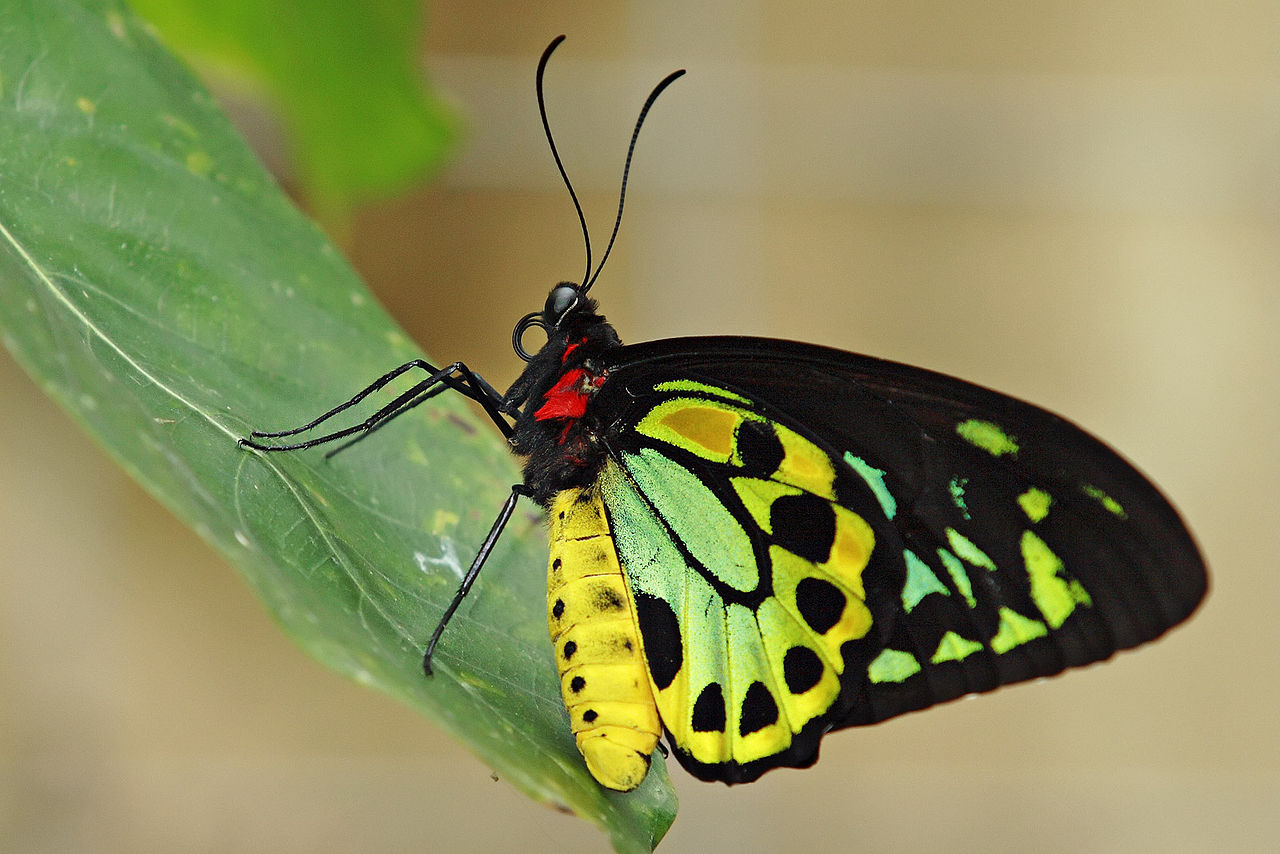
Cairns birdwing (Ornithoptera euphorion): Australia's largest endemic butterfly, photo by Lepidlizard, and side view taken at Melbourne zoo by fir0002 - both from Wikipedia
The Cairns birdwing butterfly wingspan can be up to 15 cm (5.9 in) in females, and 12.5 cm (4.9 in) in males. A closely allied species, the New Guinea or Priam's birdwing (Ornithoptera priamus) reaches 19 cm (7.5 in) and is the largest butterfly species found in Australia, but it is not endemic.
Australia butterflies come from seven families: Papilionidae: swallowtails, Nymphalidae: brush– or four-footed, Pieridae: whites and yellows, Coliadinae: yellows, Riodinidae: metalmarks, Lycaenidae: gossamer-winged blues and coppers, and Hesperiidae: skippers.
September through April is when see the most butterflies through Sydney, although some are spotted during the cooler months of May and June as well. There is a great webpage hosted here which lists many of the butterflies you will see in Sydney.
The Blue Triangle Butterfly, like the Cairns birdwing, are Swallowtail butterflies - the large, colourful butterflies in the family Papilionidae, and include over 550 species. Though the majority are tropical, members of the family inhabit every continent except Antarctica.
The Blue Triangle is also known for being excellent of vision - from a 2016 study:
When researchers studied the eyes of Common Bluebottles, a species of swallowtail butterfly from Australasia, they were in for a surprise. These butterflies have large eyes and use their blue-green iridescent wings for visual communication -- evidence that their vision must be excellent. Even so, no-one expected to find that Common Bluebottles (Graphium sarpedon) have at least 15 different classes of "photoreceptors" -- light-detecting cells comparable to the rods and cones in the human eye. Previously, no insect was known to have more than nine.
"We have studied color vision in many insects for many years, and we knew that the number of photoreceptors varies greatly from species to species. But this discovery of 15 classes in one eye was really stunning," says Kentaro Arikawa, Professor of Biology at Sokendai (the Graduate University for Advanced Studies), Hayama, Japan and lead author of the study.
Have multiple classes of photoreceptors is indispensable for seeing color. Each class is stimulated by light of some wavelengths, and less or not at all by other wavelengths. By comparing information received from the different photoreceptor classes, the brain is able to distinguish colors.
Photographed at Surf Road, Whale Beach
Another swallowtail that visits Sydney from October to May is the Papilio aegeus, the orchard swallowtail butterfly or large citrus butterfly. Both male and female have black forewings with a white stripe, though there is more white overall on the female forewing. The hindwing is again black, and there is a white swath through the middle. Here the markings differ in that the female has chains of red to orange and blue crescents toward the edge. The markings on the underside are similar to those on top. The body is black. The wingspan is about 140 millimetres (5.5 in) in females and 120 millimetres (4.7 in) in males, making it rather large overall and the largest butterfly commonly seen in at least part of its range.
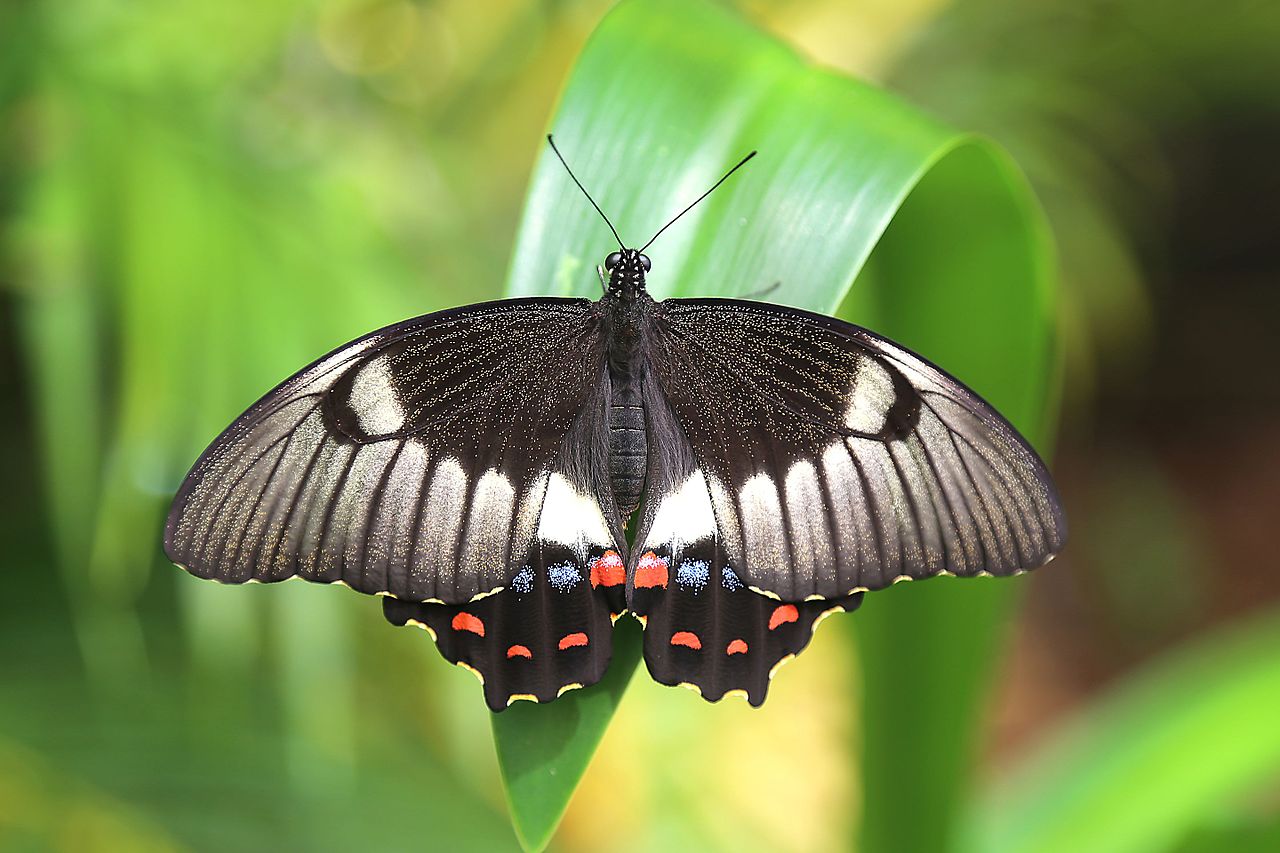
Orchard Swallowtail butterfly female (Papilio aegeus) taken in Cairns, Queensland by Summerdrought, CC BY-SA 4.0
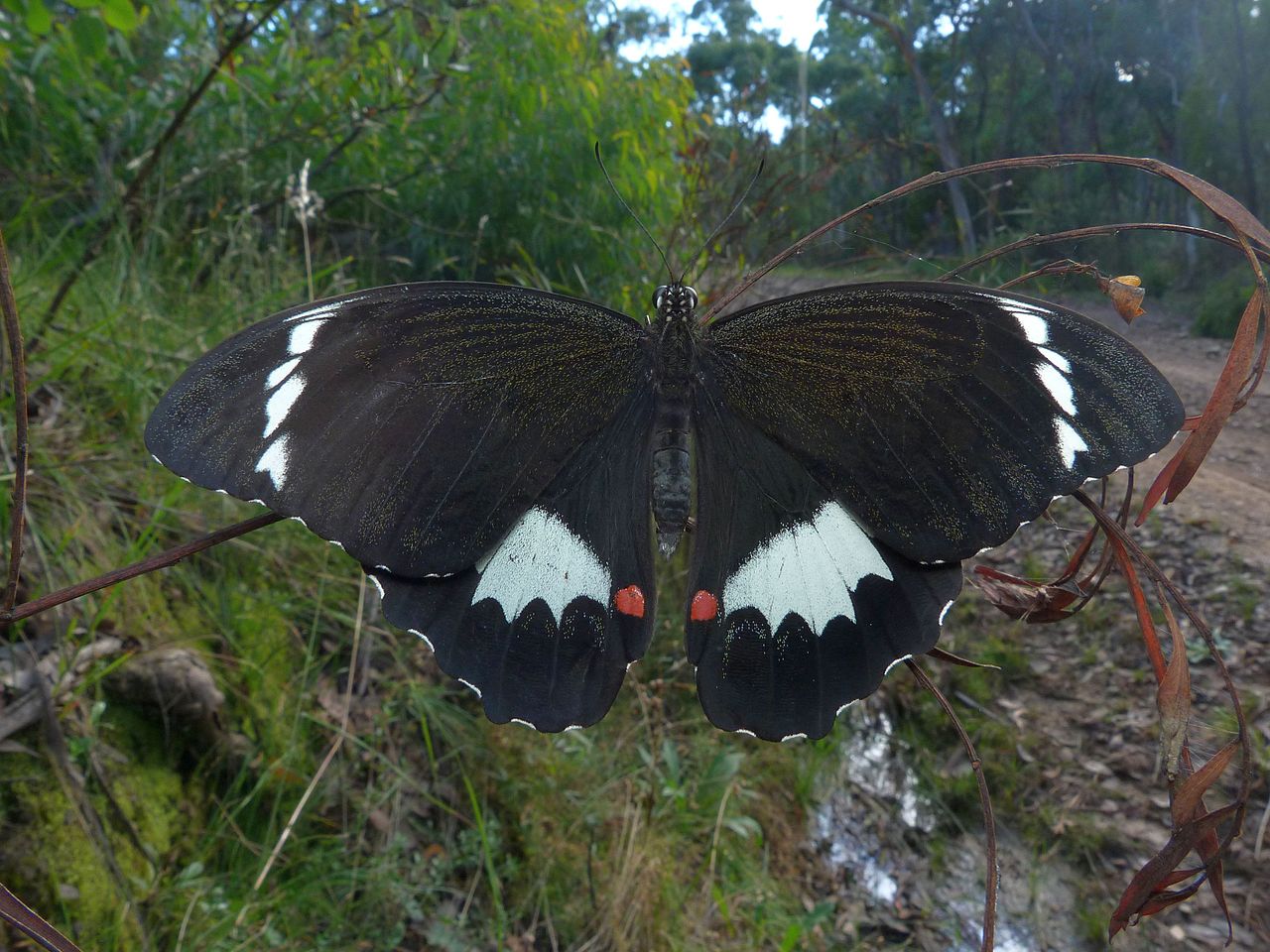
Papilio aegeus Donovan, 1805 (Orchard Swallowtail), male, Black Mountain, Canberra, ACT, 14 February 2011 - photo by Donald Hobern, CC BY 2.0
Despite being a swallowtail, which group derives its name from the distinctive tails on the hindwing, this characteristic is entirely absent.
The swallowtail butterflies also lead to pointing out another fact - new butterflies are still being discovered - for example, this news ran in our Environment page a few years ago:
New species of Swallowtail butterfly discovered in Fiji
October 30, 2018: University of Oxford
A spectacular new butterfly species has been discovered on the Pacific Island of Vanua Levu in Fiji. The species, named last week as Papilio natewa after the Natewa Peninsula where it was found, is a remarkable discovery in a location where butterfly wildlife was thought to be well known.
The large Swallowtail was first photographed in 2017 by Australian ornithologist Greg Kerr, working with Operation Wallacea, an international organisation which supports school students in science projects.
Specialists around the world were puzzled when Kerr's photograph was sent for identification. It was not until earlier this year, during a second fieldtrip to Fiji, that it was confirmed as a species new to science by John Tennent, Honorary Associate at Oxford University Museum of Natural History, and Scientific Associate of the Natural History Museum, London.
"For such an unusual and large new butterfly to be discovered somewhere we thought was so well known is remarkable," said John Tennant, who is a Pacific butterfly specialist. The species was named by Tennant and colleagues in Fiji and Australia in a paper published this month in Entomologischer Verein Apollo.
Tennant has spent long periods in the Pacific, including the Solomon Islands and eastern Papua New Guinea and has found and named over a hundred new species and subspecies of butterflies in the last 25 years. But he describes the new Natewa Swallowtail as "easily the most spectacular." The find is especially remarkable because there are only two Swallowtail butterfly species previously known from this part of the Pacific, and only one from Fiji.
"Because they are large, conspicuous and often beautiful in appearance, Swallowtail butterflies have been intensively studied for over 150 years," says James Hogan, manager of butterfly (Lepidoptera) collections at Oxford University Museum of Natural History.
"To find a new species like this, not only in a small and reasonably well-studied area like Fiji, but also one which looks unlike any other Swallowtail is truly exceptional. For John Tennent, Greg Kerr and the rest of the team this really is a once-in-a-lifetime discovery."
The Natewa Swallowtail has remained undiscovered for so long perhaps due to its habits and the geological history of the islands. Unusually for a Swallowtail, it seems to be a true forest species, spending most of its life inside the forest at elevations above 250 metres, on land with restrict access rights.
"It does make you wonder what else awaits discovery in the world's wild places. The key to finding new and interesting things is simply to go and look," adds Tennant.
An online version of this story is available on the Oxford University Museum of Natural History blog, More than a Dodo, at: https://morethanadodo.com/2018/10/30/fijis_swallowtail_surprise/
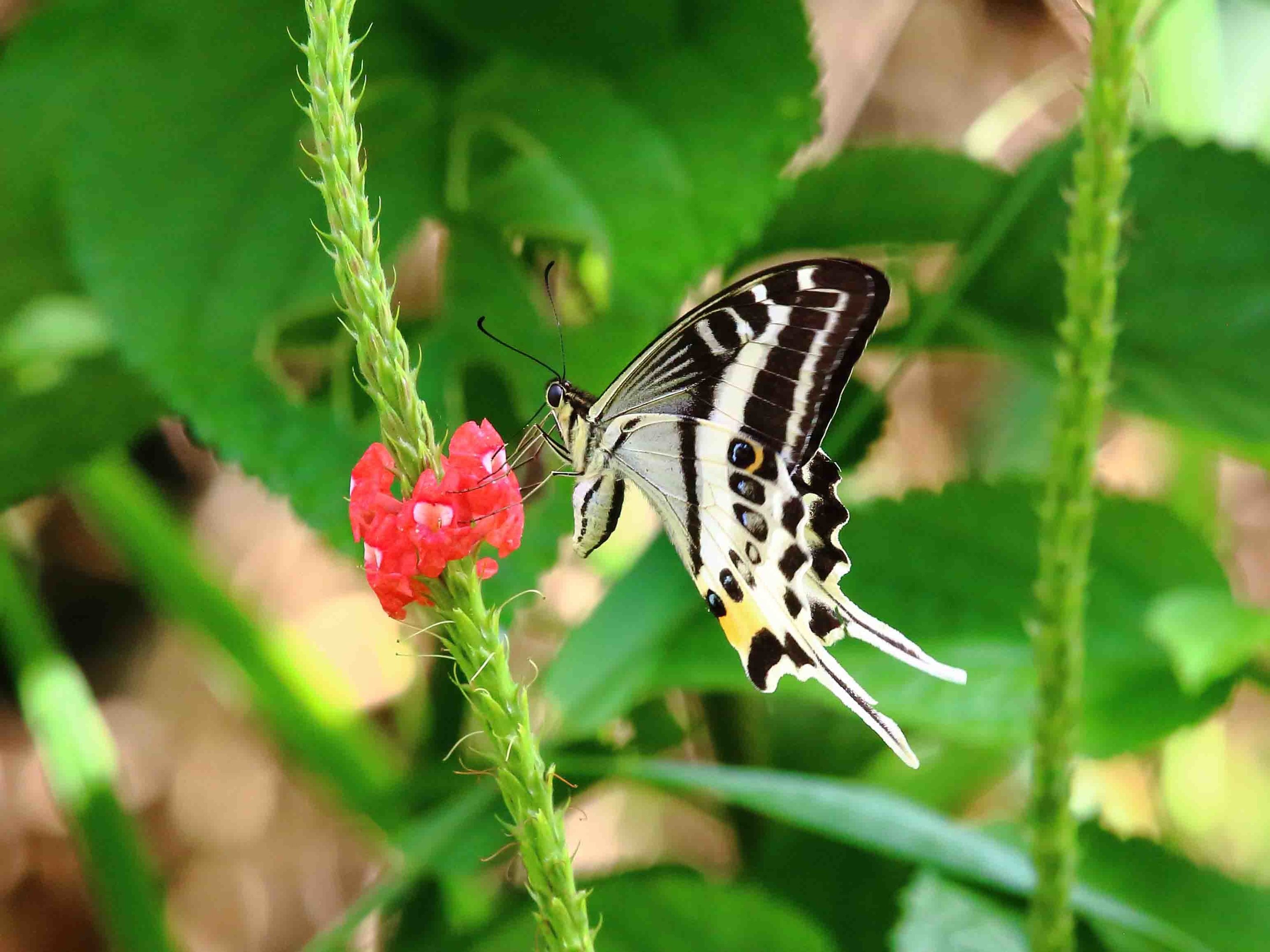
The large Swallowtail, now named Papilio natewa, was first photographed in 2017 by Australian ornithologist Greg Kerr, working with Operation Wallacea.
Papilio natewa was one of four new species of butterflies discovered or named in 2018; the Cyllopsis tomemmeli in Mexico, named for Thomas Emmel, now 76 and an internationally recognised Lepidoptera expert at the University of Florida, who went on his first expedition at age 17, Wahydra graslieae, named to honour Emily Graslie the Field Museum in Chicago's chief curiosity correspondent, and Catasticta sibyllae, named for Maria Sibylla Merian an artist who sailed across the Atlantic on a largely self-funded scientific expedition to document the animals and plants of Dutch Suriname in 1699.
In 2017 there were more 'new' butterflies discovered, some among collections not yet examined and some found 'in the field' as Mr. Kerr did, including this one -
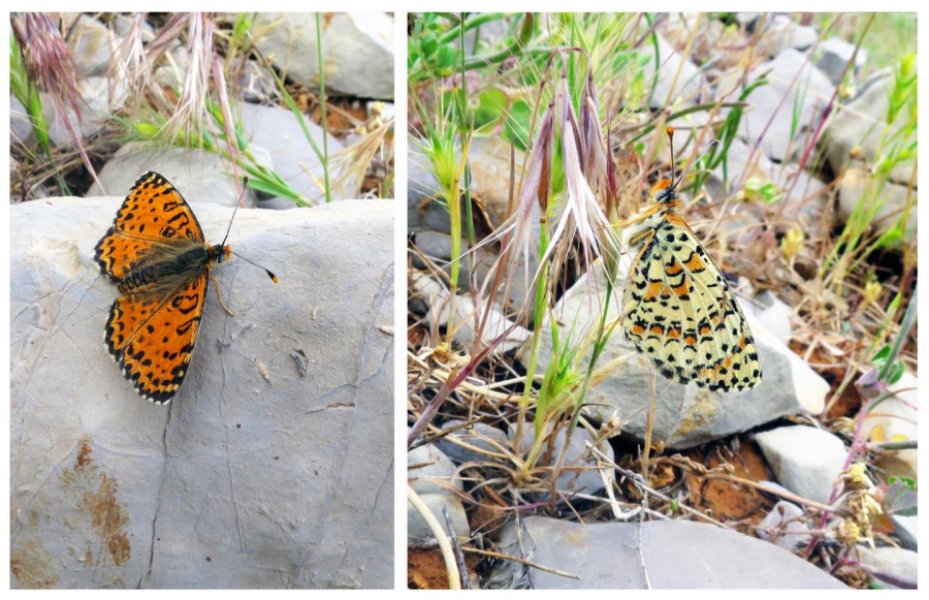
This is Acentria's fritillary (Melitaea acentria), a new butterfly species discovered in Israel on the slopes of the popular Mount Hermon ski resort. Credit: Dr Vladimir Lukhtanov; CC-BY 4.0
The Acentria's fritillary seems to be endemic in northern Israel and the neighbouring territories of Syria and Lebanon. Its evolutionary history is likely to prove interesting.
"The species is probably one of a handful of butterflies known to have arisen through hybridisation between two other species in the past," says Lukhtanov. "This process is known to be common in plants, but scientists have only recently realised it might also be present in butterflies."
This is the first new butterfly species discovered and described from the territory of Israel in 109 years.
Vladimir A. Lukhtanov. A new species of Melitaea from Israel, with notes on taxonomy, cytogenetics, phylogeography and interspecific hybridization in the Melitaea persea complex (Lepidoptera, Nymphalidae). Comparative Cytogenetics, 2017; 11 (2): 325 DOI: 10.3897/CompCytogen.v11i2.12370
A perusal of science articles shows that new species of Butterflies are always being discovered - and well worth keeping an eye out for.
Another butterfly specific to here is the Australian painted lady (Vanessa kershawi) butterfly is mostly confined to Australia, although westerly winds have dispersed it to islands east of Australia, including New Zealand. Some debate surrounds the taxonomy of this species. Some believe that the Australian painted lady should be a subspecies of the painted lady (Vanessa cardui) due to the similarity in lifestyle and behaviour. Furthermore, the painted lady is found around the globe, but Australia is the only location in which it varies enough to be considered a separate species.
This can be seen around Sydney at any time except Winter. The Australian painted lady belongs to the family Nymphalidae and genus Vanessa, which compromises 22 species, which are strongly migratory.
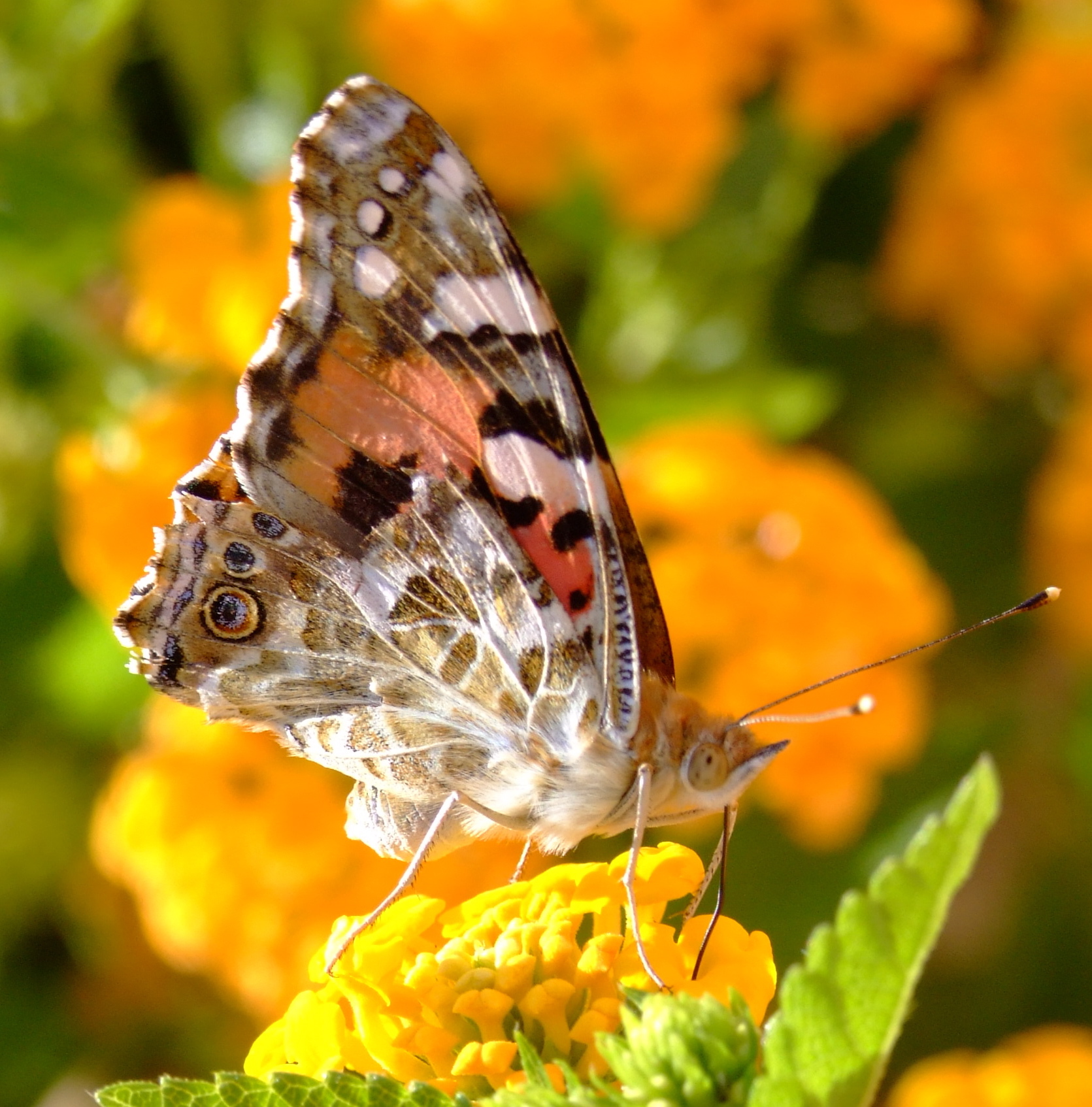
Australian painted lady on yellow flower - photo by Gaetan Lee - Flickr
During spring, adult butterflies migrate south in large numbers from northern states of Queensland and New South Wales. To find mates, male Australian painted ladies exhibit territorial behaviour, which involves a male perching on vegetation in a sunny spot on a hilltop, waiting for females to fly by.
Despite urbanisation and invasive plants altering its habitat, populations of Australian painted ladies have not been significantly impacted by these changes.
The life cycle of the Australian painted lady lasts around 53 days in the summer. The females lay eggs in the centre of the leaf of food plants. The eggs are green and hatch in about three days. As a caterpillar, the Australian painted lady is only active at night, during which its main activity is feeding. During the day, it hides in a curled leaf or at the foot of a food plant. The pupa hangs vertically from the underside of the leaf of a food plant, and the duration of the pupal stage is about two weeks.
The Australian painted lady typically uses the native Australian everlastings and other daisies as a host and food plant. However, it also feeds on several introduced species, including capeweed (Arctotheca calendula), Scotch thistle (Onopordum acanthium), and lavender (Lavandula angustifolia). The adults feed on the nectar of flowers.
Another in the Nymphalidae family, which can be seen in Sydney at just about anytime and anywhere, is the Monarch butterfly or simply Wanderer (Danaus plexippus). These live for around four months and spend pretty much all of that time doing what their name describes - wandering!
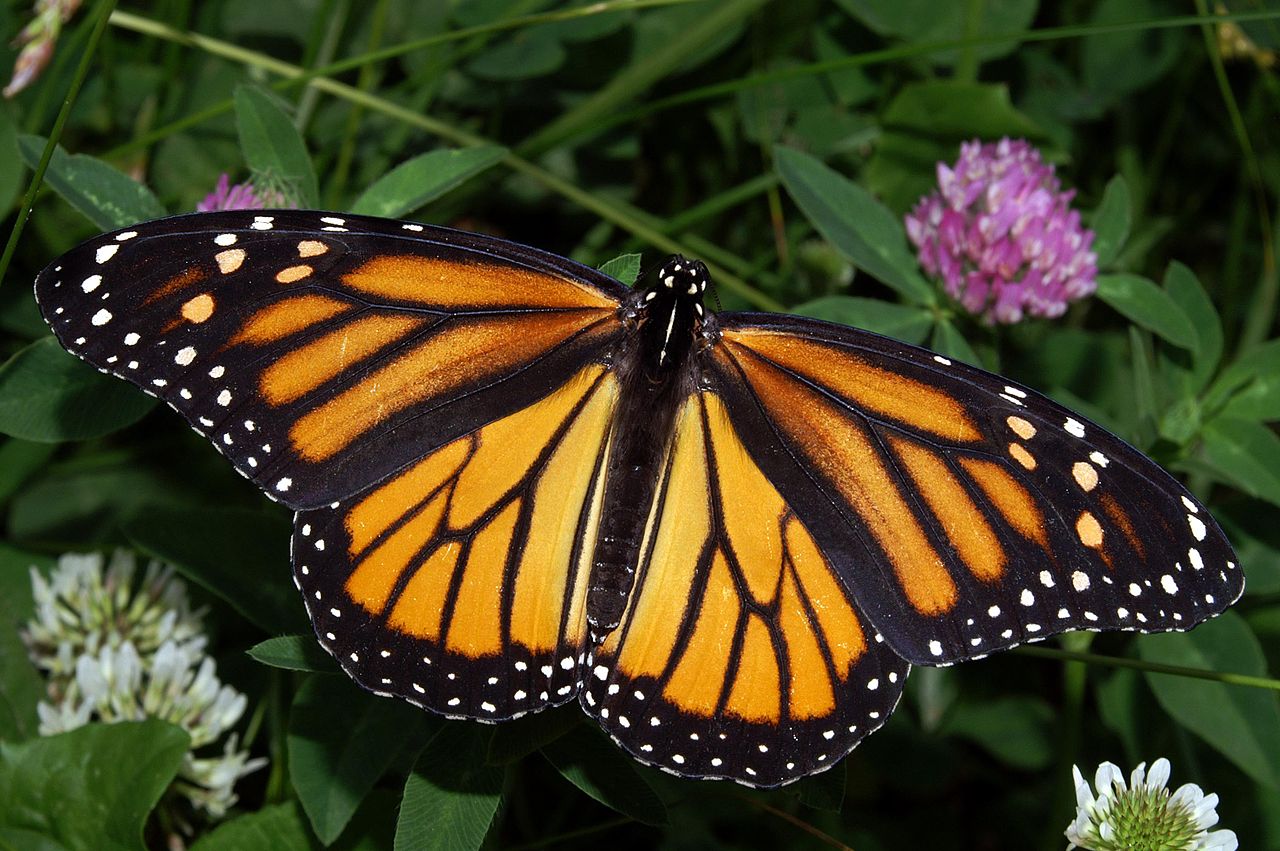
Monarch Butterfly, female - photographed in May by Kenneth Dwain Harrelson, CC BY-SA 3.0
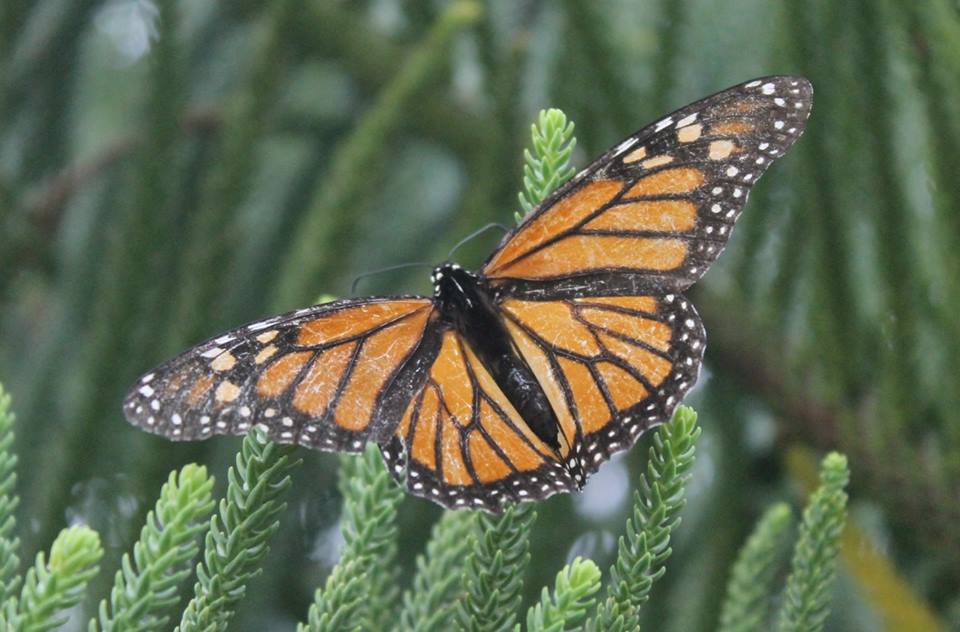
One photographed at Narrabeen in 2015 by A J Guesdon
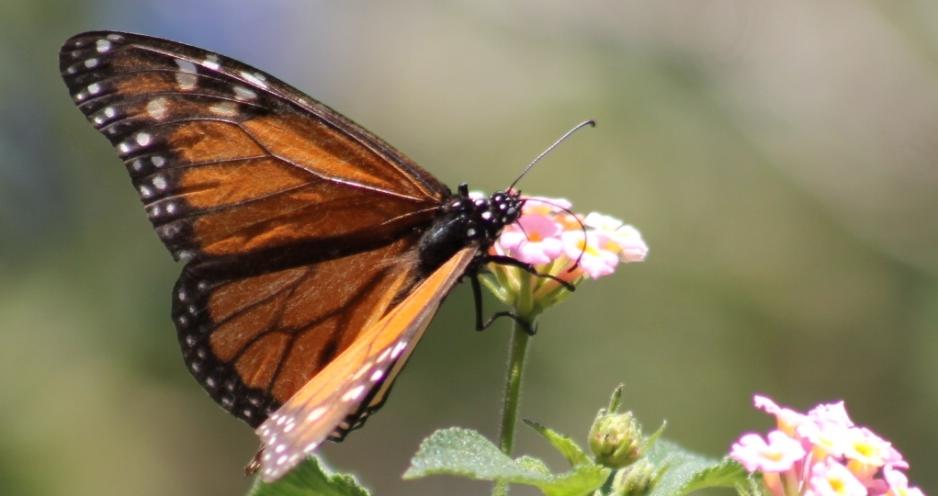
In September, 2013 - photo by A J Guesdon
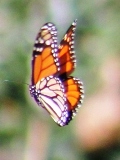 The name "monarch" is believed to be given in honour of King William III of England, whose secondary title Prince of Orange makes a reference to the butterfly's main colour. The monarch was originally described by Carl Linnaeus in his Systema Naturae of 1758 and placed in the genus Papilio. In 1780, Jan Krzysztof Kluk used the monarch as the type species for a new genus Danaus.
The name "monarch" is believed to be given in honour of King William III of England, whose secondary title Prince of Orange makes a reference to the butterfly's main colour. The monarch was originally described by Carl Linnaeus in his Systema Naturae of 1758 and placed in the genus Papilio. In 1780, Jan Krzysztof Kluk used the monarch as the type species for a new genus Danaus.
Danaus, a great-grandson of Zeus, was a mythical king in Egypt or Libya, who founded Argos; Plexippus was one of the 50 sons of Aegyptus, the twin brother of Danaus. In Homeric Greek, his name means "one who urges on horses", i.e. "rider" or "charioteer". In the 10th edition of Systema Naturae, at the bottom of page 467, Linnaeus wrote that the names of the Danai festivi, the division of the genus to which Papilio plexippus belonged, were derived from the sons of Aegyptus. Linnaeus divided his large genus Papilio, containing all known butterfly species, into what we would now call subgenera. The Danai festivi formed one of the "subgenera", containing colourful species, as opposed to the Danai candidi, containing species with bright white wings. Linnaeus wrote: "Danaorum Candidorum nomina a filiabus Danai Aegypti, Festivorum a filiis mutuatus sunt." (English: "The names of the Danai candidi have been derived from the daughters of Danaus, those of the Danai festivi from the sons of Aegyptus.")
Robert Michael Pyle suggested Danaus is a masculine version of Danaë, Danaus's great-great-granddaughter, to whom Zeus came as a shower of gold, which seemed to him a more appropriate source for the name of this butterfly.
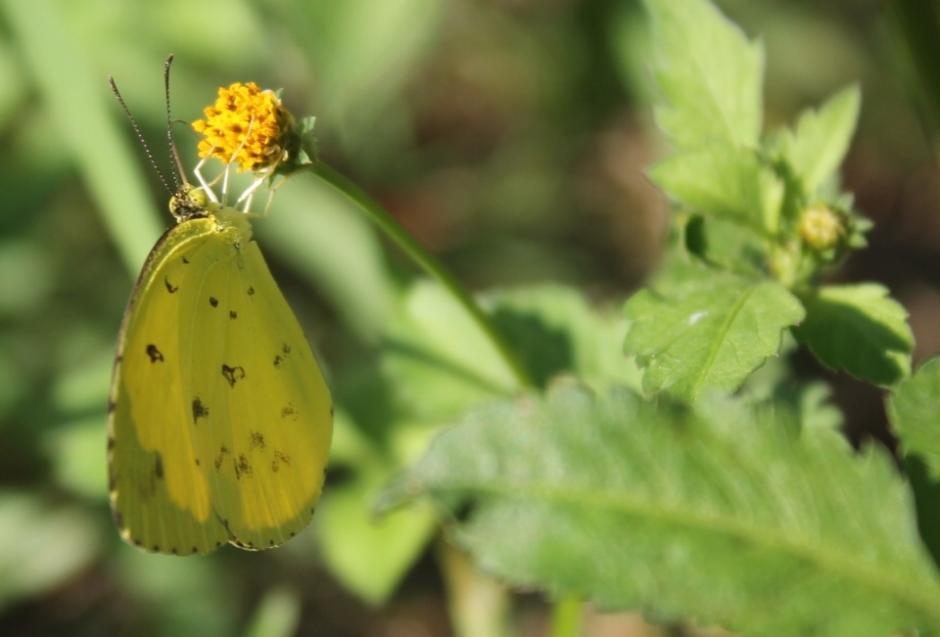
Eurema brigitta on bright yellow dandelion flower - photo by A J Guesdon, April 2016
Another in the same family Pieridae you may see almost year round is the introduced Pieris rapae, the small white, is a small to medium-sized butterfly species of the whites-and-yellows family Pieridae. It is also known as the small cabbage white and in New Zealand, simply as white butterfly. The names "cabbage butterfly" and "cabbage white" can also refer to the large white. The butterfly can be distinguished by the white colour with small black dots on its wings. They are further distinguished by the smaller size and lack of the black band at the tip of their forewings.
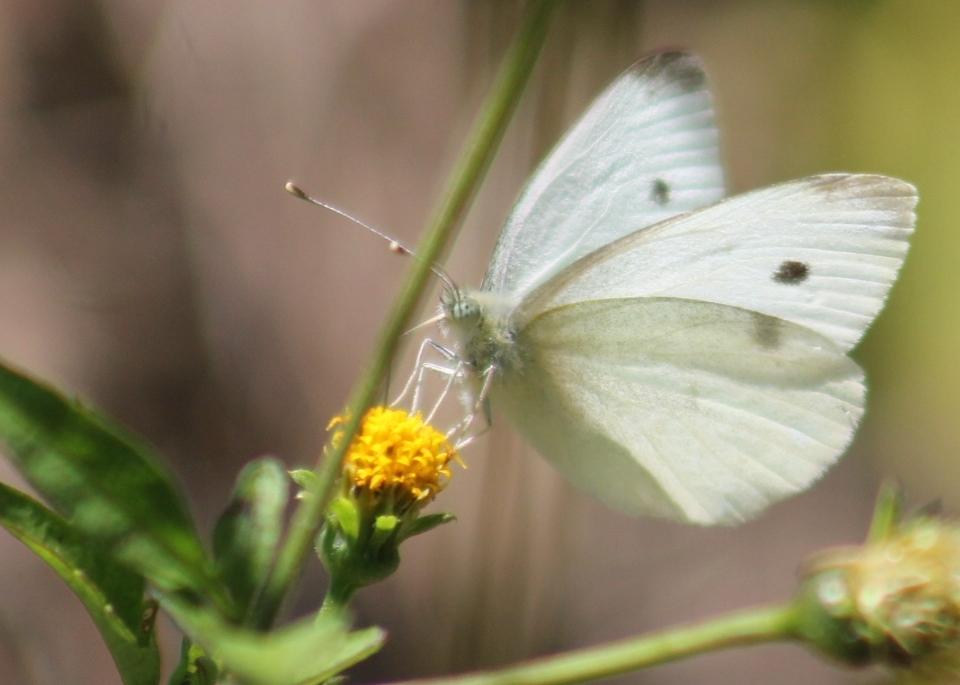
Photo by A J Guesdon, November 2015
It is widespread and is believed to have originated in Europe or Asia. It is also found in North Africa and was accidentally introduced to North America, Bermuda, Australia and New Zealand. The caterpillar of this species is seen as a pest for commercial agriculture. Often referred to as the "imported cabbageworm" they are a serious pest to cabbage and other mustard family crops.
So for those who ascribe to Shakespeare's line from Hamlet - There are more things in heaven and earth, Horatio, than are dreamt of in your philosophy - have a closer look next time you see something colourful flitting by - you may be the first to do so.
Visit:
Butterflies of Australia: http://lepidoptera.butterflyhouse.com.au/butter.html
List of butterflies of Australia. In Wikipedia, The Free Encyclopedia. Retrieved from https://en.wikipedia.org/w/index.php?title=List_of_butterflies_of_Australia&oldid=875690239
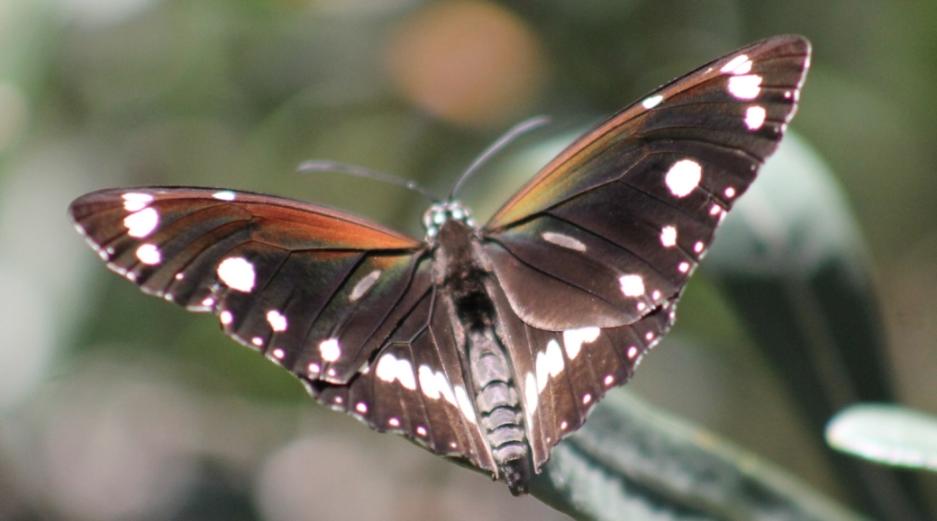
Bumblebees And Honeybees
By SciShow Kids
You see them when it’s warm outside, hanging out in flowers and working away. Bees! Check out what these buzzing insects are up to, and how you can tell the difference between a bumblebee and a honey bee.
All About Frogs For Youngsters
By Free School
With thousands of known species, frogs and toads make up more than 88% of all known amphibians on earth. Frogs have peculiar skin that allows them to breathe both above and under the water. Learn really cool facts and trivia about frogs in this brief, child-friendly documentary, including a section on poison dart frogs and the metamorphosis from tadpole to frog.
How To Draw A Penguin In Just 3 Minutes!
Earth Sketch Pad | BBC Earth Kids
How do ants crawl on walls? A biologist explains their sticky, spiky, gravity-defying grip
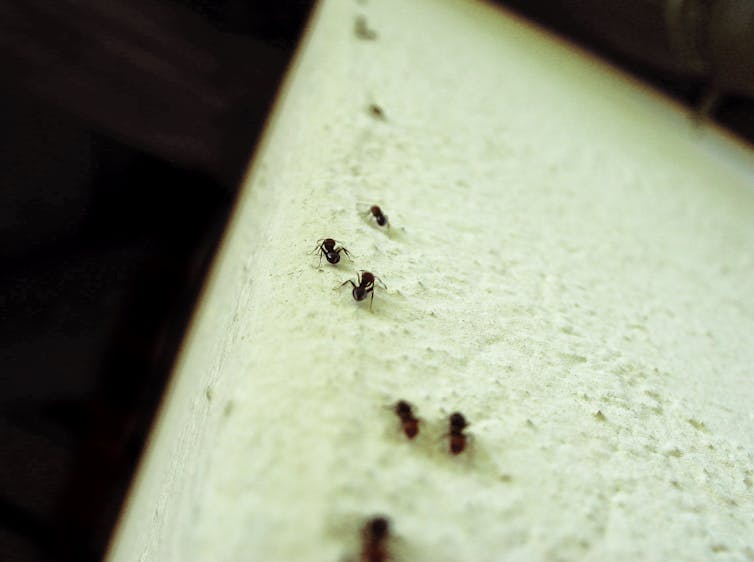

Curious Kids is a series for children of all ages. If you have a question you’d like an expert to answer, send it to curiouskidsus@theconversation.com.
How do ants crawl on walls? – Ethan, age 9, Dallas, Texas
When I first started my job as a biologist at the University of South Florida, I drove my Jeep to a grassy field, dug up a mound of fire ants and shoveled it into a 5-gallon bucket. Immediately, thousands of ants swarmed out of the soil and up the walls of the bucket headed for freedom. Luckily I had a lid.
How do ants make climbing walls, ceilings and other surfaces look so easy? I’ve been studying ants for 30 years, and their climbing abilities never cease to amaze me.
Worker ants – who are all female – have an impressive toolbox of claws, spines, hairs and sticky pads on their feet that enable them to scale almost any surface.
Human Hands Vs. Ant Feet
To understand ant feet, it helps to compare them with human hands. Your hand has one broad segment, the palm. Sprouting from your palm are four fingers and an opposable thumb. Each finger has three segments, while your thumb has only two segments. A hard nail grows from the tips of your fingers and thumb.
Humans have two hands – ants have six feet. Ant feet are similar to your hands but are more complex, with an additional set of weird-looking parts that enhance them.
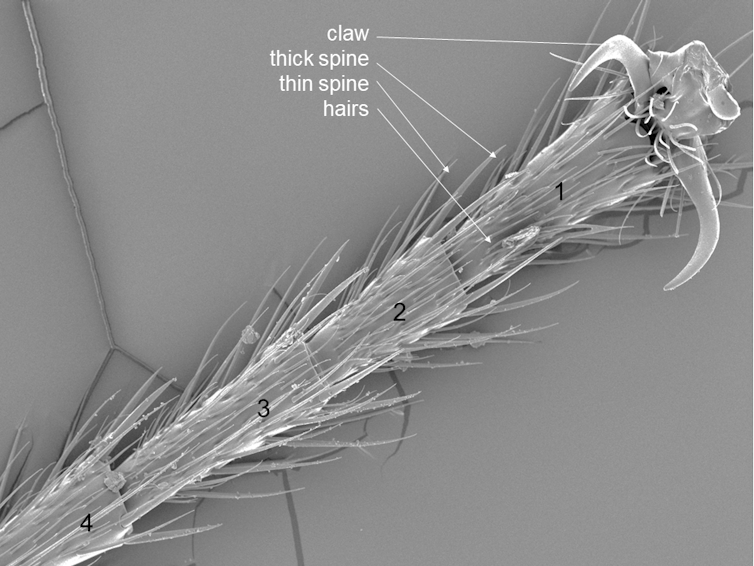
Ant feet have five jointed segments, with the end segment sporting a pair of claws. The claws are shaped like a cat’s and can grip irregularities on walls. Each foot segment also has thick and thin spines and hairs that provide additional traction by sticking into microscopic pits on textured surfaces like bark. Claws and spines have the added benefit of protecting ant feet from hot pavement and sharp objects, just as your feet are protected by shoes.
But the feature that truly separates human hands from ant feet are inflatable sticky pads, called arolia.
Sticky Feet
Arolia are located between the claws at the tip of every ant foot. These balloonlike pads allow ants to defy gravity and crawl on ceilings or ultrahard surfaces like glass.
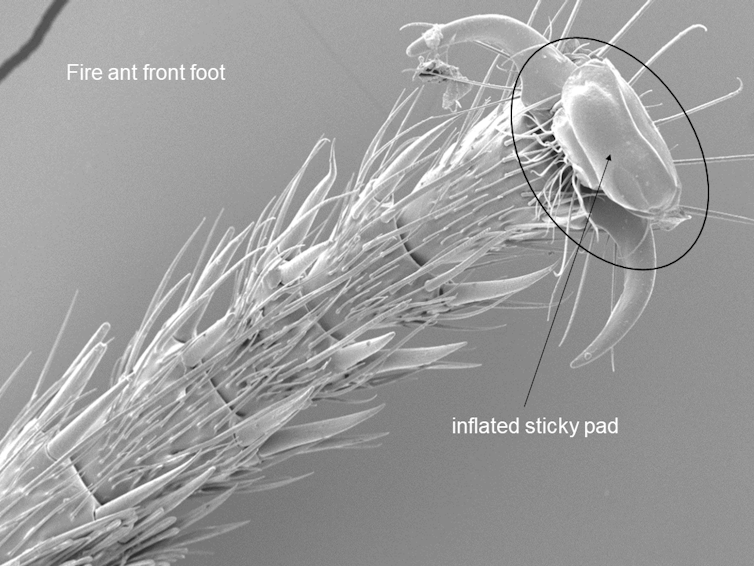
When an ant walks up a wall or across a ceiling, gravity causes its claws to swing wide and pull back. At the same time, its leg muscles pump fluids into the pads at the end of its feet, causing them to inflate. This body fluid is called hemolymph, which is a sticky fluid similar to your blood that circulates throughout an ant’s body.
After the hemolymph pumps up the pad, some of it leaks outside the pad, which is how ants can stick to a wall or a ceiling. But when an ant picks up its foot, its leg muscles contract and suck most of the fluid back into the pad and then back up the leg. This way an ant’s blood is reused over and over – pumped from the leg into the pad, then sucked back up the leg – so none is left behind.

Ants are feather-light, so six sticky pads are enough to hold them against the pull of gravity on any surface. In fact, at home in their underground chambers, ants use their sticky pads to sleep on the ceiling. By sleeping on the ceiling, ants avoid the rush-hour traffic of other ants on the chamber floors.
A Unique Gait
When you walk, your left and right feet alternate so one is on the ground while the other is in the air, moving forward. Ants also alternate their feet, with three on the surface and three in the air at a time.
The walking pattern of ants is unique among six-legged insects. In ants, the front and back left feet are on the ground with the middle right foot, while the front and back right feet and the middle left foot are in the air. Then they switch. It’s fun to try to copy this triangular pattern using three fingers on each hand.
The next time you see an ant crawling up a wall, look closely and you might witness some of these fascinating features at work.
Hello, curious kids! Do you have a question you’d like an expert to answer? Ask an adult to send your question to CuriousKidsUS@theconversation.com. Please tell us your name, age and the city where you live.
And since curiosity has no age limit – adults, let us know what you’re wondering, too. We won’t be able to answer every question, but we will do our best.![]()
Deby Cassill, Associate Professor of Integrative Biology, University of South Florida
This article is republished from The Conversation under a Creative Commons license. Read the original article.
Curious Kids: what is exotic matter, and could we use it to make wormholes?

What is exotic matter, and could we use it to make wormholes? – Julia, aged 14, London
Matter is “stuff”. It is anything that is made up of particles that take up space. Everything we can feel and see on Earth is matter, and it’s usually in one of three types: solid, liquid or gas. This could be the chair you’re sitting on, sea water, or the helium in a balloon.
There are other types of matter that do not behave like the gases, liquids or solids that we normally encounter on Earth. The ones that behave in the weirdest ways are called exotic matter.
We can create exotic matter in laboratories by cooling some materials to very low temperatures. Extremely cold helium is one example. It is called superfluid helium, and is a liquid that can climb walls.
It’s possible that exotic matter could one day explain some of the mysteries of space. It might be a key ingredient for making a wormhole.
Bending Space And Time
A wormhole is something that connects two places in the universe by bending space. A wormhole has never been found, but if it did exist then it could obey our laws of gravity.
In 1687, scientist Isaac Newton said that gravity is created by the mass of an object. The mass of an object is the amount of matter in it. This means that the more matter there is in the object then the bigger the gravitational pull towards that object.

Curious Kids is a series by The Conversation that gives children the chance to have their questions about the world answered by experts. If you have a question you’d like an expert to answer, send it to curiouskids@theconversation.com and make sure you include the asker’s first name, age and town or city. We won’t be able to answer every question, but we’ll do our very best.
In 1915, physicist Albert Einstein changed our view of what creates gravity.
Einstein said that matter bends space. He said that moving objects will follow the curvature of this bent space, and it is this that creates the effect of gravity.
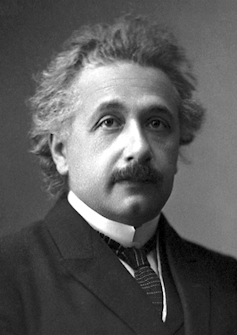
For example, Earth is made of matter, and it makes the space around it bend. When objects move around the Earth they follow the bent space which makes them fall towards Earth. This is what we call gravity.
This curving of space caused by matter also affects time. The more curved space is, then the slower time passes. Because space and time are so closely connected, we often talk about space-time when investigating how the universe works.
A wormhole is formed by space-time curving in such a way that a tunnel forms between two separate regions in the universe. Where the tunnel comes out into space it is called the “mouth”. A wormhole has two mouths that can be separated by an enormous distance, and the tunnel itself is called the “throat”.
Creating A Wormhole
One type of exotic matter that could be related to wormholes is matter with negative mass. All matter we know has a positive mass and is attracted to other matter due to gravity – like an apple falling to Earth. Matter with a negative mass would push other matter away from it.
The physicist Kip Thorne proposed that negative matter would be needed to keep a wormhole stable once it has formed. We have never detected negative matter, and we do not even know what it would look like, but it is something that we can put into equations and understand how it would behave if it did exist.
Although we can say what a wormhole is, we do not know how to create one, so we cannot know if exotic matter can make wormholes.
Wormholes are interesting to scientists and science fiction writers because there is a possibility that wormholes could link two regions in space that are far apart. If they did exist, we could perhaps travel vast distances across the universe in a short time.![]()
Carolyn Devereux, Senior Lecturer in Astrophysics, University of Hertfordshire
This article is republished from The Conversation under a Creative Commons license. Read the original article.
Dementia Action Week
19 – 25 September 2022
- Give a little support to a person living with dementia.
- Give a little support to a carer, friend or family member of a person living with dementia.
- Help healthcare professionals make their practice more dementia-friendly.
Celebrities Combine Forces And Voices To Support People Impacted By Dementia + National Dementia Helpline Now 24/7
Seven Healthy Lifestyle Habits May Reduce Dementia Risk For People With Diabetes
Risk Factor For Developing Alzheimer's Disease Increases By 50-80% In Older Adults Who Caught COVID-19
Men's Sheds Grants And Movember Improving Men's Health
What do aged care residents do all day? We tracked their time use to find out

What’s the daily routine like for older people in residential aged care facilities?
To find out, we spent 312 hours observing 39 residents at six Australian aged care facilities to learn how and where they spend their time across the day. We wanted to know how socially engaged residents actually were and how this could affect their wellbeing.
Our study, published in the journal PLOS One, highlights some long-standing issues in aged care but also provides promise.
Residents were largely active, both in terms of communicating with other people in the centre and in terms of doing activities. But there’s more we can do to create opportunities for socialising.

Humans Are A Social Species
Transitioning from life at home to life in aged care can be challenging, often linked with loss of independence, loss of identity, and loss of control.
Many also associate moving into aged care with a decline in their social lives and overall physical health.
So it’s no surprise people living in aged care homes suffer from generally low levels of wellbeing.
Previous research has found residents hardly attend activities in their facility. The conversations they do have are often with care staff – these are very rare, short, and mainly about their physical care.
However, previous studies often fail to capture critical aspects of how and where socialisation occurs in aged care.
We know humans are a social creatures and that we’re wired to connect, with more social connections boosting our overall wellbeing.
That’s why we decided to take a closer look at how aged care residents spend their time.
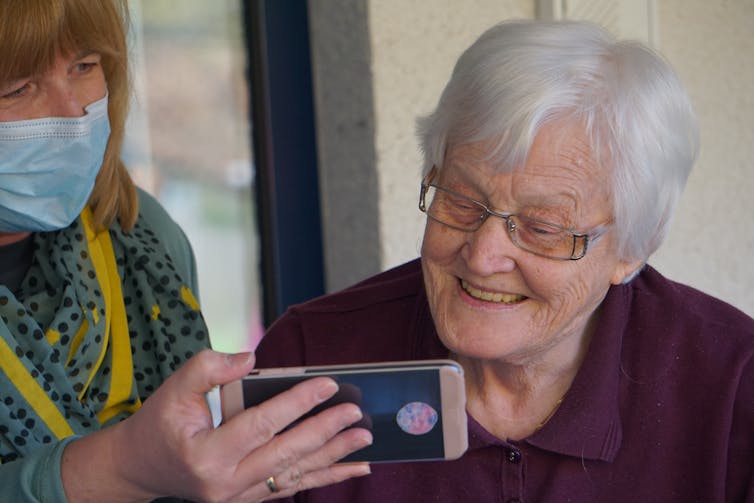
What We Found
During the 312 hours we spent observing 39 residents, we found a day in the life of a resident looks something like this:
waking up in the morning and getting ready for the day (with the help of personal care staff if necessary)
attending the dining room for breakfast and spending most of the morning in the common area or lounge room – perhaps participating in an activity run by the lifestyle staff at the facility – before returning to the dining room for lunch
after that, depending on whether there is an activity being organised, most will go back to their own rooms to recuperate before coming back to the dining room for dinner in the early evening.
We found social interactions peak at breakfast, lunch and dinner.
Across the day, residents
spent the greatest proportion of time (45%) in their own room
were alone 47.9% of the time
were inactive 25.6% of the time
were most likely to chat with other residents, followed by staff, then family
outside of meal times, residents had conversations in the common area or in their own rooms.
Overall, residents spent more than half their time being socially and physically active.
Over a third of their time was spent with another resident. Spending time with other residents was most likely to be associated with a higher quality of life.
We also found spending time with staff or too much time alone was linked to poorer quality of life.

Creating Opportunities For Socially Active Lives
Based on our research, here are three things aged care providers and governments can do to improve older Australians’ wellbeing:
1. Improve staffing
Staff shortages and time pressures are key reasons why residents spend little time with staff.
Including more activities chosen and assisted by residents in aged care facilities could help create new social opportunities between residents and strengthen existing ones.
2. Tailor Montessori programs to the aged care environment
Montessori programs create a collaborative approach filled with self-directed activities with hands-on learning and play. Activities include things like sorting and recognising objects, completing puzzles, and practising opening locks.
Montessori programs in small groups or led by family members would suit the smaller staff to resident ratios in many aged care centres. They would also help residents (including those with dementia) regain some independence, feel less bored or isolated and have a sense of purpose.
3. Change the physical environment and offer more afternoon activities
Changing the physical environment to accommodate for more social spaces would go a long way to help.
Increasing the number of activities in the afternoon would mean residents have more opportunities to socialise with each other, especially those who are busy with personal care routines in the mornings.
Doing Residential Aged Care Differently
After media reports and a royal commission highlighted the failings of Australia’s aged care system, it’s time to think differently about aged care.
Our study reveals residents can and do socialise, and that it can significantly improve people’s quality of life.
We must now find ways to change aged care environments and practices to create more social opportunities.![]()
Joyce Siette, Research Fellow, Western Sydney University and Laura Dodds, Research assistant, Macquarie University
This article is republished from The Conversation under a Creative Commons license. Read the original article.
A Rugby Trip Inspired William To Take Some Brave Steps
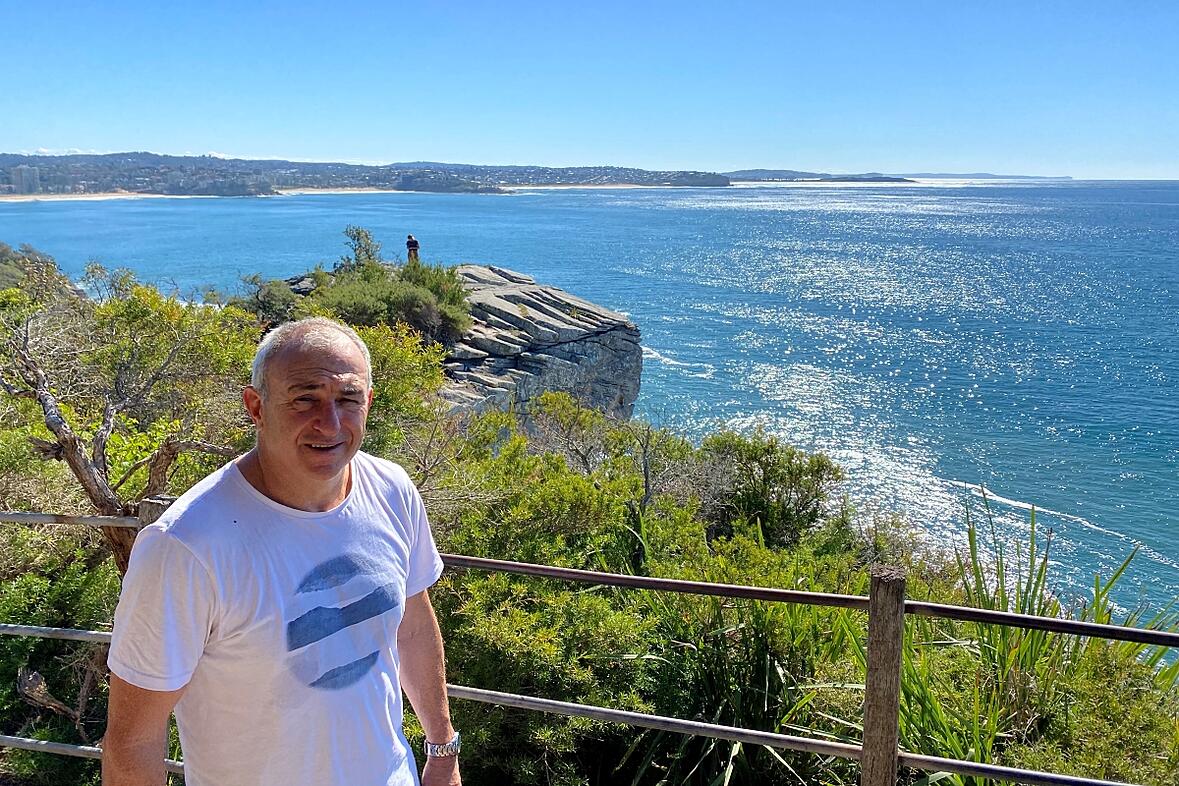

Cheaper Scripts For Millions
Pace As Important As 10,000 Steps For Health
- Every 2,000 steps lowered risk of premature death incrementally by 8 to 11 percent, up to approximately 10,000 steps a day.
- Similar associations were seen for cardiovascular disease and cancer incidence.
- A higher number of steps per day was associated with a lower risk of all-cause dementia
- 9,800 steps was the optimal dose linked to lower risk of dementia by 50 percent, however risk was reduced by 25 percent at as low as 3,800 steps a day
- Stepping intensity or a faster pace showed beneficial associations for all outcomes (dementia, heart disease, cancer and death) over and above total daily steps.
- Borja del Pozo Cruz, Matthew N. Ahmadi, I-Min Lee, Emmanuel Stamatakis. Prospective Associations of Daily Step Counts and Intensity With Cancer and Cardiovascular Disease Incidence and Mortality and All-Cause Mortality. JAMA Internal Medicine, 2022; DOI: 10.1001/jamainternmed.2022.4000
- Borja del Pozo Cruz, Matthew Ahmadi, Sharon L. Naismith, Emmanuel Stamatakis. Association of Daily Step Count and Intensity With Incident Dementia in 78 430 Adults Living in the UK. JAMA Neurology, 2022; DOI: 10.1001/jamaneurol.2022.2672
Daily Multivitamin May Improve Cognition And Possibly Protect Against Decline
We were on a global panel looking at the staggering costs of COVID – 17.7m deaths and counting. Here are 11 ways to stop history repeating itself
John Thwaites, Monash University; Liam Smith, Monash University, and Margaret Hellard, Burnet InstituteA global report released today highlights massive global failures in the response to COVID-19.
The report, which was convened by The Lancet journal and to which we contributed, highlights widespread global failures of prevention and basic public health.
This resulted in an estimated 17.7 million excess deaths due to COVID-19 (including those not reported) to September 15.
The report also highlights that the pandemic has reversed progress made towards the United Nations Sustainable Development Goals in many countries further impacting on health and wellbeing.
The report, from The Lancet COVID-19 Commission, found most governments were ill-prepared, too slow to act, paid too little attention to the most vulnerable in their societies, and were hampered by low public trust and an epidemic of misinformation.
However, countries of the Western Pacific – including East Asia, Australia and New Zealand – adopted more successful control strategies than most.
This had resulted in an estimated 300 deaths per million in the region (around 558 per million in Australia and 382 per million in New Zealand to September 12). This is compared with more than 3,000 per million in the United States and the United Kingdom.
The report also sets out 11 key recommendations for ending the pandemic and preparing for the next one.
Co-Operation Lacking
The report is the result of two years’ work from global experts in public policy, health, economics, social sciences and finance. We contributed to the public health component.
One of the report’s major criticisms is the failure of global cooperation for the financing and distribution of vaccines, medicines and personal protective equipment for low-income countries.
This is not only inequitable but has raised the risk of more dangerous variants.
The report highlighted the critical role of strong and equitable public health systems. These need to have: strong relationships with local communities; investment in behavioural and social science research to develop more effective interventions and health communication strategies; and continuously updated evidence.
11 Recommendations
The report made 11 recommendations to end the pandemic and prepare for future ones.
1. Vaccines plus other measures – establishing global and national “vaccination plus” strategies. This would combine mass immunisation in all countries, ensure availability of testing and treatment for new infections and long COVID, coupled with public health measures such as face masks, promotion of safe workplaces, and social and financial support for self-isolation.
2. Viral origins – an unbiased, independent and rigorous investigation is needed to investigate the origins of SARS-CoV-2, the virus that causes COVID-19, including from a natural spillover from animals or a possible laboratory-related spillover. This is needed to prevent future pandemics and strengthen public trust in science and public authorities.
3. Bolster the World Health Organization and maintain it as the lead organisation for responding to emerging infectious diseases. Give WHO new regulatory authority, more backing by national political leaders, more contact with the global scientific community and a larger core budget.
4. Establish a global pandemic agreement and strengthen international health regulations. New pandemic arrangements should include bolstering WHO’s authority, creating a global surveillance and monitoring system for infectious disease outbreaks. It would also include regulations for processing international travellers and freight under global pandemic conditions, and the publication of an annual WHO report on global pandemic preparedness and response.
5. Create a new WHO Global Health Board to support WHO decision-making especially on controversial matters. This would be composed of heads of government representing each of the six WHO regions and elected by the member states of those regions.
6. New regulations to prevent pandemics from natural spillovers and research-related activities and for investigating their origins. Prevention of natural spillovers would require better regulation of domestic and wild-animal trade and enhancement of surveillance systems for pathogens (disease-causing micro-organisms) in domestic animals and humans. The World Health Assembly should also adopt new global regulations on biosafety to regulate international research programs dealing with dangerous pathogens.
7. A ten-year global strategy by G20 (Group of Twenty) nations, with accompanying finance, to ensure all WHO regions, including the world’s poorer regions, can produce, distribute, research and develop vaccines, treatments and other critical pandemic control tools.
8. Strengthen national health systems based on the foundations of public health and universal health coverage and grounded in human rights and gender equality.
9. Adopt national pandemic preparedness plans, which include scaling up community-based public health systems, investment in a skilled workforce, investment in public health and scientific literacy to “immunise” the public against dis-information, investment in behavioural and social sciences research to develop more effective interventions, protection of vulnerable groups, establishment of safe schools and workplaces, and actions to improve coordinated surveillance and monitoring for new variants.
10. Establishment of a new Global Health Fund where – with the support of WHO – there is increased and effective investment for both pandemic preparedness and health systems in developing countries, with a focus on primary care.
11. Sustainable development and green recovery plans. The pandemic has been a setback for sustainable development so bolstering funding to meet sustainability goals is needed.
Unlock A New Approach
To improve the world’s ability to respond to pandemics we need to unlock a new approach. The key component to any meaningful transformation is to collaborate and work towards a new era of multilateral cooperation.
Governments in Australia, Aotearoa New Zealand and elsewhere have talked about “building back better”. We need to take the lessons learnt from the failures of the past few years and build a stronger framework. This will not only help reduce the dangers of COVID-19 but also forestall the next pandemic and any future global crisis.
By reassessing and strengthening global institutions and co-operation, we can build and define a more resilient future.
Chris Bullen, Professor of Public Health, University of Auckland, co-authored this article and The Lancet COVID-19 Commission report on which it was based.![]()
John Thwaites, Chair, Monash Sustainable Development Institute & ClimateWorks Australia, Monash University; Liam Smith, Director, BehaviourWorks, Monash Sustainable Development Institute, Monash University, and Margaret Hellard, Adjunct Professor, Monash University; Associate Director and Head, Centre for Population Health, Burnet Institute
This article is republished from The Conversation under a Creative Commons license. Read the original article.
Benefits Of The Environment To Health. A Literature Review Of Health Benefits Derived From 3 Ecosystem Services: Air Filtration, Local Climate Regulation, And Recreation
- air filtration – the filtering of air-borne pollutants by ecosystems, in particular by plants,
- to mitigate harmful effects of pollution
- local climate regulation – the regulation of ambient temperatures by plants and water bodies to improve local living conditions
- recreation-related services – the qualities of ecosystems that allow people to use and enjoy the environment, such as through providing opportunities for physical activity or other passive recreational pursuits.
- air filtration is associated with improved respiratory outcomes (such as for asthma) and decreases in mortality. Positive maternal and perinatal outcomes are areas being increasingly researched
- local climate regulation is associated with decreases in both all-cause mortality, and in hospitalisations due to heat
- recreation-related services are associated with increases in both physical activity, and in subjective mental wellbeing associated with recreation in nature.
Replacing Band-Aid Wound Solutions Could Save Lives And Millions In Health System Costs: AMA
- A Commonwealth-funded wound consumables scheme to subsidise the cost of dressings and other consumables provided in general practice for patients with chronic wounds.
- The implementation of a stepped model of care for the management of chronic wounds, with improved access to other healthcare professionals involved in wound care to form GP-led healthcare teams.
- Three new Medicare items to facilitate the stepped model of care, including a Medicare item to allow trained practices nurses, Aboriginal and Torres Strait Islander Health Practitioners or Aboriginal Health Workers to provide short-term treatment.
- Implementation of a national education and training program on the prevention and management of chronic wounds, with access to the consumables scheme and extra Medicare support linked to completion of this education and training.
- Improved coordination of wound care initiatives in the sector under a national program to reduce duplication of effort.
Social Housing Temperatures In NSW Exceed Health And Safety Limits: Study
 Many residents in social housing in New South Wales can experience alarming levels of winter underheating and summer overheating in their homes that do not meet standards for comfort and health, according to UNSW Sydney-led research funded by the Department of Planning and Environment and CRC for Low Carbon Living.
Many residents in social housing in New South Wales can experience alarming levels of winter underheating and summer overheating in their homes that do not meet standards for comfort and health, according to UNSW Sydney-led research funded by the Department of Planning and Environment and CRC for Low Carbon Living.M4-M5 Link To Be Renamed
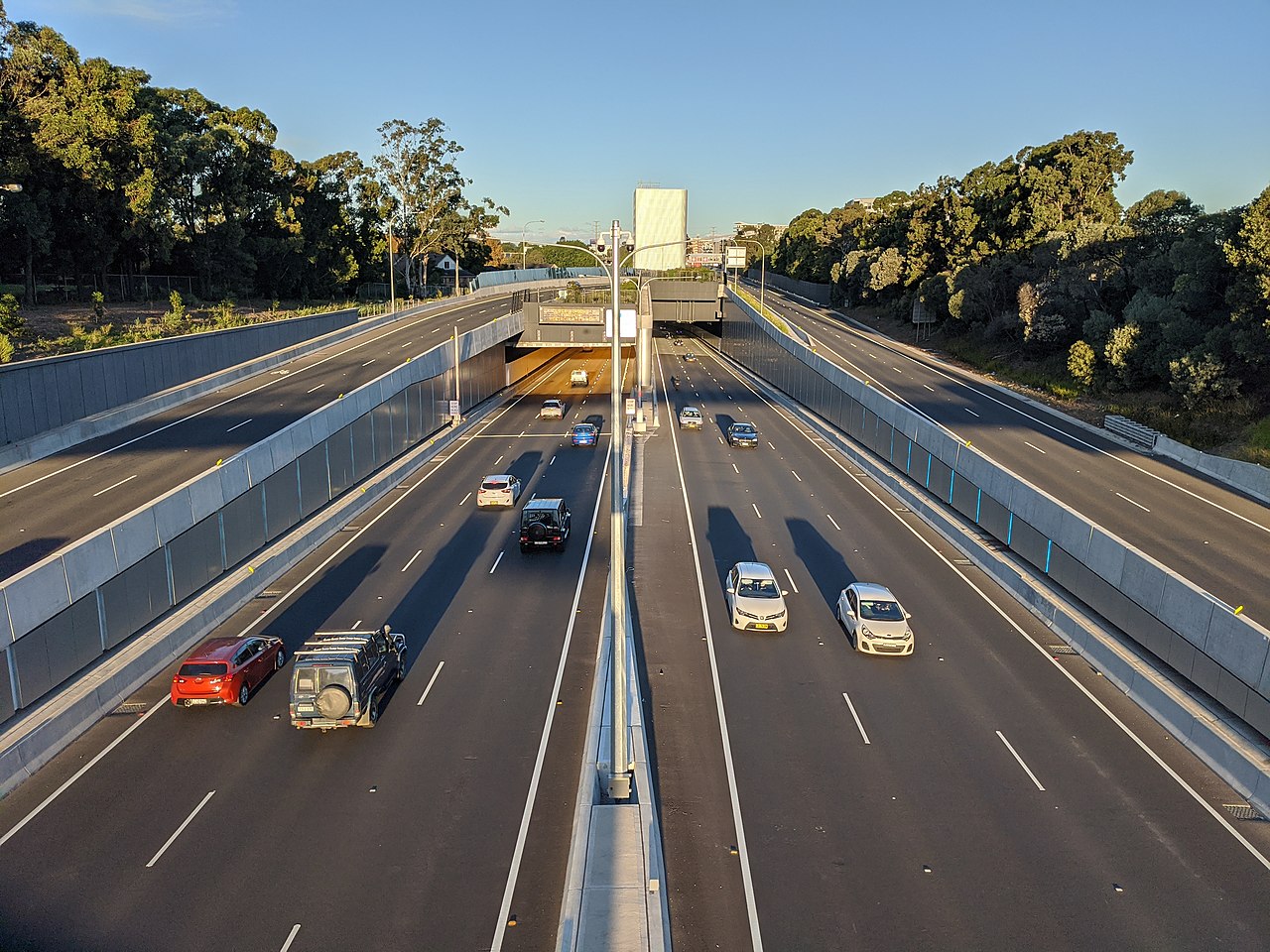
Emergency Department Walk Outs Show Need For Ratios Nurses Association States
Government States Hospitals Continue To Perform Well Despite COVID-19 And Flu Outbreaks
Researchers Identify How Science Can Help Cities And Companies To Operate Within Earth System Limits
Chemical Fingerprints Could Land The Biggest Catch: Seafood Fraudsters
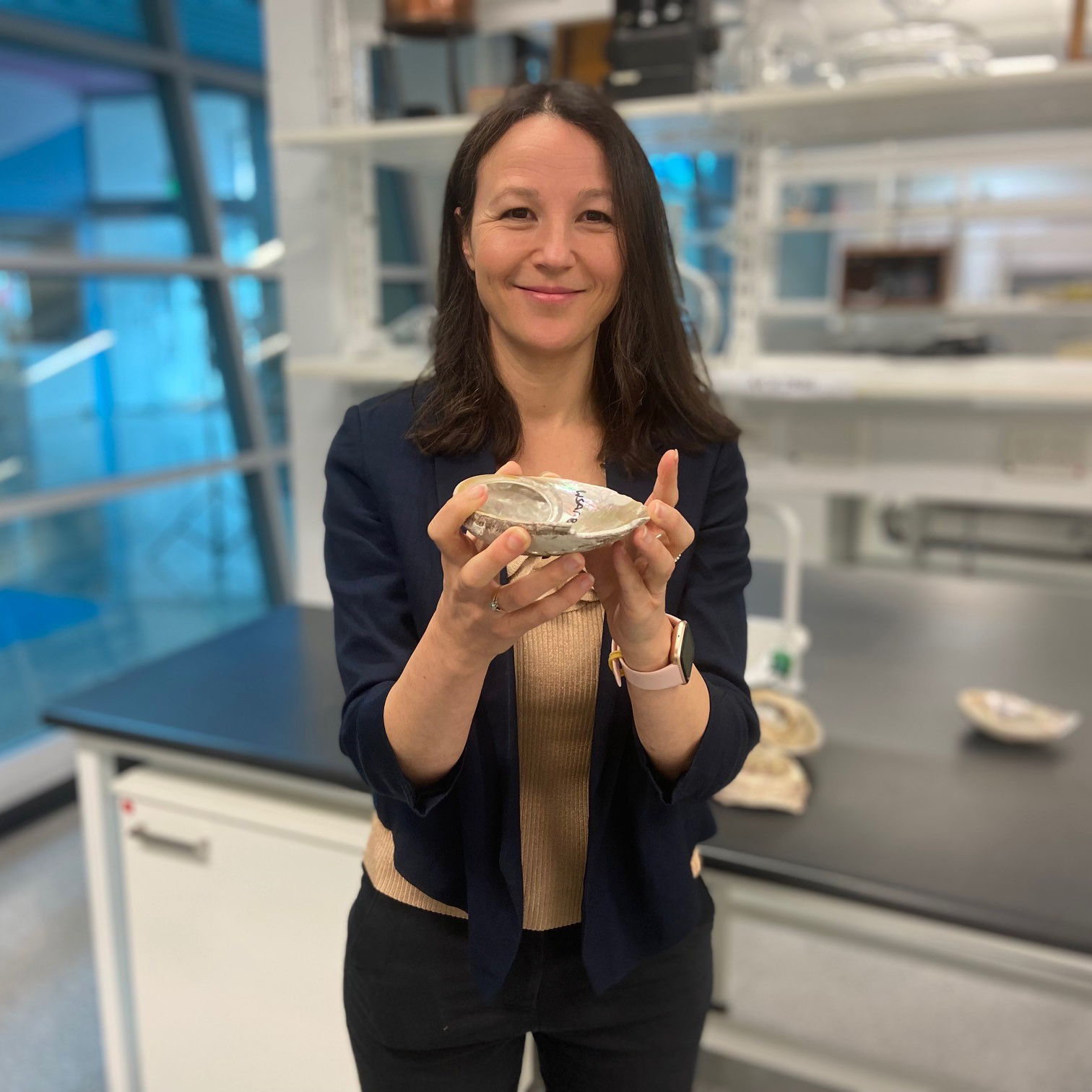
Australian Vets And Pets To Reap Benefits From New Drug To Treat Common Infection
Mucosal Antibodies In The Airways Protect Against Omicron Infection
Tropical Insects Are Extremely Sensitive To Changing Climates
The Blood Stem Cell Research That Could Change Medicine Of The Future
Disclaimer: These articles are not intended to provide medical advice, diagnosis or treatment. Views expressed here do not necessarily reflect those of Pittwater Online News or its staff.
